Luxury magazine: June 2022
Designer Ozwald Boateng, Switzerland's thermal baths and Michael Chow's return to canvas
By Selina Denman
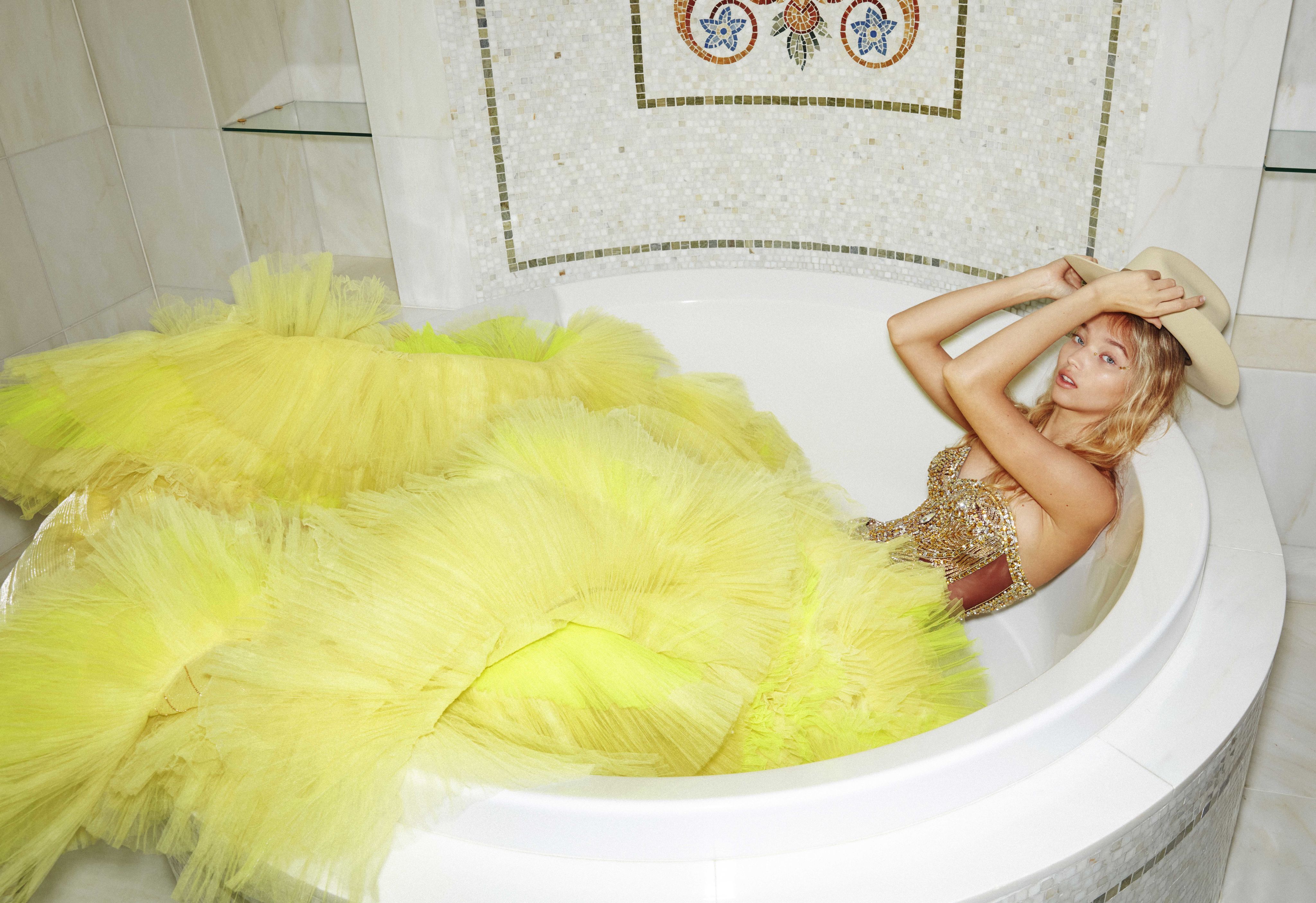
'Our desire for escape has intensified'
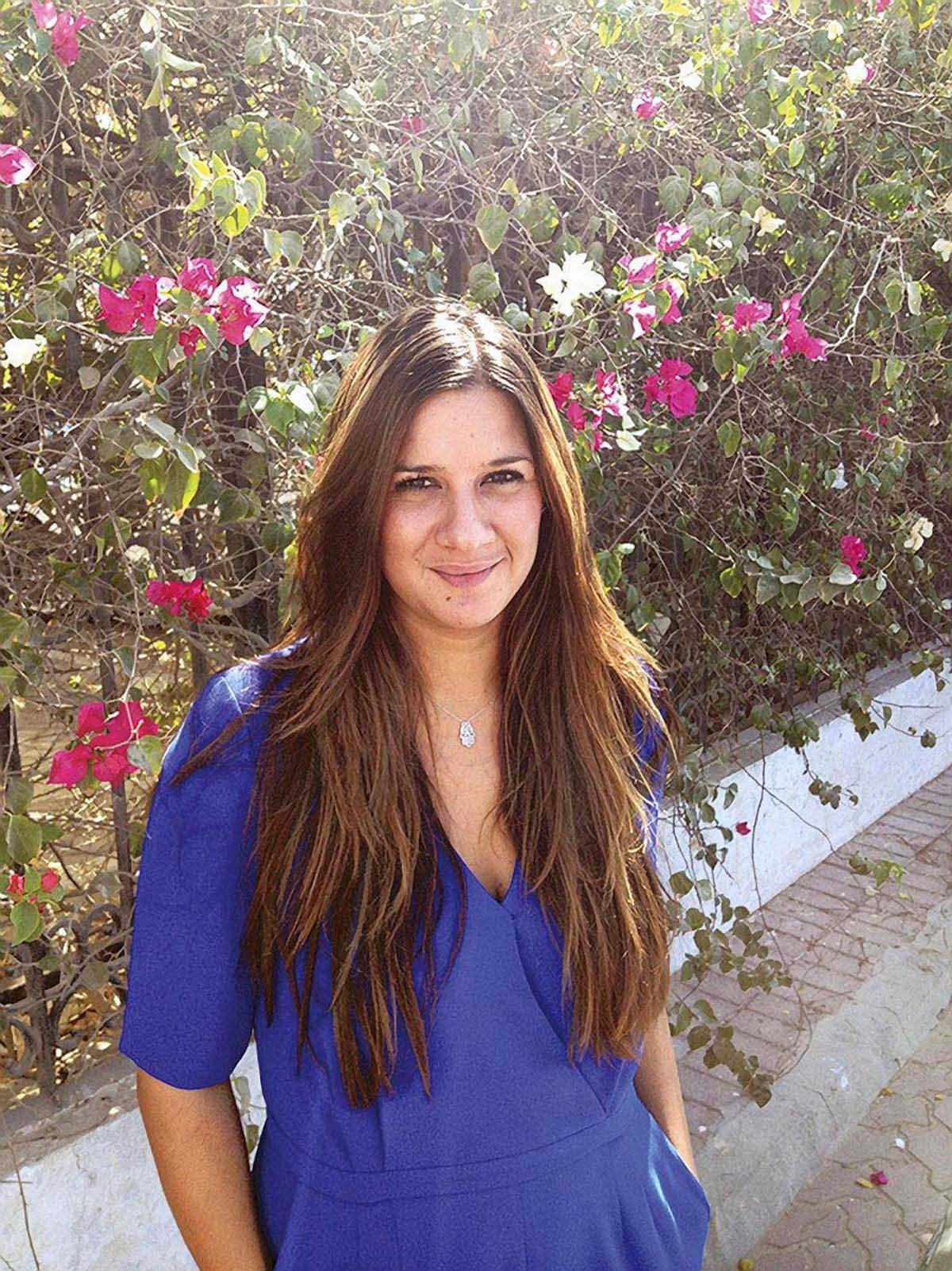
What does escape mean to you?
For some, it is literal – the desire to leave a certain place or a specific set of circumstances. The UAE in summer, for example. So in this, our dedicated escape issue, we offer ideas for doing just that.
For a start, we present a selection of hotel bathtubs with world-class views. Whether you are looking out over the plains of the Masai Mara, the olive groves of Greece’s Peloponnese or the turquoise waters of the Maldives, we guarantee that a soak in these tubs will serve as the ultimate escape.
In this pandemic-ridden era, our desire for escape has intensified. We all got a taste of what it was like to not move freely or travel widely, and now that things have eased, there’s a whole load of pent-up demand to work through. So Sulaiman Hakemy charts his retreat to the tiny Swiss village of Vals, famed for its restorative thermal baths. As he soaks in contemplative silence and enjoys the curative effects of the waters at Therme Vals, he reflects on their ability to wash away the world’s woes.
For others, escape requires a complete retreat from society. Which is what the $4.99 million property in our Hot Property section offers. Built into a rocky outcrop at the edge of a mountain in Colorado, with views of forest-filled valleys and snow-capped mountains, it is the ideal acquisition for someone looking to leave it all behind. Eight bedrooms, a games room, sunroom, sunken hot tub and home cinema mean you’ll be able to entertain yourself indefinitely, while the stunning views will provide infinite amounts of distraction.
Fashion can also act as a form of escape, particularly when it comes in the form of British designer Richard Quinn’s bold prints and vibrant colourways. Our conversation with the young designer is timely, given Queen Elizabeth II’s recent platinum jubilee. Quinn hit the front-row jackpot in February 2018 when the queen attended his first official London Fashion Week show, and afterwards she presented him with the inaugural Queen Elizabeth II Award for British Design. This is the only fashion show she has ever attended, and Quinn admits it was something of a surreal experience.
Self care, too, can provide an escape for those unable to physically remove themselves. Enter the science-led products offered by The Skincare Edit, a new online resource from Abu Dhabi resident Claire Miller. Time invested in optimising your wellness is always time well spent.
And, if all else fails, you can get dressed up for a party of one. You’ll find tips in our fashion shoot.
Selina Denman, editor
Taking the waters
Sulaiman Hakemy travels to the tiny Swiss village of Vals to sample the curative effects of its thermal springs
In 1826, a pharmacist from the small alpine city of Chur, in eastern Switzerland, undertook a day-long journey through the mountains to the tiny village of Vals.
For 300 years, the 30°C water bubbling out of St Petersquelle, Vals’s thermal spring, had been the subject of animated conversation in the local apothecaries of the surrounding valleys.
It had a slightly sulphury taste and a textured feel along the tongue, suggesting an unusually high mineral content. The pharmacist from Chur had come to do the first-ever chemical analysis on the spring water, hoping to find out why his colleagues believed it had some sort of healing powers.
For millennia, people have sought to escape disease and plague by travelling, sometimes huge distances, to “take the waters”. Thermal springs, gushing with hot, mineralised water from the depths of the Earth, were thought to have a curative effect – if not for the body then most certainly for the mind.
We live now, of course, in a time of plague – or at least, at the tail end of it. More than two years on from the first case of coronavirus, we have a pretty good handle on how to recover from it. But how do we recover from the pandemic? Not on a policy level – navigating a way back to a normal world is for politicians and experts to figure out. No, how do you and I, individuals afflicted, some of us in body but certainly all of us in mind, recover from having lived through so many months in pandemic mode? We are still figuring that one out.
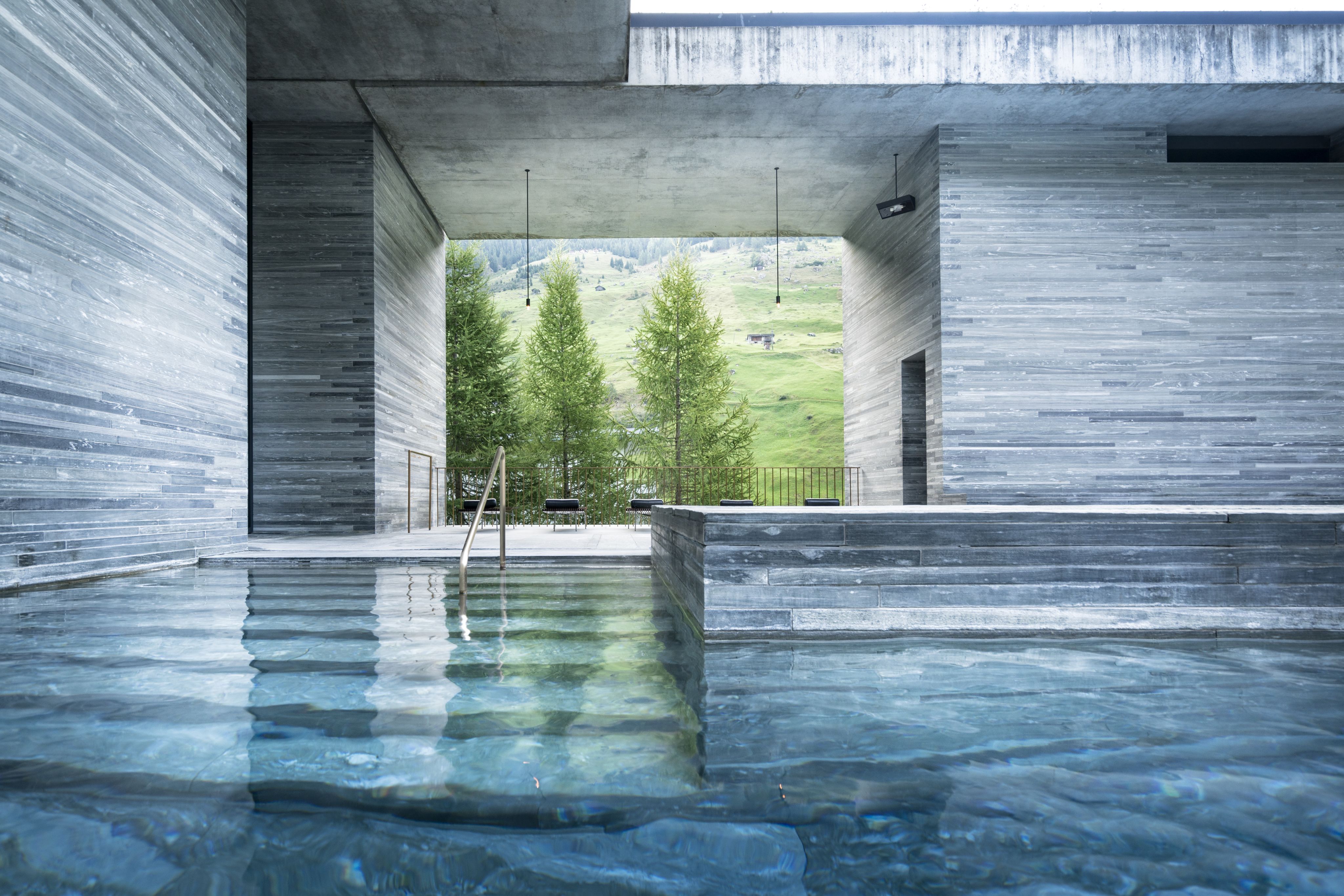
The baths at Therme Vals. Photos: 7132 Hotel & Global Image Creation
The baths at Therme Vals. Photos: 7132 Hotel & Global Image Creation
In my search for curative effects, I travelled to Vals to take St Petersquelle’s waters for myself. I was invited to stay at the 7132 Hotel, to which Therme Vals, a bath house like no other, is attached. I took in the unbeatable scenery of the mountains of Graubunden, Switzerland’s largest and proudest canton, from the balcony of my spa deluxe suite, and dined at the hotel’s Michelin-starred restaurant, where I slowly sipped on aged water.
I soaked in contemplative silence with other bathers in pools housed in different stone chambers at varying temperatures – not for hours, but for nearly two days straight. I was drenched in the hospitality of the hotel staff, which included town locals, graduates of the world’s finest hotel schools and refugees who felt they had been given the break of a lifetime, and I was consistently entertained by their efforts to balance a very Swiss desire to hew rigidly to the rules with the greatest hallmark of any five-star hotel: the need to bend those rules to the guest’s whims.
We are told getting over this pandemic will mean getting regular boosters. Well, there are boosters, and then there are boosters. Vals is the latter.
I travelled across Graubunden to reach it. The canton’s magnificent red train, the Rhatischebahn, flows into nearly every major valley like a glacier. It takes you from Landquart, the main interchange coming in from Zurich, down to Chur, the cantonal capital. From there, another train takes you to the toy town of Ilanz, weaving over steel bridges and along alpine rivers, hugged by mountains that shoot right into the sky.
From Ilanz, it’s a slightly harrowing 40-minute bus journey, snaking along single-lane roads at the edges of cliffs in a way that constantly evokes mortality. But again, Graubunden is a dreamscape. There are worse places to go down.

The exterior of the 7132 Hotel
The exterior of the 7132 Hotel
You would miss 7132 if you didn’t know what you were looking for. It, along with an earlier bath house, was built in the 1960s by a German entrepreneur who wanted to exploit Graubunden’s only thermal spring. The hotel retains its 1960s, once-ultra-modern, now-ultra-ordinary façade – I thought at first it was an apartment block. When Swiss architect Peter Zumthor was commissioned by the town to redesign the complex, he retained the hotel’s main building and focused instead on the baths.
After getting off the bus from Ilanz, I made the mistake of following Google Maps, which led me to a set of about a thousand outdoor stairs leading from the main thoroughfare to 7132’s service entrance.
You can avoid this error by arranging for the hotel to pick you up from the bus stop in one of its slick black Mercedes vans. That will deliver you up a sweeping ramp to the much more elegant main entrance: a discrete black door under an enormous white, curvy facade designed by the US architect Thom Mayne. It looks like a smooth shelf of snow projecting over the mountainside. You can also arrange transport by helicopter – 7132 is the only hotel in Switzerland with its own fleet. For guests staying in the hotel’s sprawling penthouse, chopper pickup is complimentary.
Having had their last facelift 25 years ago, 7132’s interiors are at an awkward age in the world of spa hotels – a little too old to be contemporary, and a little too young to be vintage. It’s 1990s stylish. Shiny grey carpet and black-painted walls and ceilings are the vibe, with the occasional splash of red. The check-in area is a small, ill-defined bit of extra space between the restroom, the lifts and the bar and lounge.
But that’s not why you’re here. Zumthor knew that, and even the staff know it. In nearly every interaction that I had with the concierge, he seemed inordinately concerned that I was not at that very moment soaking in the bath house. Therme Vals is as much a site of pilgrimage for architecture buffs – it was awarded a Pritzker Prize, architecture’s Nobel – as it is one for those who need to convalesce. It is a collection of austere rooms, built from primordial stone, planted into a mountainside and brass-piped straight into the thermal spring.
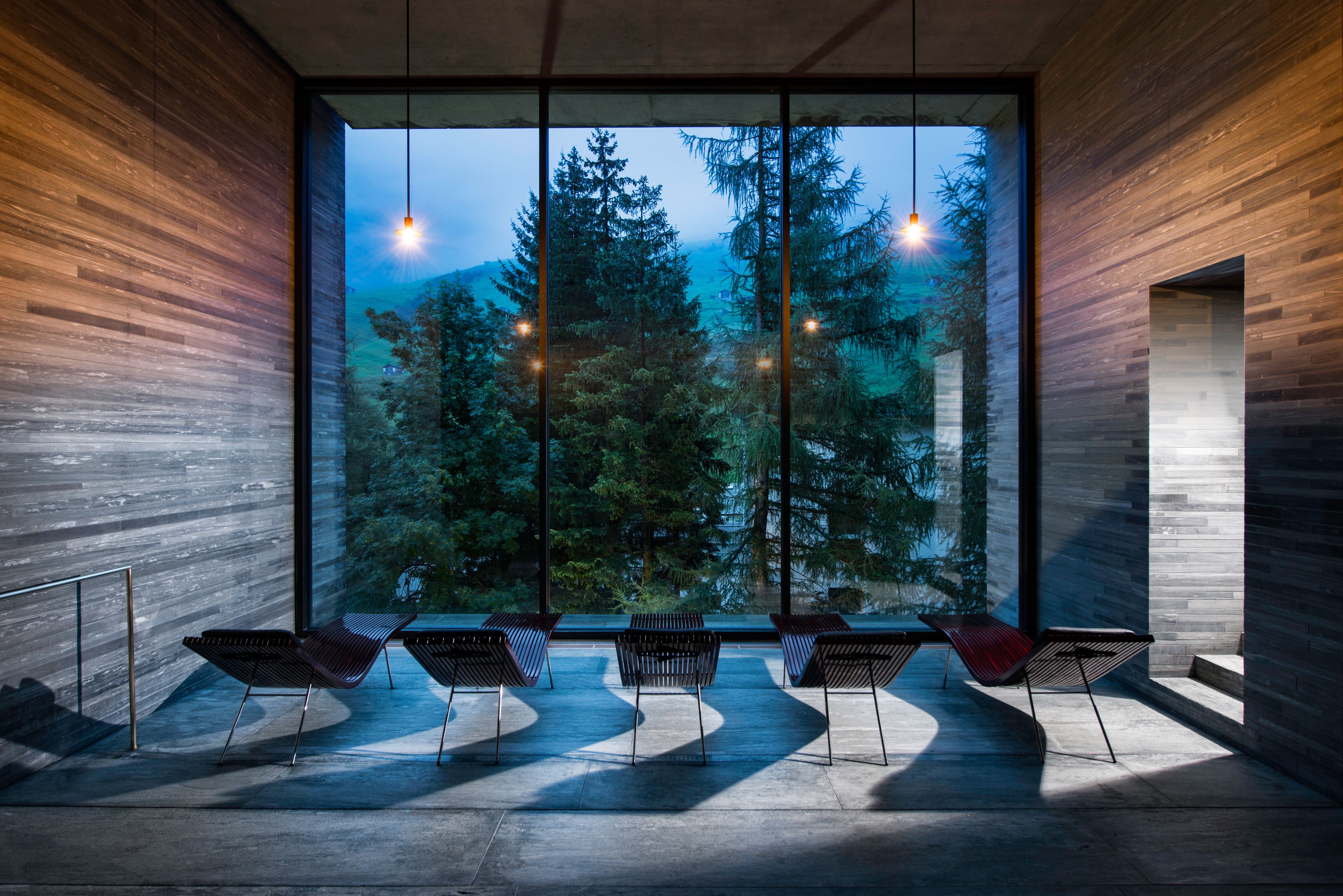
Mountain views from the baths
Mountain views from the baths
It is one of the most Instagrammable places you will ever go, but there is not an influencer in sight, and you will never have the selfies to prove it. There are no cameras allowed in this spa, because, as Zumthor puts it: “This is no funfair.”
Bathing at Therme Vals is not taken lightly. The rooms are arranged in monastic fashion – the Vals stone from which the walls are made is ever-present, all-encasing. Bathers wander into these rooms and wade into the pools within – each of them unique in some way – in a deliberate manner. They wallow for a while, their bodies soothed but their minds in contemplation, meditating on stone and water.
Today, “Valser water” is a popular brand of bottled water in Switzerland. The sole bottling plant, which takes all of the water from St Petersquelle that isn’t dispatched into Therme Vals, was bought by Coca-Cola in 2002. The brand has recently been marketed in the US as the company’s “Swiss secret”. The secret, really, is calcium. One litre of Valser water supplies half of the amount the average adult needs in their daily diet, and it does this while containing a low amount of sodium (an unusual quality for highly mineralised waters).
To get to this level of mineralisation, the water starts as rain that falls atop the peak of the Piz Aul, the large mountain that stands watch over Vals. From the peak, it takes anywhere between two and 200 years to work its way into Piz Aul’s heart, filtering past billions of tonnes of quartzite and slate through little cracks and crevices, before re-emerging through the spring. For those who want to imbibe the stuff in its purest form, one of the pipes at Therme Vals, found above the Drinking Stone, supplies it straight from the mountain into your cupped hands.
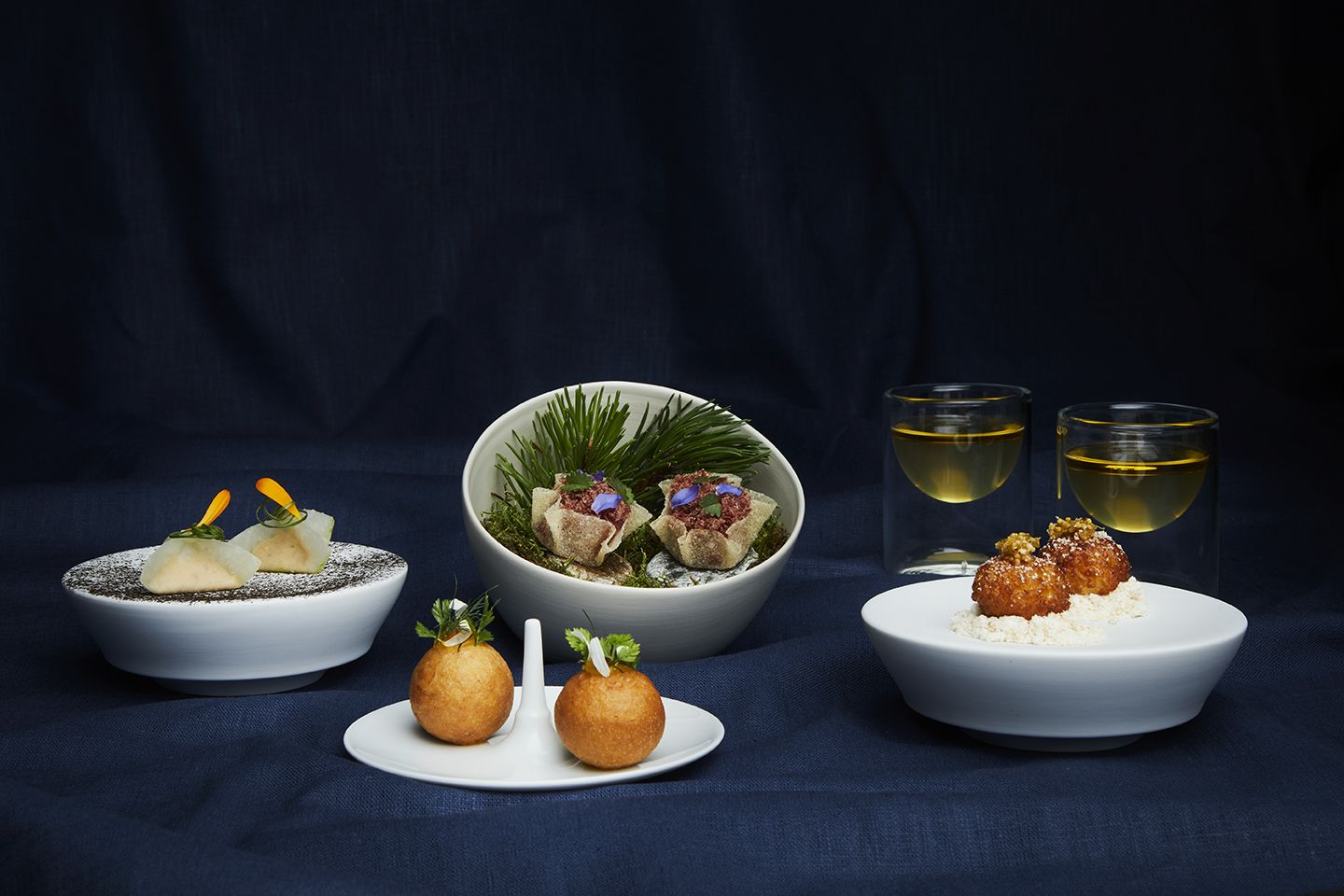
Food at Silver is served with a side of aged water
Food at Silver is served with a side of aged water
But for those who prefer a sense of ceremony, that can be found at Silver, 7132’s premier restaurant, where a glass of it will be served to you with special reverence in a stone cup, as a palette cleanser during dinner.
The chefs at Silver, led by the German-born, 30-something Mitja Birlo, are a young crew of men and women, a few of them with piercings and sleeve tattoos. Several times a week, they forage the surrounding mountains for fresh ingredients, and sit down to run through ideas for refreshing the menu.
When the water arrived, Ali Karimi, the staff member who brought it out, explained its provenance. The particular artery of the St Petersquelle spring network that carried it down the mountain took about 25 years to get from the peak to the collection point.
You don’t encounter many “Alis” in Vals. As a journalist coming from the Middle East, seeing his name badge was a pleasant surprise, so I asked him where he was from.
Twenty-five years ago, when the water in my glass first rained on to Piz Aul, when Zumthor had only just completed his work on Therme Vals, Ali was a young boy in the small town of Behsud, in the centre of Afghanistan. When he tells me this I am left completely speechless for a moment, because it is the same town where my own grandfather was born. The civil war had only just ended, but Taliban rule had just begun. Life for Ali and his family, who are members of Afghanistan’s heavily persecuted Hazara community, was precarious at best. Even as he grew into a man, it hardly got better.
In 2014, when Ali was in his early twenties and the US war in Afghanistan was at a crescendo, he decided to make his way to Europe, overland through Iran and Turkey, as thousands of other Afghans were doing at the time. And like so many of our fellow countrymen, he found himself stuck in a makeshift camp on the Greek islands.
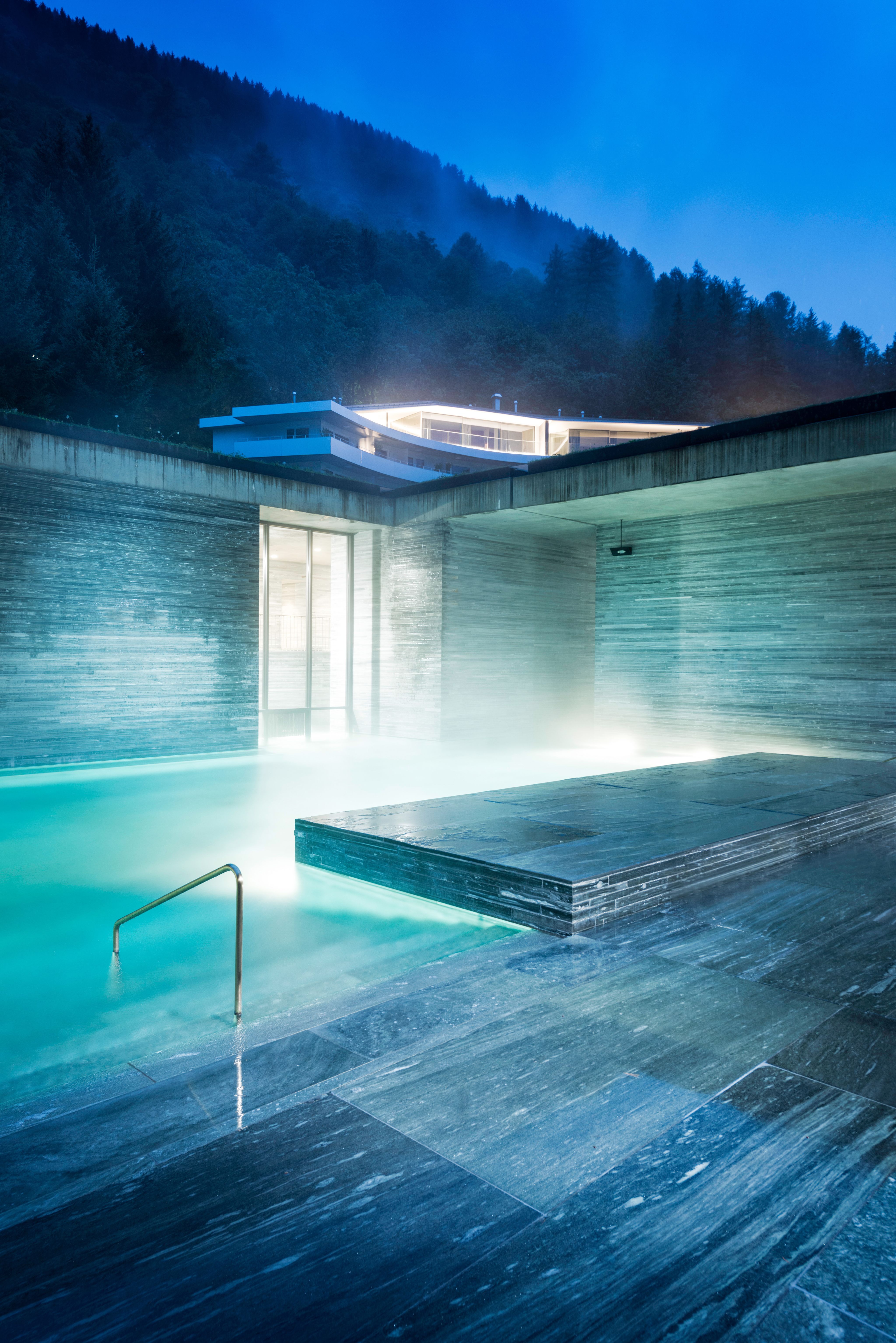
Each of the pools is unique
Each of the pools is unique
He decided to try his hand in Switzerland after hearing from a friend that a hotel in Vals, which turned out to be the 7132, was looking for a dishwasher. Although Ali was new to Switzerland and it was not yet certain whether he would even be able to stay, when he showed up at the door, the hotel decided to give him a shot. After a while, he left for a job at another restaurant, but when Silver had an opening a couple of years ago, this time to work as a host and to train on the chef track, they rang him up and asked him to come back.
Now, Ali forages with the other chefs, participates in menu planning and is the manager for Silver’s breakfast offering. When I ask him if he gets lonely being the only Afghan in Vals, he says he misses home, but it’s balanced by his new-found happiness. Years of war had an impact, but in Vals, he can finally focus on recovering.
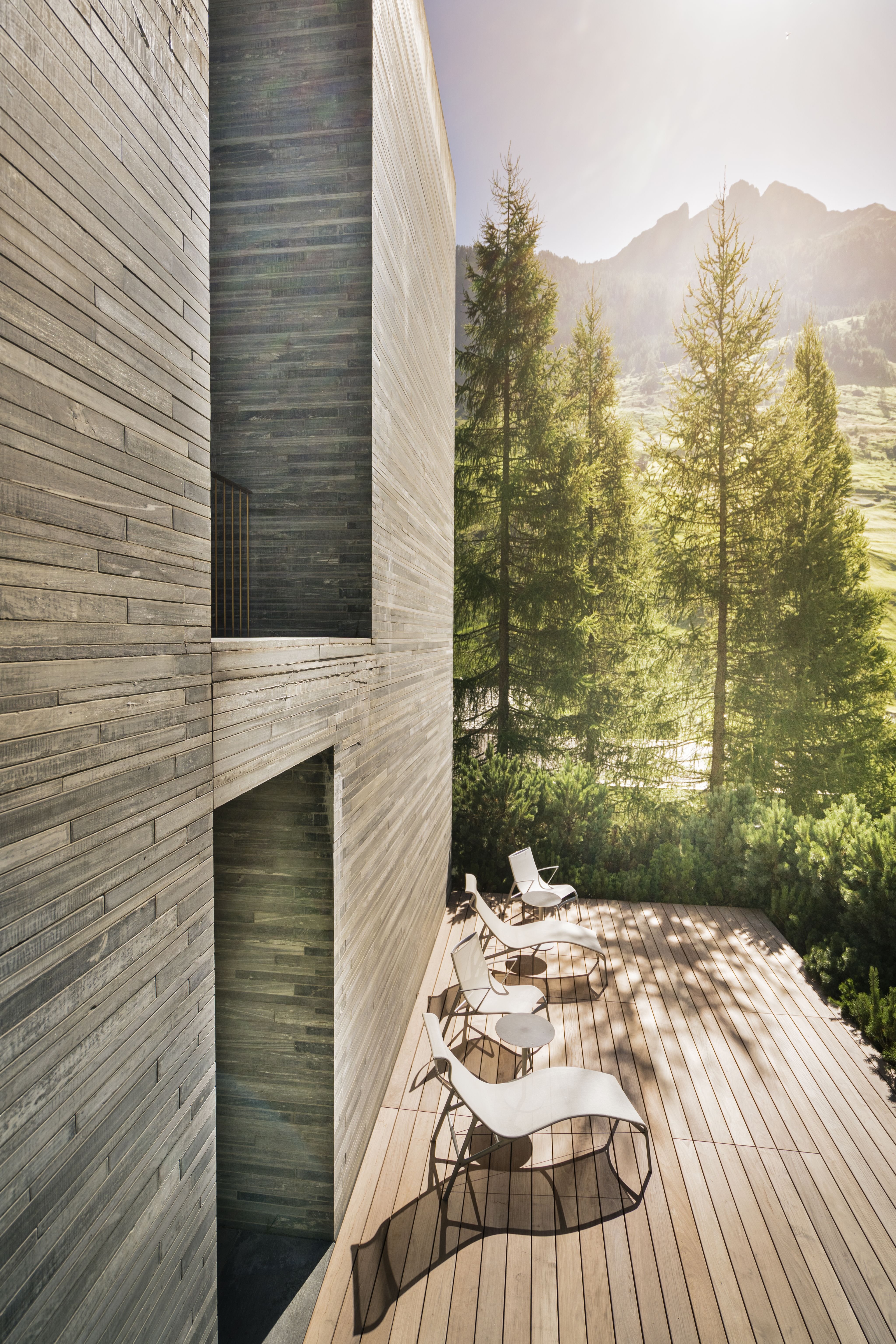
An outdoor area at the thermal baths
An outdoor area at the thermal baths
Dinner at Silver, which carries not one, but two Michelin stars, is a four-hour affair, with nine courses. Each is presented in almost-sculptural form on sparkling plates that act as a white, porcelain canvas for whatever the chefs have spent the past 25 minutes preparing. When they bring it out, a member of the kitchen staff comes over and explains not only the ingredients, but also the philosophy behind the dish you’re about to enjoy.
Early the following morning, just after day break, I took the lift from the hotel down for one last visit to Therme Vals. I took my robe off and opened the large glass door leading on to the bath house’s outdoor terrace, pushing past a blast of icy wind to make my way to the Ausbaden, the terrace’s large, open-air pool.
There, I got my final lesson in the ways of water. I experienced the stuff in all its forms at once. I soaked in it at 36 degrees and watched it dance as it rose from the surface as steam, tossed around by the dense, minus-eight-degree air. I saw it powdering the mountains in front of me, and I felt it melt from ice back to liquid under my fingers as they gripped the pool’s edges.
I looked up at the sky and saw it, bunched up there in a thickening cloud. At some point, the cloud would break into rain, wash over the top of the mountain and make its way down through the nooks and crannies of the ancient stone. And in a couple of years, or maybe a generation, or maybe 10, it would find its way back up. And people would come from around the world, as I did, to marvel at it, to taste it, to bathe in it, and to wash whatever else was happening in the world out of their minds.

Late check-out
Escape the everyday stresses of life in sequins,
decadent embroidery and lashings of tulle.
Just don’t forget the balloons
Photographer: Mehmet Erzincan
Fashion director: Sarah Maisey
Model: Milena at Art Factory
Make-up: Gulum Erzincan at Art Factory
Make-up assistant: Anna Boldina
Shot on location at Palazzo Versace Dubai
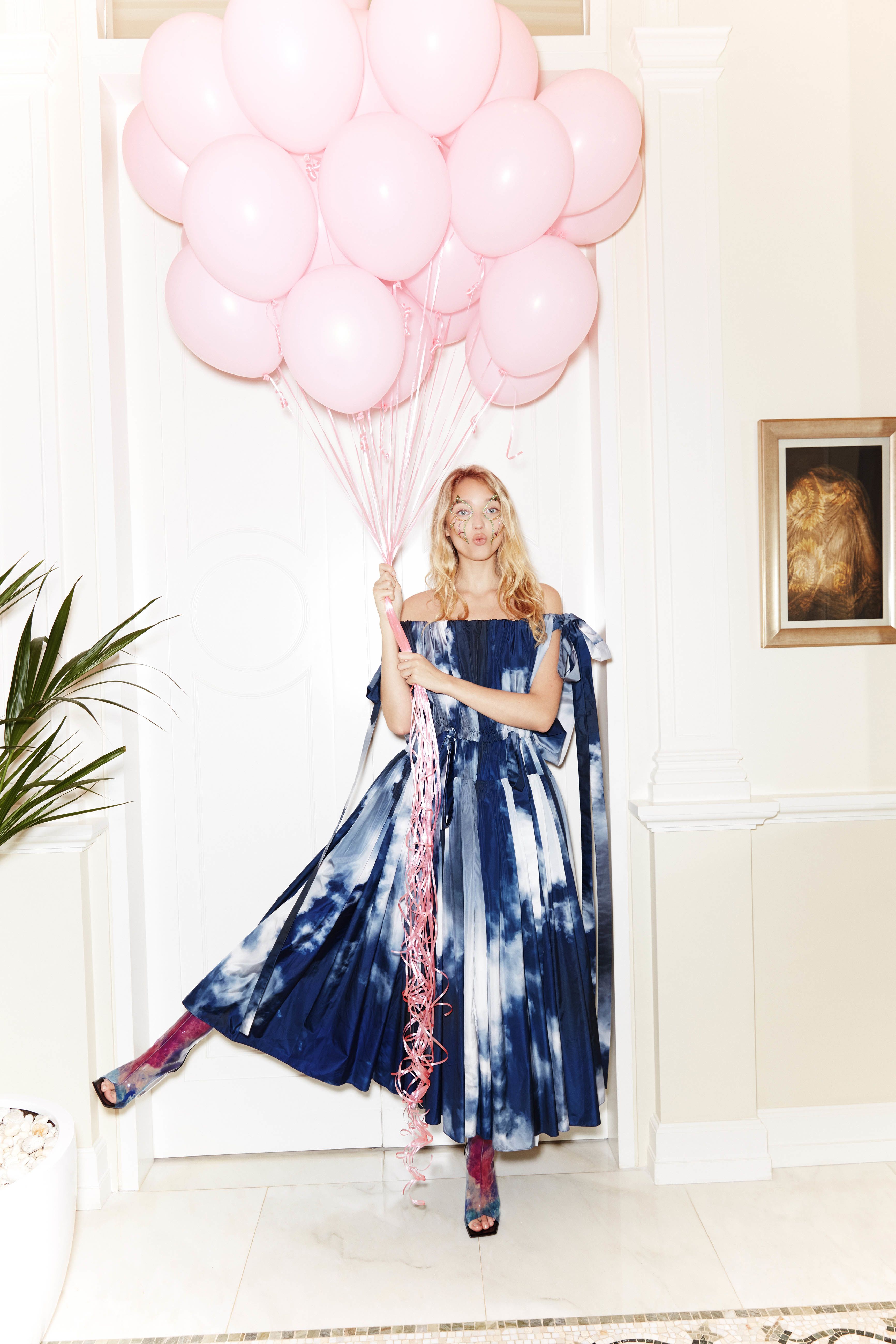
Dress, Dh25,525, Alexander McQueen. Boots, Dh6,100, Giuseppe Zanotti
Dress, Dh25,525, Alexander McQueen. Boots, Dh6,100, Giuseppe Zanotti
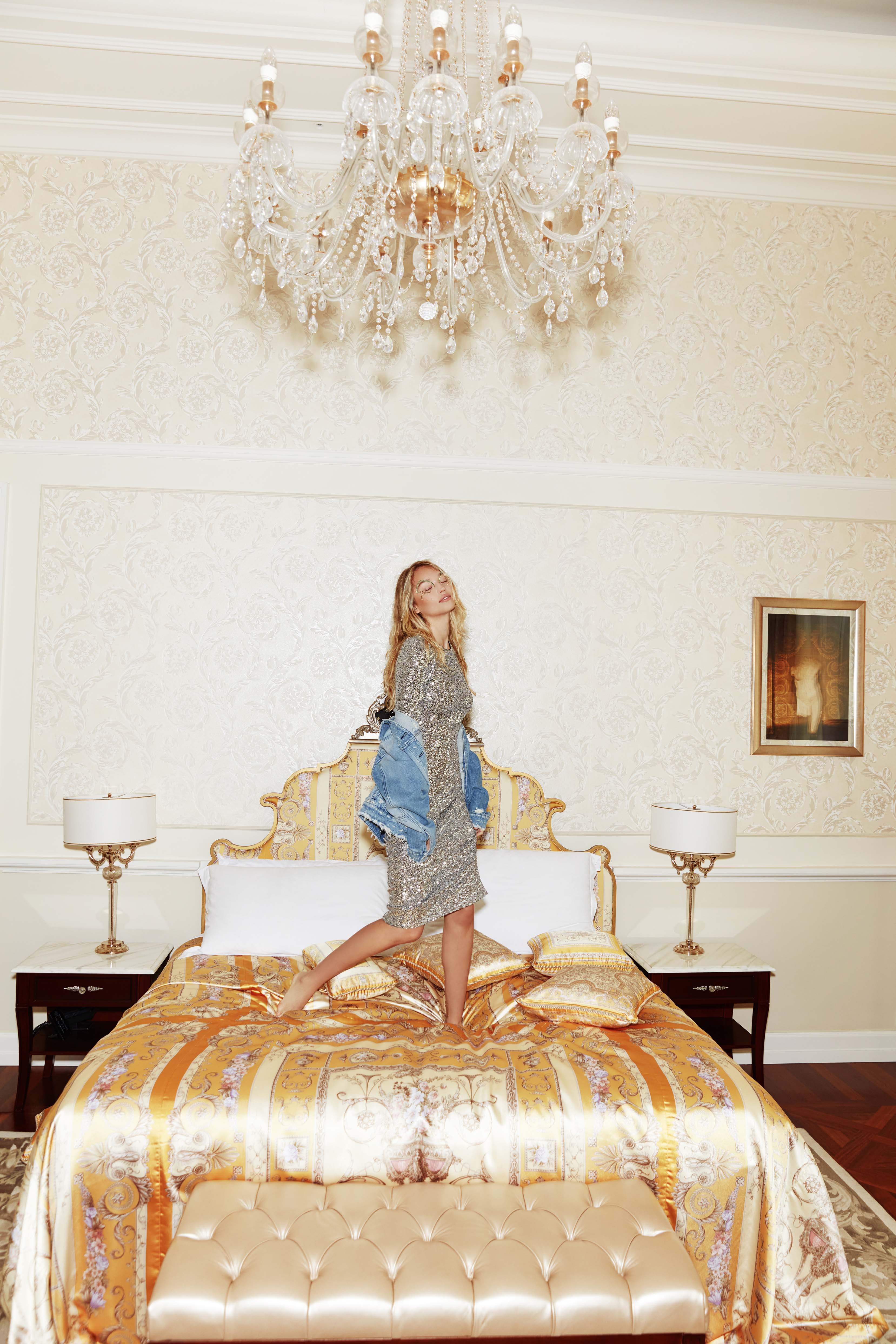
Dress, Dh9,300; and jacket, Dh4,800, both from Dolce & Gabbana
Dress, Dh9,300; and jacket, Dh4,800, both from Dolce & Gabbana
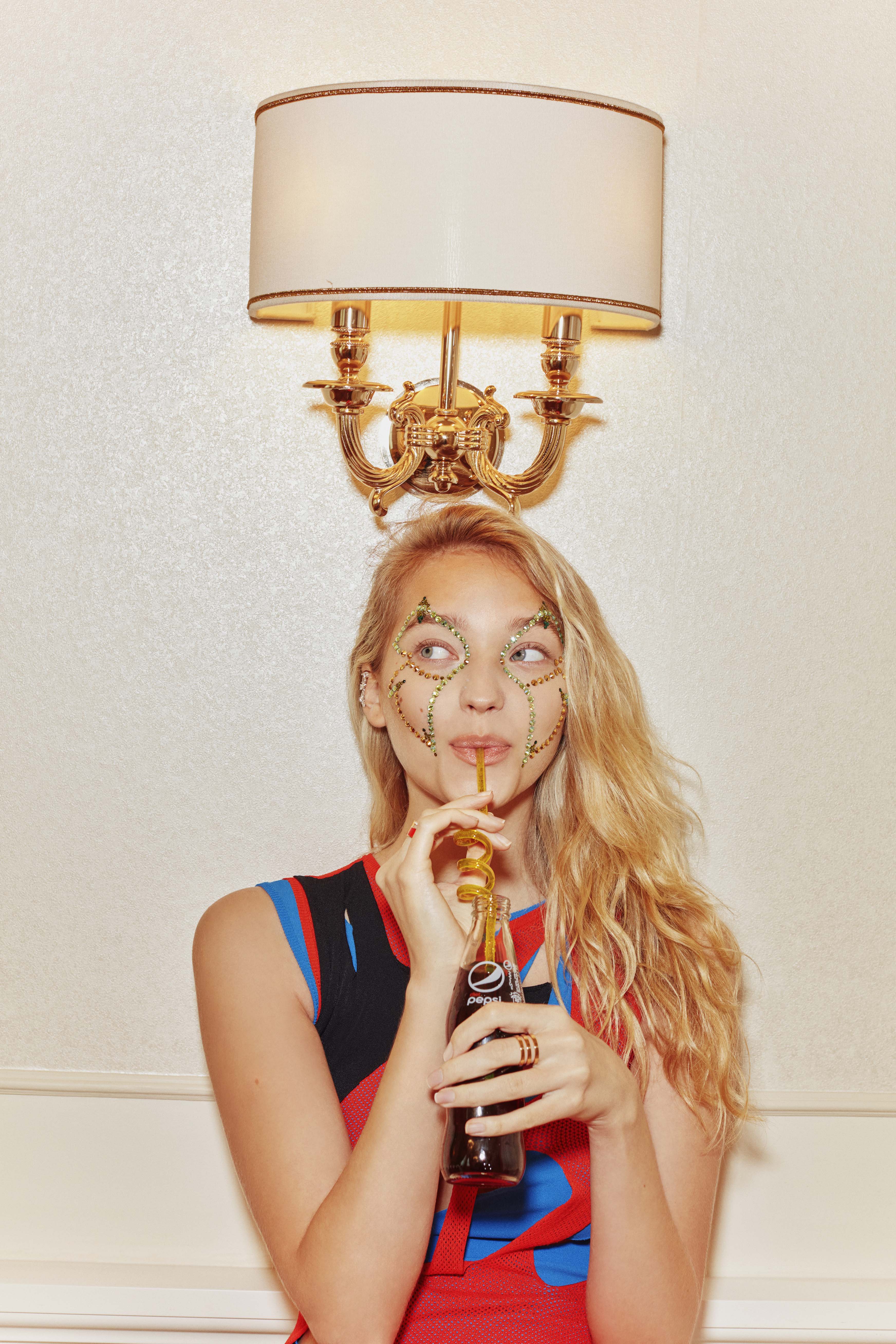
Dress, Dh5,510, Loewe. Serti Sur Vide earcuff, in white gold and diamonds, Dh76,721; Berbere Chromatic ring in red lacquer and diamonds, Dh14,557; and Berbere Three Rows ring in pink gold, Dh8,262, all from Repossi
Dress, Dh5,510, Loewe. Serti Sur Vide earcuff, in white gold and diamonds, Dh76,721; Berbere Chromatic ring in red lacquer and diamonds, Dh14,557; and Berbere Three Rows ring in pink gold, Dh8,262, all from Repossi
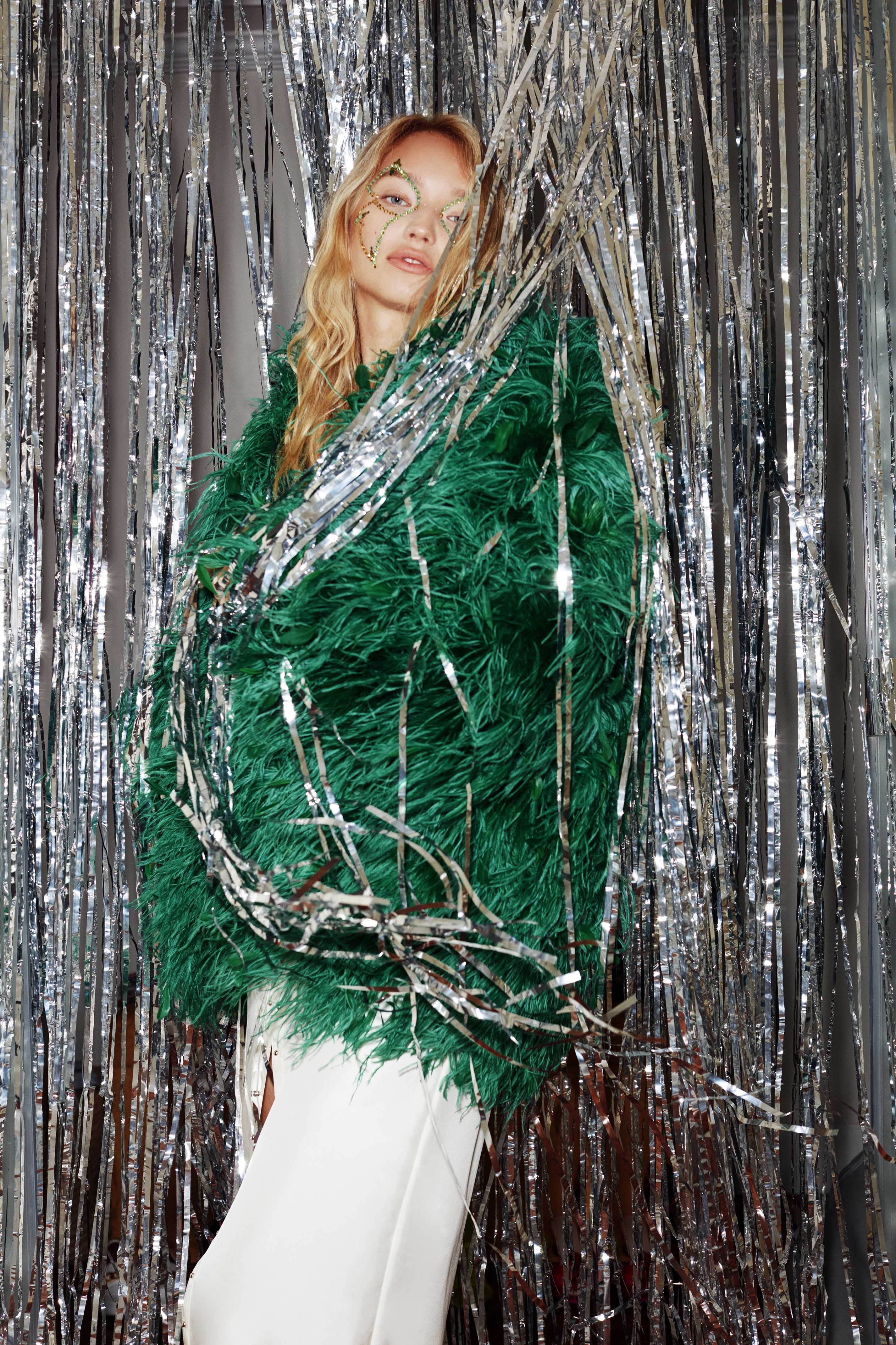
Dress, Dh14,114, Hermès. Feather jacket, Dh70,000, Valentino
Dress, Dh14,114, Hermès. Feather jacket, Dh70,000, Valentino
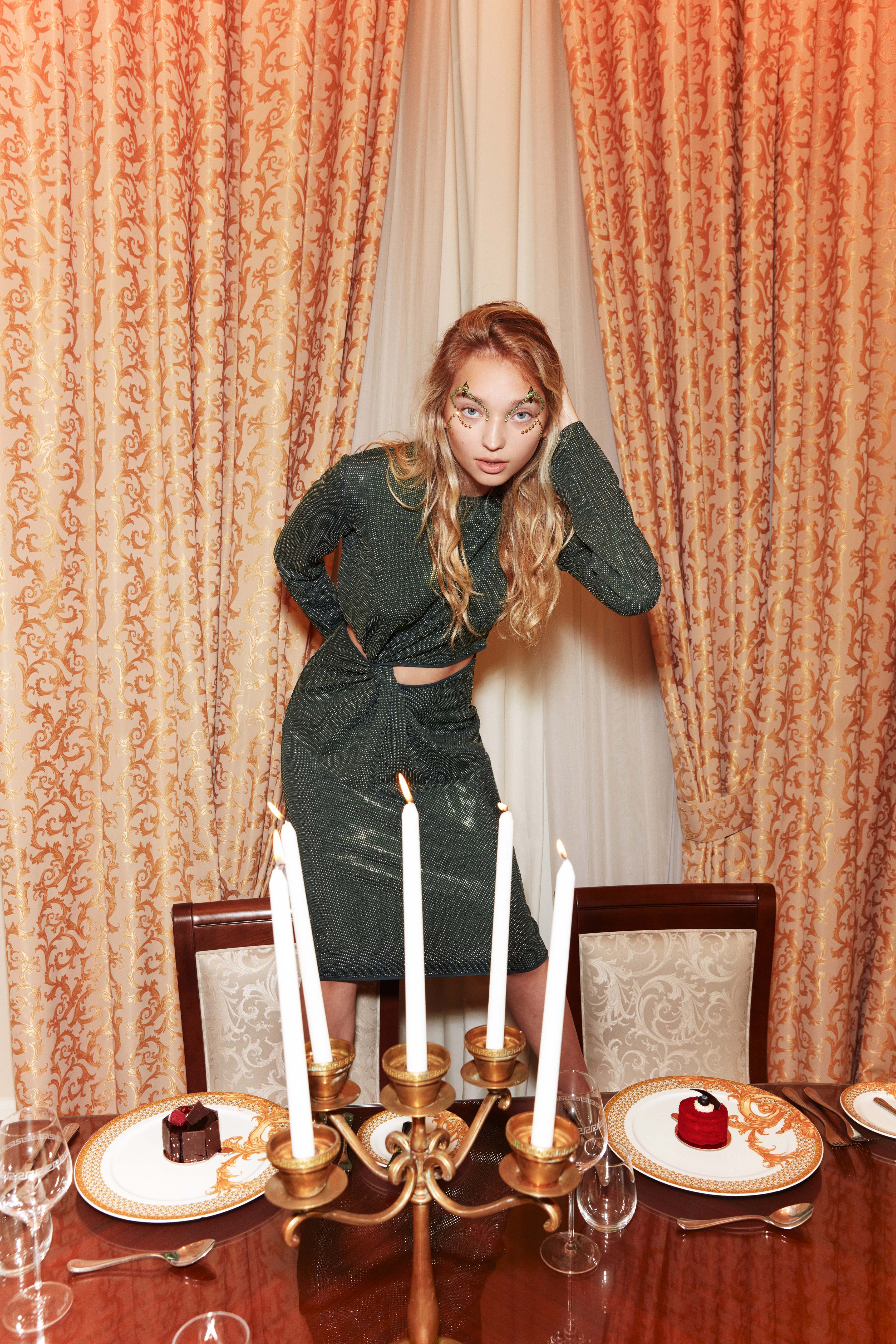
Dress, price on request, Bottega Veneta
Dress, price on request, Bottega Veneta
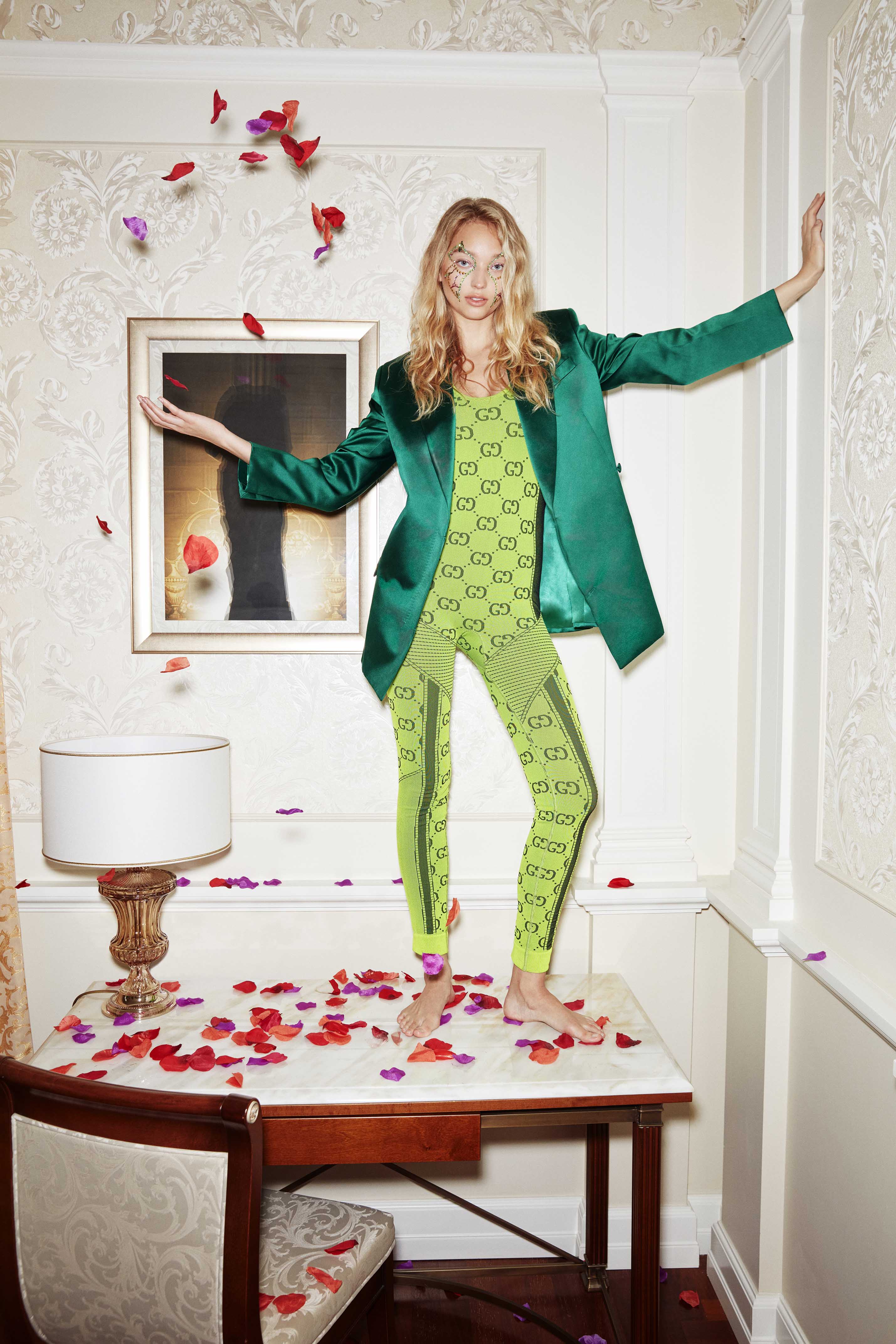
Bodysuit, Dh5,141; and jacket, Dh15,700, both from Gucci
Bodysuit, Dh5,141; and jacket, Dh15,700, both from Gucci
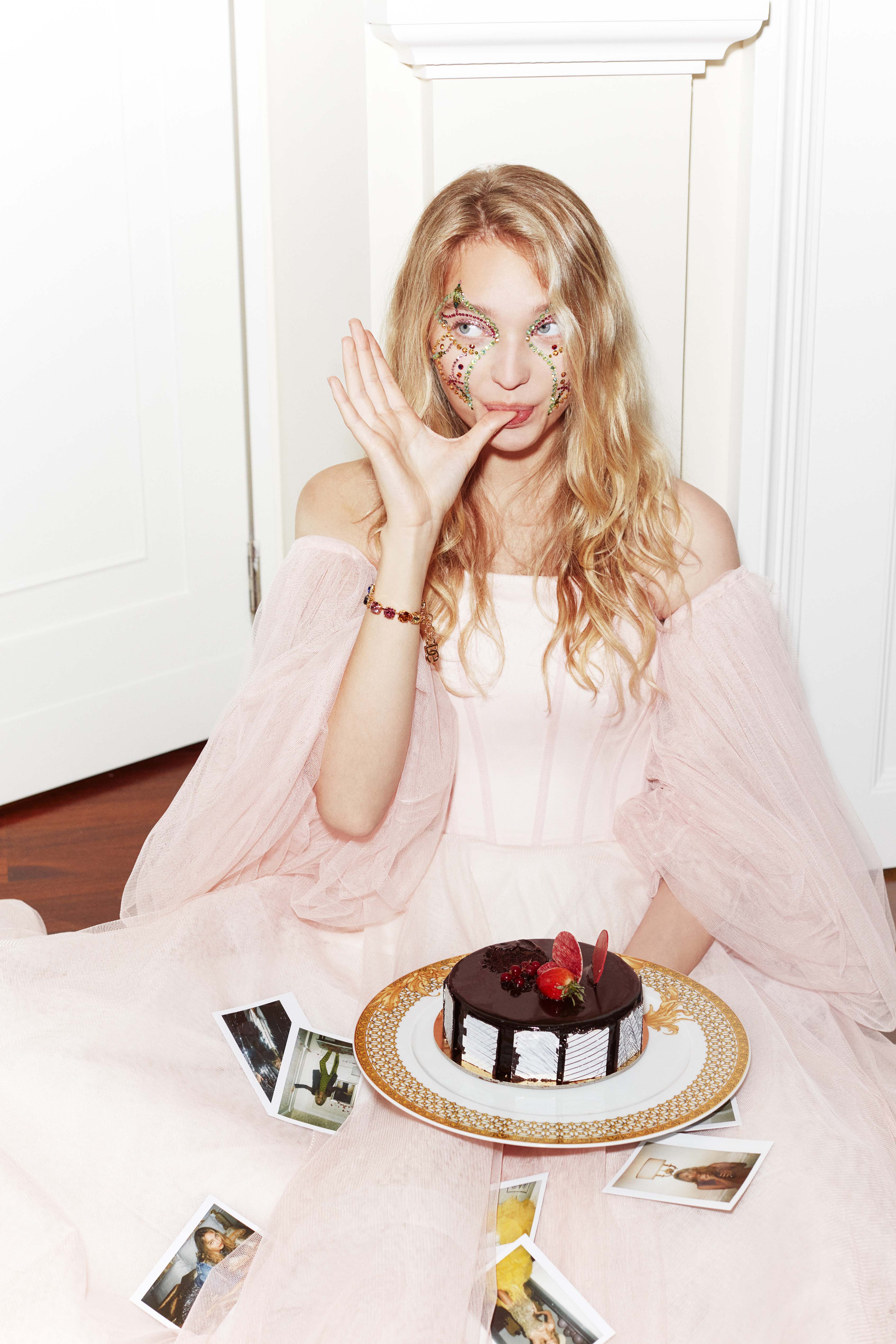
Ball gown, Dh4,407, Bazza Alzouman. Bracelet, Dh2,400, Dolce & Gabbana
Ball gown, Dh4,407, Bazza Alzouman. Bracelet, Dh2,400, Dolce & Gabbana
Hot property: 25580, Sunset Lane, Evergreen, Colorado, US
Built into a rocky outcrop at the edge of a mountain, this eight-bedroom home is a masterclass in seclusion
If you are truly looking to escape, this house on Bear Mountain in Colorado is the ultimate abode. Perched on a rocky outcrop right on the edge of the mountain, it offers privacy, seclusion and some of the most stunning views around.

A welcoming sunroom features a sunken hot tub and steam shower. Photos: Compass
A welcoming sunroom features a sunken hot tub and steam shower. Photos: Compass
A muted exterior in shades of beige and brown means the house melds seamlessly into the mountain, barely distinguishable from its rocky surrounds. Most exterior walls are fitted with floor-to-ceiling glass doors or oversized windows to maximise on the views.
Featuring 780 square metres of living space, the property has eight bedrooms and nine bathrooms set across two levels, as well as a two-bedroom guesthouse with a private terrace. Guest quarters are fitted with sumptuous rocking chairs that look out over the incredible terrain, along with a telescope for more far-reaching viewing opportunities.
The primary bedroom suite is located on the main floor and has a double-sided fireplace, private deck and walk-in wardrobes. A lush cream carpet covers the floor in the bedroom, to help counteract those chilly nights, while a stained glass door leads out on to the terrace, where bench seating presents the perfect spot for a moment of reflection. A large en suite bathroom is home to a sunken tub flanked by a fireplace and a vanity area, both of which look out over the valley.
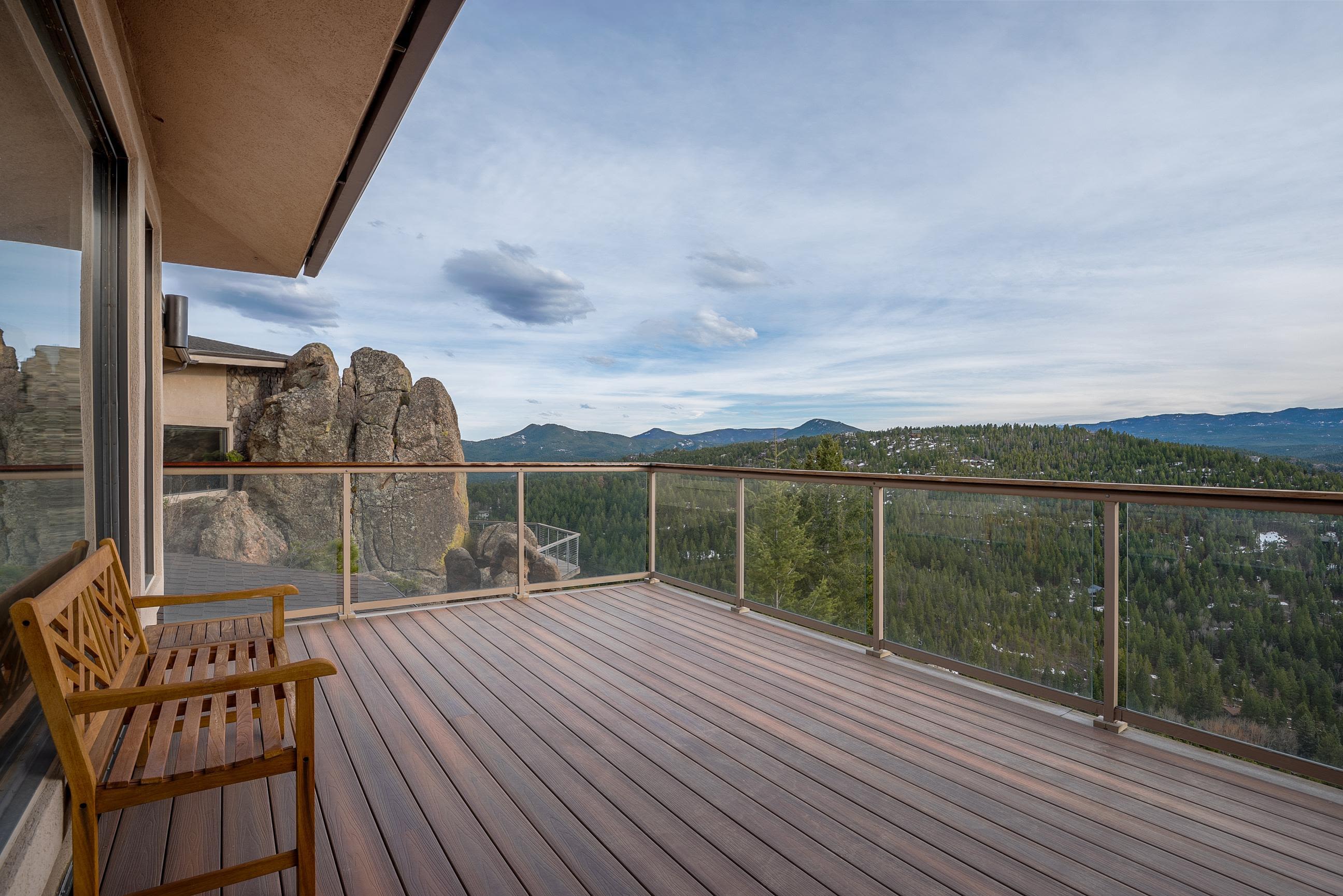
The property is perched on Bear Mountain in Colorado
The property is perched on Bear Mountain in Colorado
Living and dining areas are built around the formation of the rocky site, with boulders encroaching into the interior. Glass walls further emphasise the dramatic topography of the site, highlighting nature’s artistry.
The space has been filled with deep leather seats, heavy wooden furniture and stonework details to complement those natural assets. The large kitchen is also surrounded by glass walls, which open on to a deck that looks out over snow-capped mountains and forest-covered valleys.
The property’s lower level is where all the fun happens. It is the site of a home cinema and gym, while a welcoming sunroom features a sunken hot tub and steam shower. A games room has snooker and foosball tables, as well as a private bar area and leather armchairs for lounging in. There are garages on either side of the house.
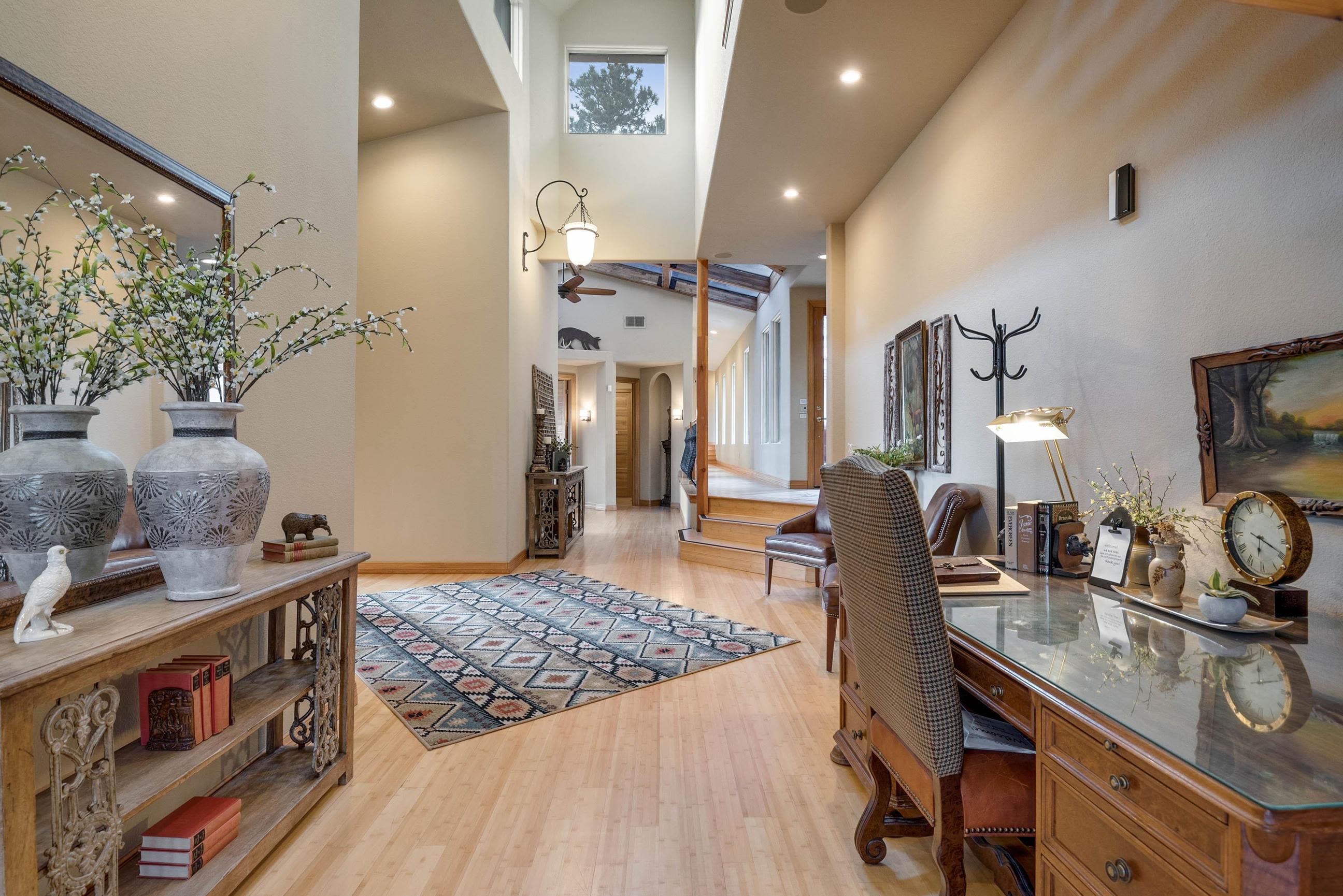
The interior has been filled with deep leather seats, heavy wooden furniture and stonework details
The interior has been filled with deep leather seats, heavy wooden furniture and stonework details
The nearest town is Evergreen, formerly a hunting ground of the indigenous Ute and Arapaho tribes, until white settlers arrived in 1860. Today it is the home of an eclectic community and rich cultural scene, with a local theatre, art galleries, music venues, museums and fine-dining restaurants.
Nearby Evergreen Lake is the site of boating, paddle boarding and picnicking in the summer, ice-skating in the winter and fishing all year round. The area has attracted high-profile guests throughout history, including Greta Garbo and Teddy Roosevelt, while famous residents have included musician Willie Nelson, screenwriter Berkeley Breathed and Olympic gold medal figure skater Scott Hamilton. The property at 25580, Sunset Lane is currently on sale for $4.99 million, via North Evergreen listing agent Compass.
Asking price: $4.99 million

Launch pad: bags built for mini escapes
Paul Smith

Created in conjunction with Japanese bag-making expert Yoshida & Co, this striped holdall looks as good empty as it does full.
Rimowa
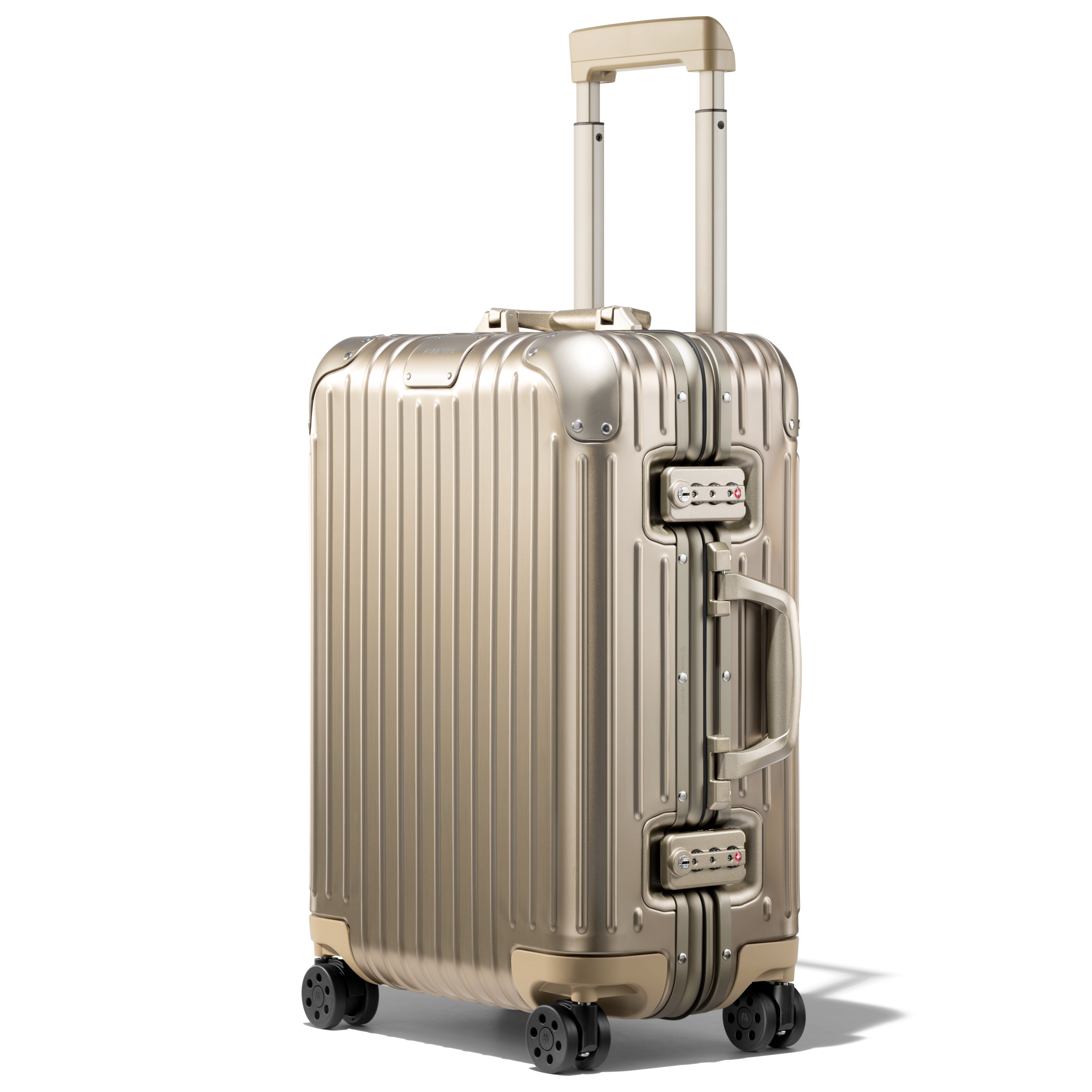
Sized to fit in an overhead locker, this titanium case is lightweight, but incredibly sturdy. The box construction provides plenty of space for a short holiday.
Dior

Actually a handbag, this is perfectly sized for an overnight stay. The snarling tiger motif adds a sense of mischief, while the front pocket is good for face masks and a passport.
Berluti
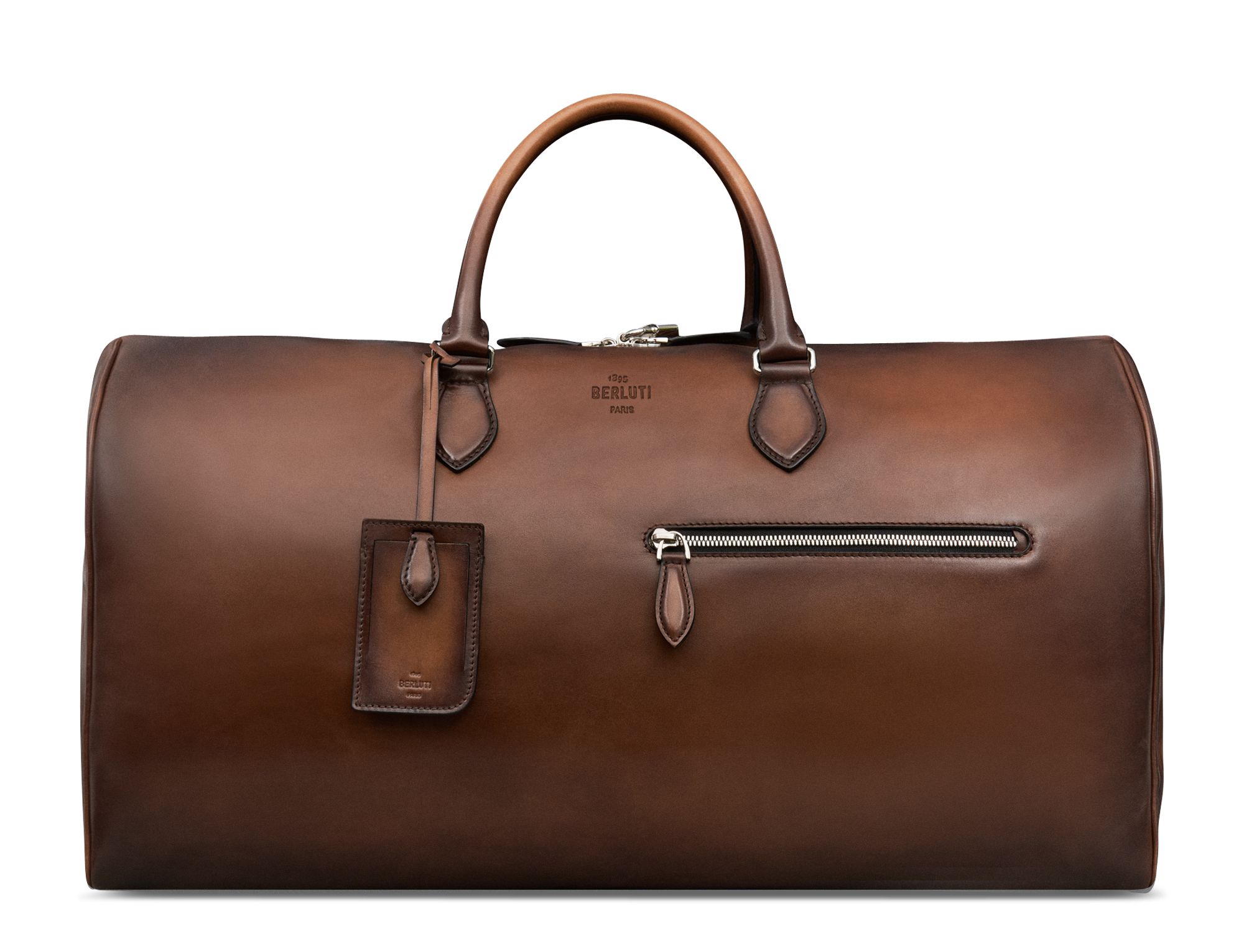
Berluti has been fashioning leather into bags, shoes and boots since 1895, so can be considered something of an expert in the field. This discreet, practical travel bag comes packed with years of technical know-how.
Bally
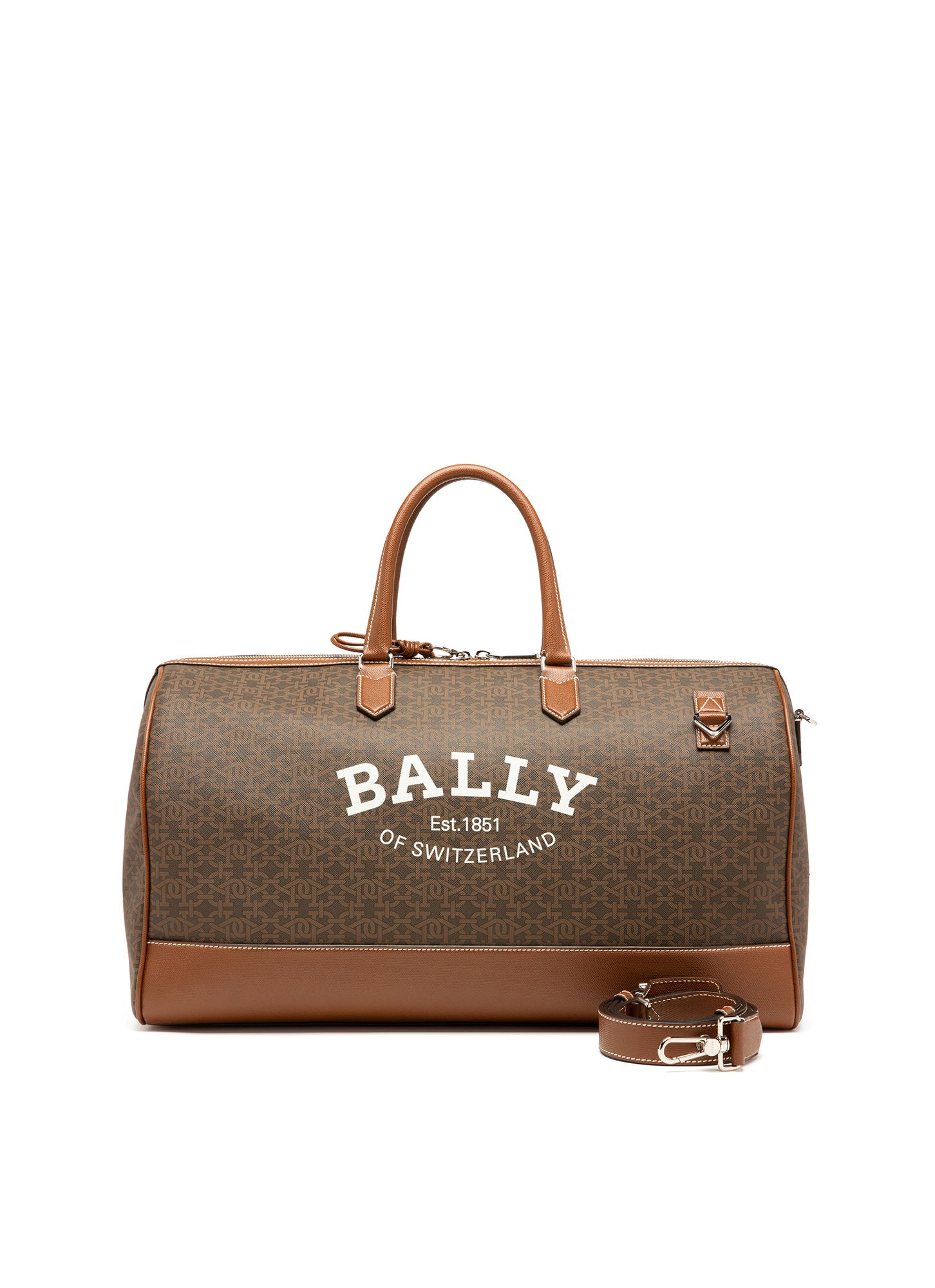
This patterned brown and cognac-coloured leather bag with a reinforced bottom is a good option for a longer getaway.
Curated skincare
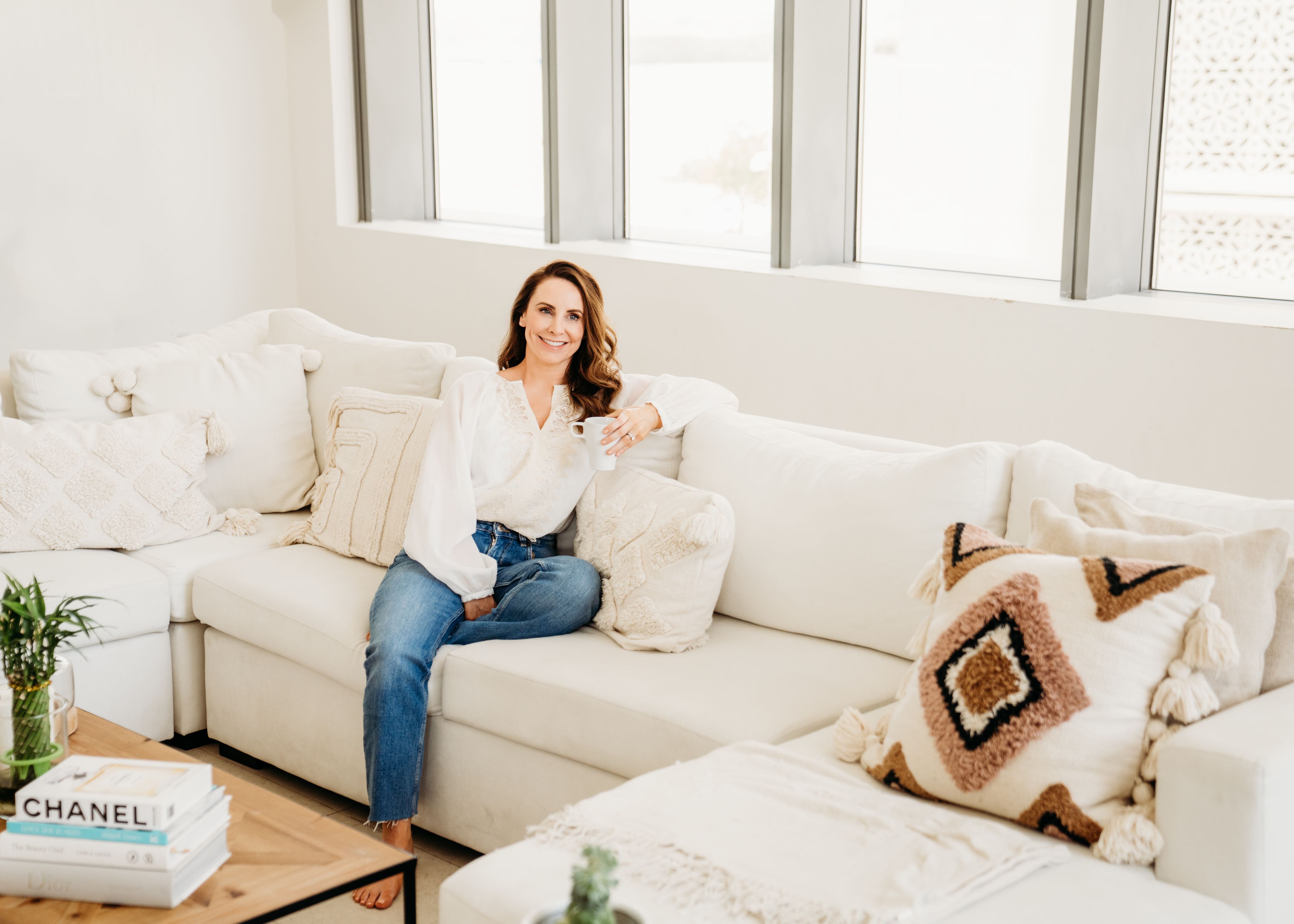
Claire Miller, founder of The Skincare Edit. Photo: The Skincare Edit
Claire Miller, founder of The Skincare Edit. Photo: The Skincare Edit
A new online platform offering high-performance products is the result of Abu Dhabi resident Claire Miller’s lifelong interest in transformational treatments, Selina Denman discovers
It started with a pair of badly threaded brows.
New to the UAE and preparing for her coming wedding celebrations, Claire Miller and a group of six friends visited a salon in Abu Dhabi for a spot of pampering. “We ended up with no eyebrows,” she recalls. “I was about to have my official wedding celebration in Italy and I had no eyebrows.”
Luckily, she was armed with a lifelong passion for skincare and beauty treatments, which started when she suffered from a severe bout of acne as a teenager. “Back then, there wasn’t a lot of information. Probably, today, there is too much information, some of it right and some of it wrong. Whereas back then, GPs wouldn’t really see you and if they did, there was only really one cream available. So it was me researching and trialling different things that ignited my passion for skincare,” she says.
While at university, where she studied business administration, Miller got a job with Crystal Clear, an early pioneer of micro dermabrasion, which provided further exposure to the skincare industry. She eventually ended up joining the UK’s National Health Service, where she worked on the cancer care pathway, but her passion for beauty and skincare endured – and came in handy years later when she and her new friends found themselves sans brows.
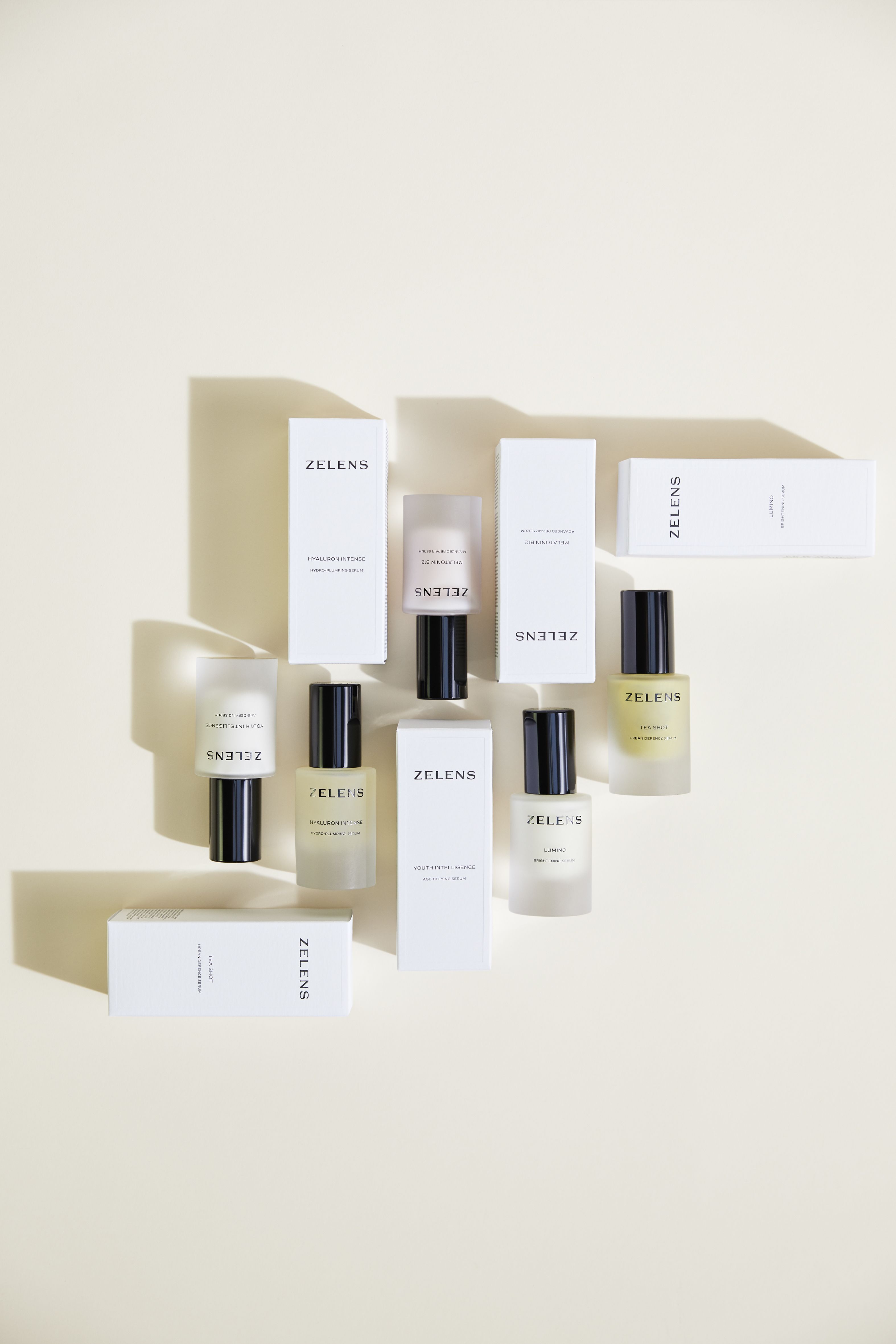
Zelens is on of the hero brands on the new site. Photo: Zelens
Zelens is on of the hero brands on the new site. Photo: Zelens
“I said to the girls, we are not going to touch them, we’re just going to grow them back. And then I’ll try fix us up as best I can.”
She did such a good job of fixing them up that friends of friends started asking that she do the same for them. She decided to go back to the UK and do a dedicated brow course – and her fledgling business was born.
Almost 13 years later and Miller is a much in-demand facialist and aesthetician, with a series of qualifications from the Confederation of International Cosmetology under her belt. “I have the most wonderful clients that I’ve spoken to for the last 11 or 12 years about skin.” And this, Miller says, is where her latest business venture was born: “On the treatment table”.
She has launched The Skincare Edit, an online boutique and information resource promoting some of her favourite tried-and-tested beauty and wellness solutions. “For me, as a facialist, it’s about bespoke skincare and finding the best solution for that particular skin and that particular person. And getting transformational results, which you can actually achieve.
“The Skincare Edit is about bringing my most-loved brands to the Middle East, under one house, and making access easier and fair pricing more accessible,” she says.

Products by Collagen Pantry, one of the wellness brands featured on the site. Photo: The SKincare Edit
Products by Collagen Pantry, one of the wellness brands featured on the site. Photo: The SKincare Edit
The platform currently offers 20 brands, including 10 for which Miller is the exclusive Middle East distributor. These include Votary, Alpha H, Zelens, JS Health, Eye of Horus, Morlife Collagen Pantry, Lük Beautifood, Olive and Oliviere Wilson. The platform offers next-day delivery in the UAE, and also ships to Oman, Saudi Arabia and Bahrain.
“Skin is our biggest organ and also the biggest barometer of our inner well-being,” Miller says. “I didn’t want us just to be about what you put on your face. I wanted us to be completely holistic, so we also have two incredible wellness brands, JS Health and Collagen Pantry. I also wanted to make sure we had a solution for every skin, whether you are a teenager with acne or whether you’re 45 and struggling with ageing, or you have rosacea or sensitive skin.”
Miller also offers online skin consultations, helping clients to fine-tune their skincare routines and sort through what she refers to as “the graveyard of products” that often sit unused in people’s bathrooms. “If you are completely confused, and have spent thousands of dirhams on products, but you don’t know what any of them are doing for you, you can send us some images and fill out an online consultation form.

Brightening Hyaluronic Serum by Votary. Photo: The Skincare Edit
Brightening Hyaluronic Serum by Votary. Photo: The Skincare Edit
“We will go through what is inside your bathroom cupboard. We don’t want you buying for the sake of buying, or because it’s a new trend or something you’ve seen on social media. We want you buying with intent,” she explains.
“Sometimes people will have some great products, but maybe there are too many active ingredients and not enough nourishment within their skincare routine. Or there’s lots of nourishment but a build-up of dead skin cells. We always talk about a balanced skincare routine and beyond that, overall well-being.”
Sustainability is also a consideration when Miller is selecting brands to partner with. She buys in bulk and delivers orders in boxes made from 70 per cent post-consumer waste, with biodegradable tissue paper and thank-you cards.
Miller is very clear about her end goal. “I would love to become the most trusted platform in the Middle East. We got some stats in the other day: 72 per cent of people that shop with us come back to us.
“Everything on the platform I have used, tried and tested, sometimes to my own detriment because I am a human guinea pig and I do have complex skin. And I’ve seen deliverable results. If I don’t genuinely love it, it’s not there.”
'I couldn't talk about racism when I started'
British-Ghanaian designer Ozwald Boateng has rewritten the rules of fashion, one suit at a time. By Sarah Maisey
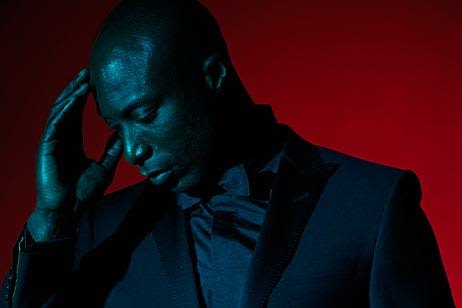
“This is the thing about life. No matter how many successes you have – and I have had many – it’s the gratitude. You have to be grateful,” says British-Ghanaian fashion designer Ozwald Boateng.
In Dubai to launch his latest ready-to-wear capsule collection, called Black AI, with the initials standing for authentic identity, at That Concept Store in the Mall of the Emirates, Boateng could be forgiven for feeling self-satisfied. He was the first black man on Savile Row, the first tailor to show at Paris Fashion Week, served as the creative director for menswear at Givenchy and has been awarded an OBE.
But, now in his mid-fifties, Boateng is more philosophical about the path his life has taken. “Success and failure live in the same chair with you, because the failure is the learning. It’s always about the experiences, I have learnt. They are key.”
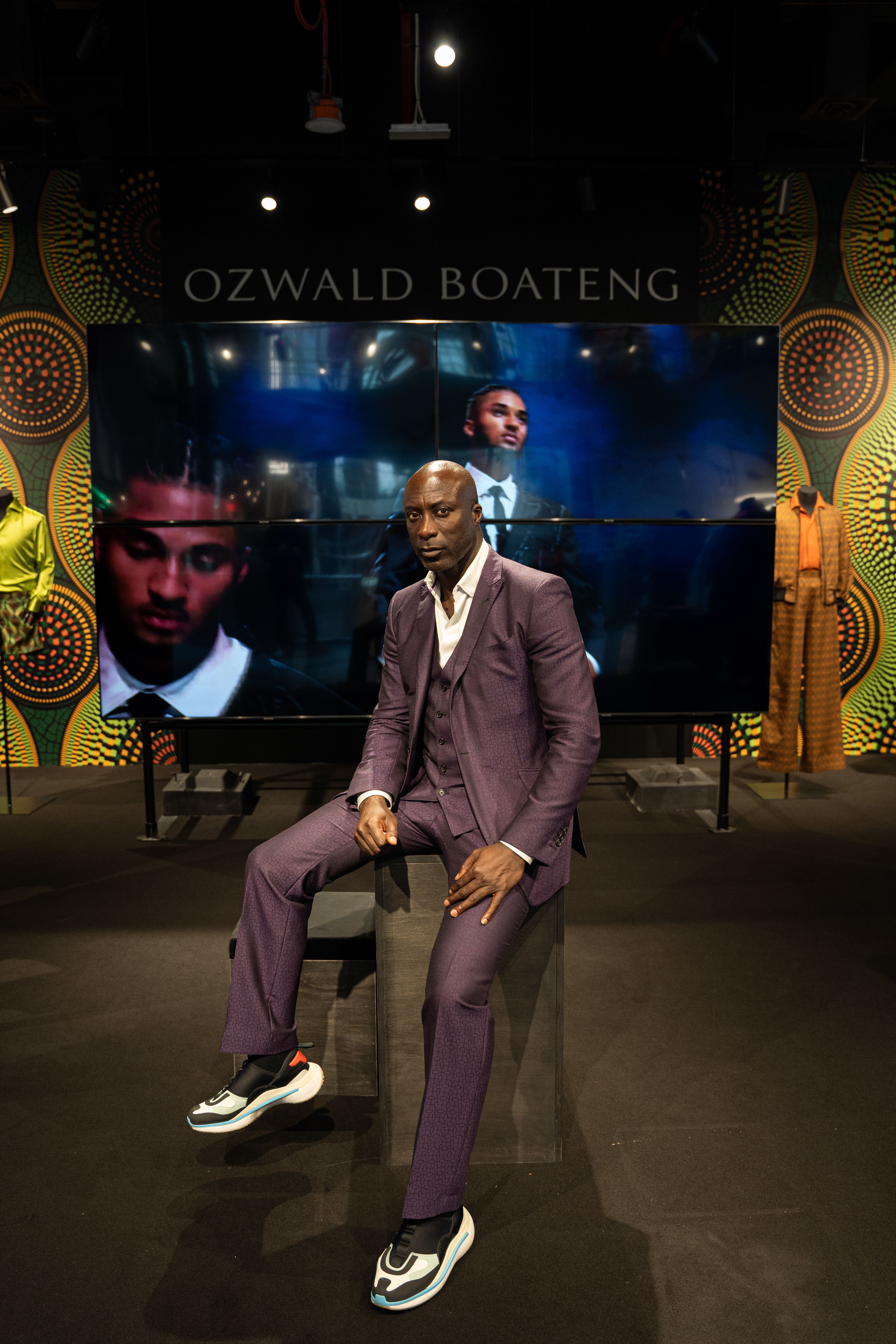
Designer Ozwald Boateng at That Concept Store in Dubai. Photo: That Concept Store
Designer Ozwald Boateng at That Concept Store in Dubai. Photo: That Concept Store
While that journey has brought him fame and success, it has not always been a smooth ride. “I went to school in the 1970s and culturally I grew up in a time when racism was real. So being chased down the street was a daily exercise,” he says.
“I had a very strong belief in myself because of my father – he gave me a lot of confidence – and he brought me up with a certain sense of self. I was never unsure about me, but put that in the landscape of racism and it was tough. I had a lot of fun as a kid, but I used to get chased because I was black.”
Born to Ghanian parents and immensely proud of his heritage, Boateng realised that he wanted to be able to change how people of colour were perceived. “At the time, there were two routes,” he says. “People could get very angry about racism, or they could work through it, and I choose to work through it.”
Boateng’s chosen route was via fashion, after it became apparent that he had an unwavering instinct for tailoring and an almost poetic command of colour.
By the time he was 17, he was being urged to take his talents to Savile Row, the bastion of British bespoke suit-making. “A friend of mine, the artist Duggie Fields, said to me: ‘You need to go to Savile Row’. My response was: ‘What, those dusty old men? Why am I going to go down there?’”
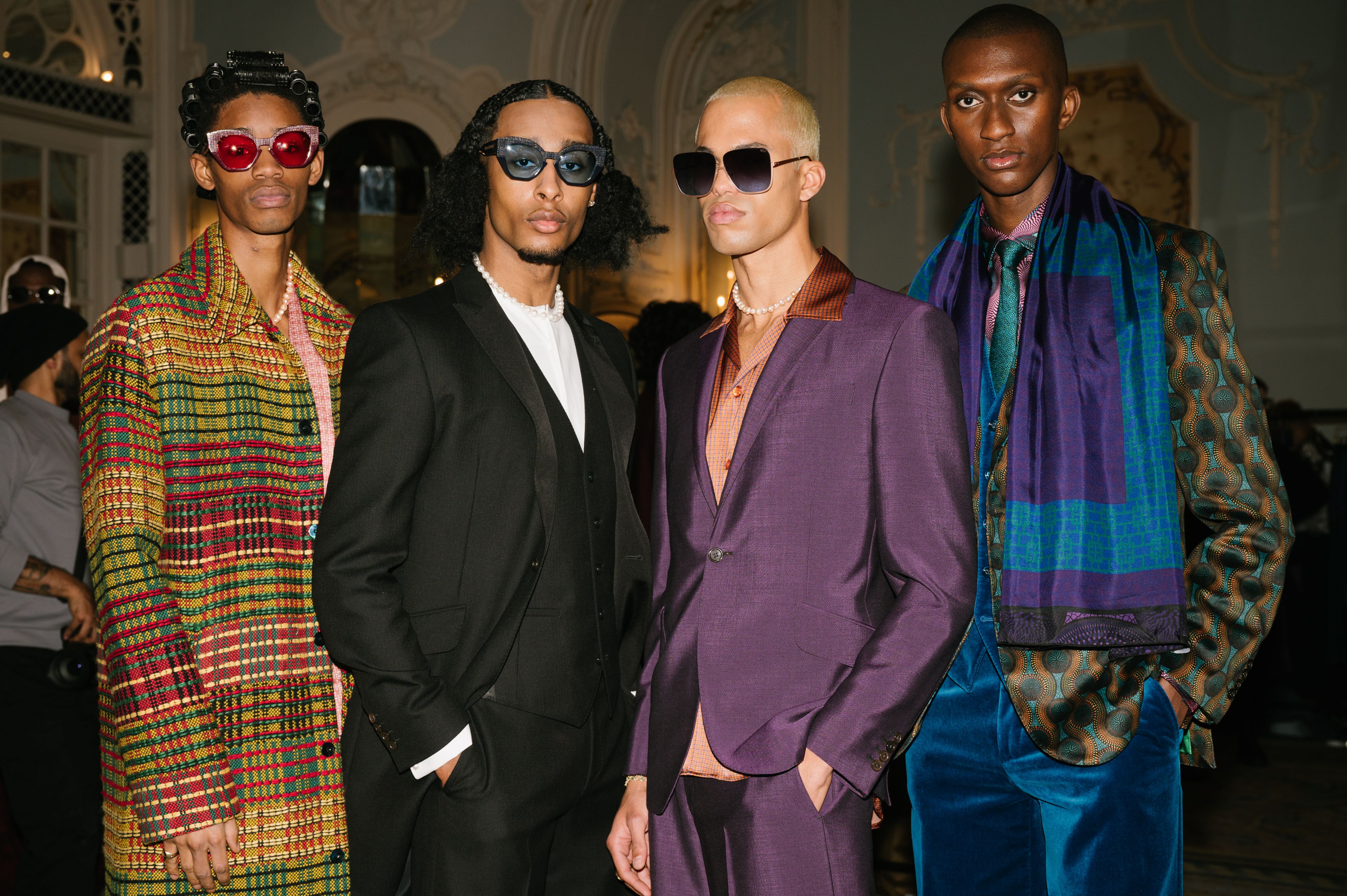
Backstage at Ozwald Boateng's London Fashion Week show. Photo: Andrew Barber
Backstage at Ozwald Boateng's London Fashion Week show. Photo: Andrew Barber
What Fields seemingly understood, before Boateng, was that if this cocksure, talented young black man could win over the “dusty old” sphere of white male privilege that Savile Row represented, he would have the world at his feet.
At that point in the 1980s, tailoring as an art form was dying, as designers cut their suits loose and boxy. Despite being the heart of bespoke tailoring since the 1790s, Savile Row was losing its relevance, the relic of an outdated era.
By contrast, Boateng’s suits were beautifully cut, tailored for a slim, elegant fit, and came lined in jewel-toned silks in purple, orange or fuchsia. Although only in his twenties and almost entirely self taught, in 1994 he took his collection to Paris Fashion Week – the first tailor to do so. As the press waxed lyrical about this vibrant new talent and customers lined up outside his door, he opened his first shop on Vigo Street, just off Savile Row, in 1995, becoming, at the age of 28, the first black man to ever do so.
His dazzling cuts drew in a new generation of customers, and with clients such as Forest Whitaker, Russell Crowe, Daniel Day Lewis and Spike Lee, Boateng is credited with reviving suit-making, saving Savile Row from extinction in the process.
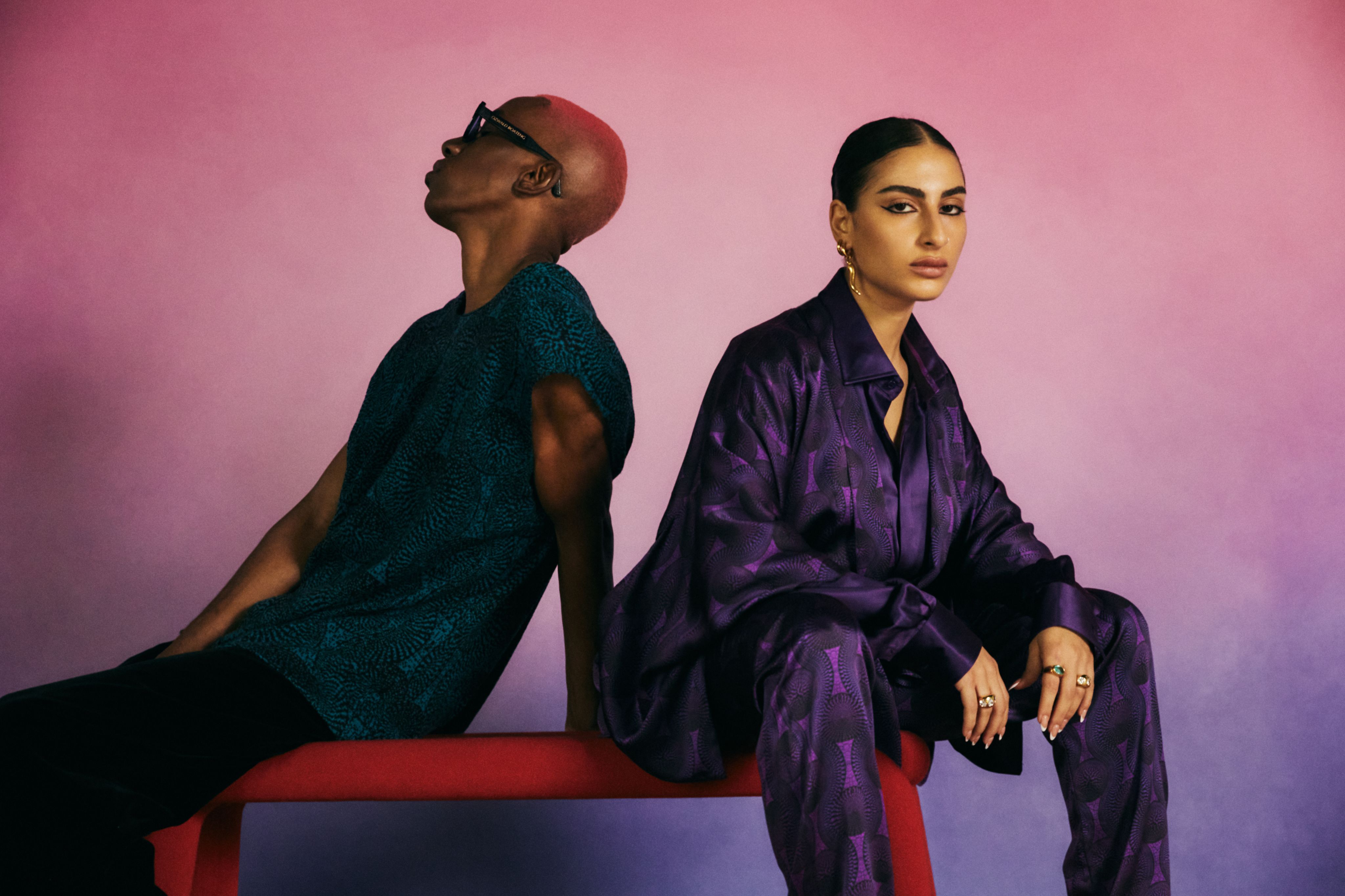
Boateng's latest collection is now available in Dubai. Photo: That Concept Store
Boateng's latest collection is now available in Dubai. Photo: That Concept Store
In 2003, he was appointed creative director of menswear at Givenchy, a position he held until 2007. In 2005, he was invited to be part of the Fashion in Motion series at the Victoria & Albert Museum in London, delivering a collection that mixed burnt orange with lavender, royal blue with periwinkle, and caramel with mustard.
His dapper tailoring appeared in the films Lock, Stock and Two Smoking Barrels, Tomorrow Never Dies and The Matrix, and in 2000, he won Best Menswear Designer at the British Fashion Awards. Away from fashion, in 2008, Boateng was appointed to the Reach committee, to help inspire and motivate young black boys, and he co-founded the Made In Africa Foundation, a non-profit aiding development across the continent. In 2006, he received an OBE from Queen Elizabeth II for services to British fashion.
“I put in the work,” he says. Yet, while achieving all these personal career highs, he maintains he always had a greater purpose in mind, but had to keep it hidden. “I have only been able to have this conversation recently,” he explains.
“When I get asked about where my design ethos comes from, it’s so beyond fashion and so rooted in culture. I couldn’t talk about racism when I started, because I would have been seen as the angry young man, and I didn’t want what I created to be confused.”
As a man of colour, Boateng has always seen it as his responsibility to excel in his field and open doors for others. “I knew that my being on Savile Row and having shows in Paris had cultural implications. And to have the right impact, you can’t shout, you have to just do it by being present.”
While successful, the ploy has at times backfired, as evidenced during the rise of Virgil Abloh. “I knew what I was doing, but it’s funny, people forget that I was at Givenchy. When Virgil Abloh became creative director for menswear at Louis Vuitton, they talked about him being the first black designer.”
In reality, Boateng preceded Abloh as the head of a major fashion house by 15 years, something all but forgotten today. But while that smarts, he understands why his achievement is often overlooked.
“I didn’t position myself like that. Instead, I positioned myself just as a creative who happened to be black. I took that position to say, what’s the big deal? You are judging the creative, not what the person looks like.”
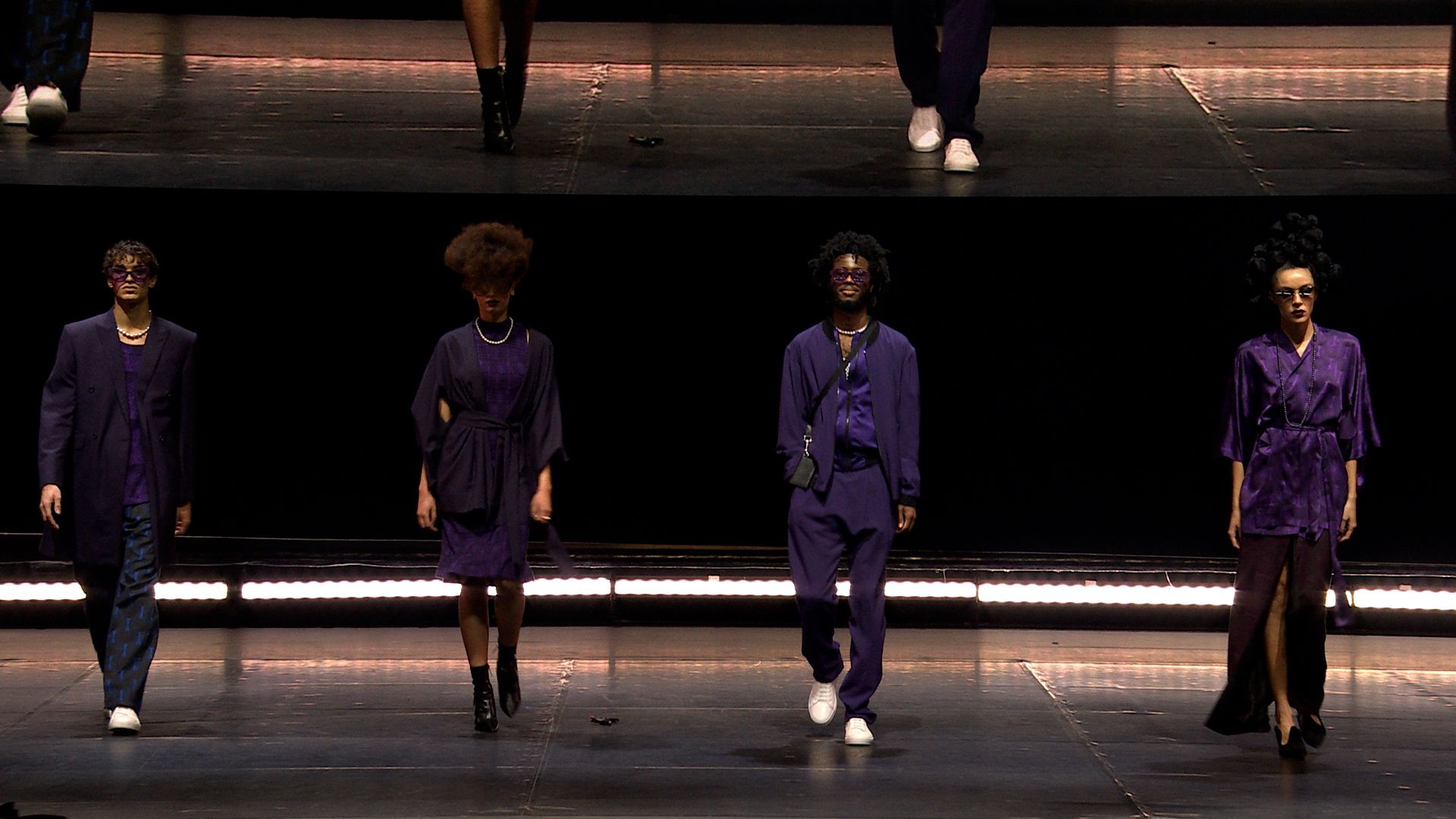
Looks from the Black AI collection. Photo: Ozwald Boateng
Looks from the Black AI collection. Photo: Ozwald Boateng
In 2018, Boateng shifted his cultural heritage front and centre, holding his first show in years at the Arise Fashion Week in Lagos, Nigeria. Unveiling his first ready-to-wear collection during a show called Africanism, it was something of a stylistic evolution – with his signature clean silhouettes and rich colours now decorated with patterning taken from traditional Ghanaian kente cloths, as well as the Adinkra phonetic alphabet.
In 2019, Boateng released its second iteration, called AI, at the Apollo Theatre in Harlem, New York. The choice of location was important, he explains, because “in terms of African-American history, it is the church of churches. Everyone from Ray Charles to Gil Scott-Heron to James Brown has performed on that stage.”
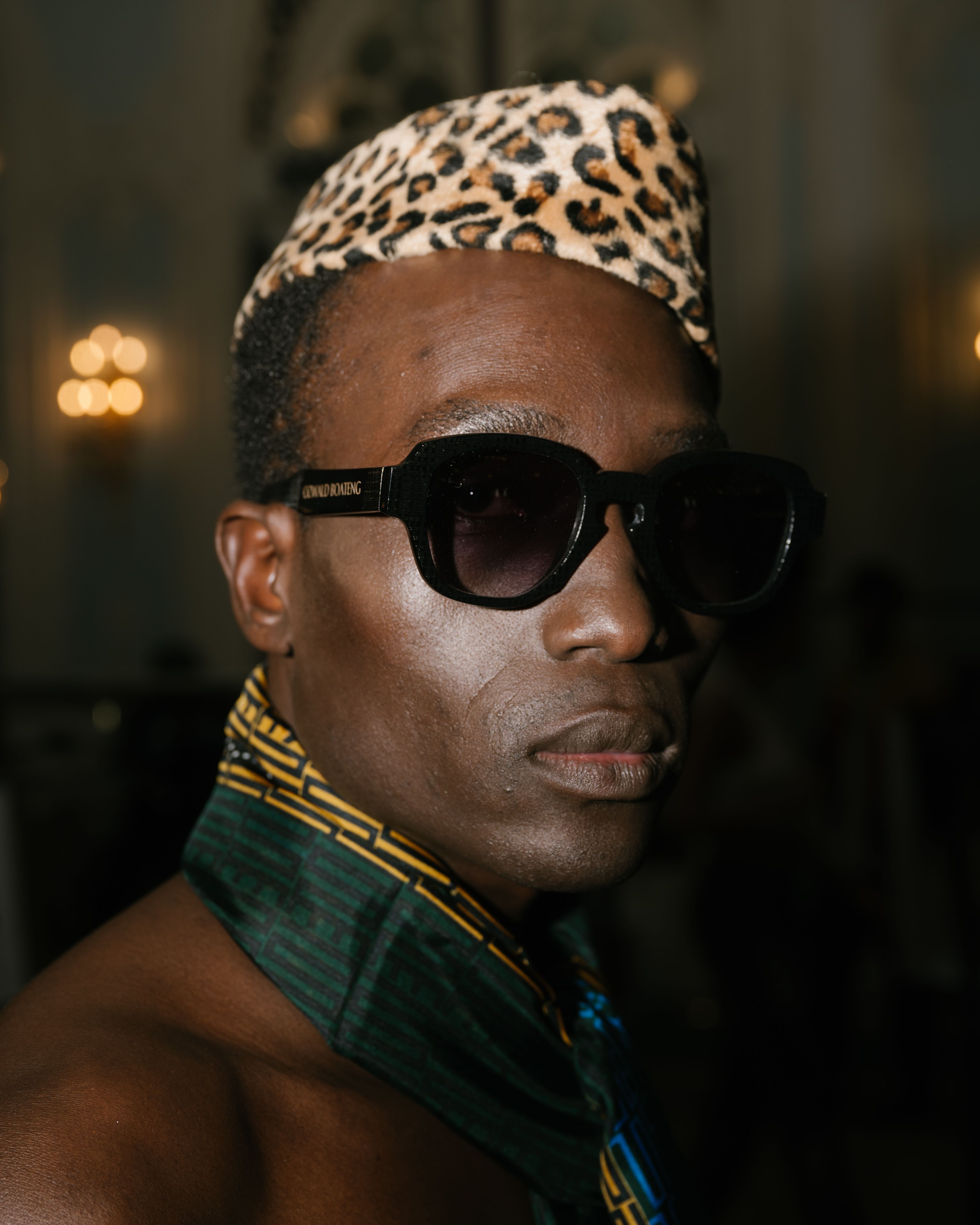
The designer's collections increasingly reference his Ghanaian heritage. Photo: Andrew Barber
The designer's collections increasingly reference his Ghanaian heritage. Photo: Andrew Barber
Timed to coincide with the anniversary of the Harlem Renaissance, it was also his first foray into womenswear, a move inspired largely by his daughter. To accompany the show, Boateng had the all-female African-American Harlem Orchestra play live.
“The energy in that space is beyond imagination,” he recalls. “We were the first fashion show to be held there, and I got to sign my name on the wall among all those greats. So again, it’s back to gratitude. It was a real privilege.”
Deeply impacted by the murder of George Floyd in May 2020, for the third chapter, called Black AI, Boateng doubled down on the idea of blackness and black excellence.
To press this idea home, for the finale, Boateng appeared on stage with actor Idris Elba. The much-anticipated show was held in February as part of London Fashion Week, and marked the designer’s return to the British fashion calendar after an absence of 12 years. It is this collection that is now on sale in That Concept Store.
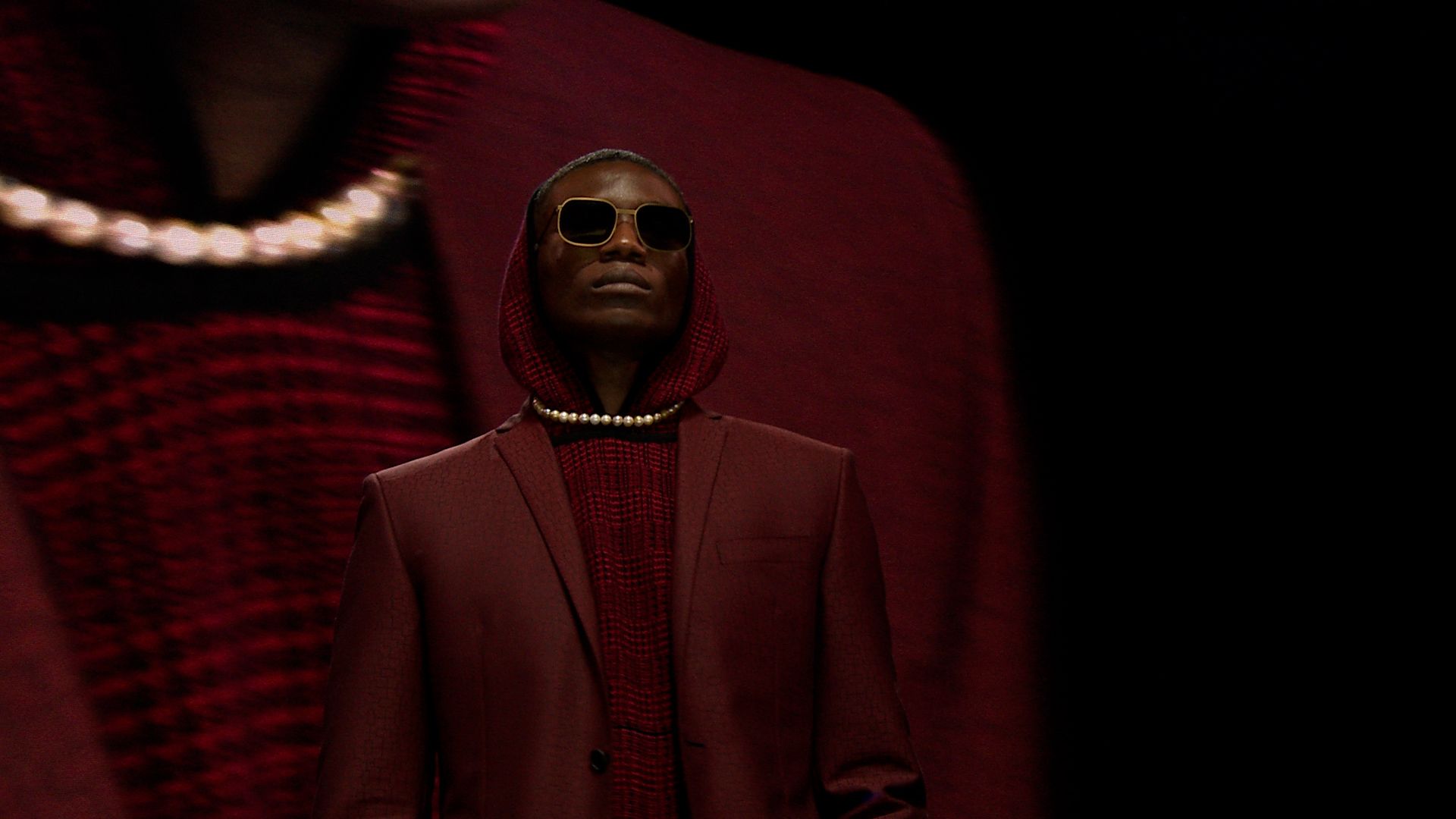
Boateng returned to London Fashion Week after an absence of 12 years. Photo: Ozwald Boateng
Boateng returned to London Fashion Week after an absence of 12 years. Photo: Ozwald Boateng
Comprising lightweight silk bomber jackets, woven tank tops, seersucker shirts and fluid, floor-length kimonos, the collection is decorated in the same vibrant Ghanaian patterns, some literal and others a little more discreet, including an intricate motif that turns out to be a letter from the Adinkra alphabet, repeated over and over. Colours are bold and invigorating, shifting from zesty lime to teal and from red to regal purple.
While it is being marketed as ready-to-wear, the collection has been conceived more along the lines of bespoke – with three patterns and 12 colours – and is available in limited editions, meaning once it’s gone, it’s gone. While Black AI represents the third chapter in the story, there are, he promises, two more to come.
Reminiscing on a career spanning 30-odd years, Boateng explains that while much has changed in terms of black acceptance, there is still a lot more to do. “When I was growing up, in terms of black representation, the first British black face I saw on television was [the comedian] Lenny Henry. There were no other reference points.
“So when I got my first bit of media in the 1980s, I knew what that would mean. I was more than just a designer, I was a Savile Row tailor, and the message was, if I can do that, so can others,” he says.
Now, he has people coming up to tell him he was their “first reference point”.
Breathing new life into interiors
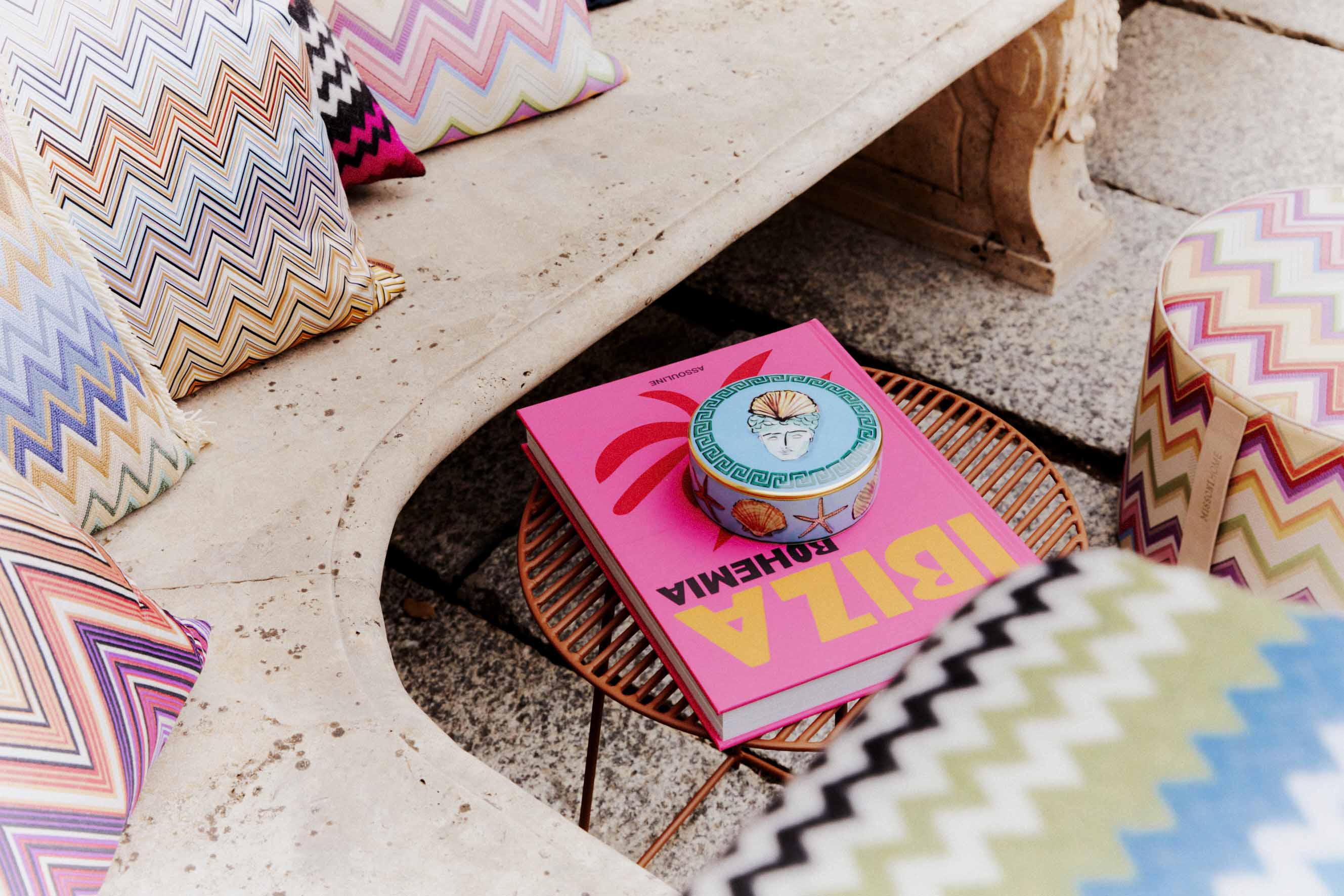
Mytheresa has launched a dedicated Life category. Photo: Mytheresa
Mytheresa has launched a dedicated Life category. Photo: Mytheresa
Luxury e-tailer Mytheresa has launched its Life category, offering a multifaceted collection of objects that’ll help spruce up your home. By Selina Denman
“It goes without saying that our customers have great taste,” says Richard Johnson, chief commercial officer of luxury e-tailer Mytheresa.
“They spend a lot of time and energy on their wardrobes and on how they present themselves to the world. So, from our point of view, it’s a very natural extension to talk to them about the environments they spend their time in.”
On May 18, Mytheresa unveiled its new Life category, a carefully curated selection of items for the home that includes furniture, lighting, tableware, textiles, home fragrances, coffee table books, cushions and even accessories for pets. This is the first time that the brand is venturing outside of fashion, having launched in 2006 with womenswear, before moving into kidswear in 2019 and menswear in 2020.
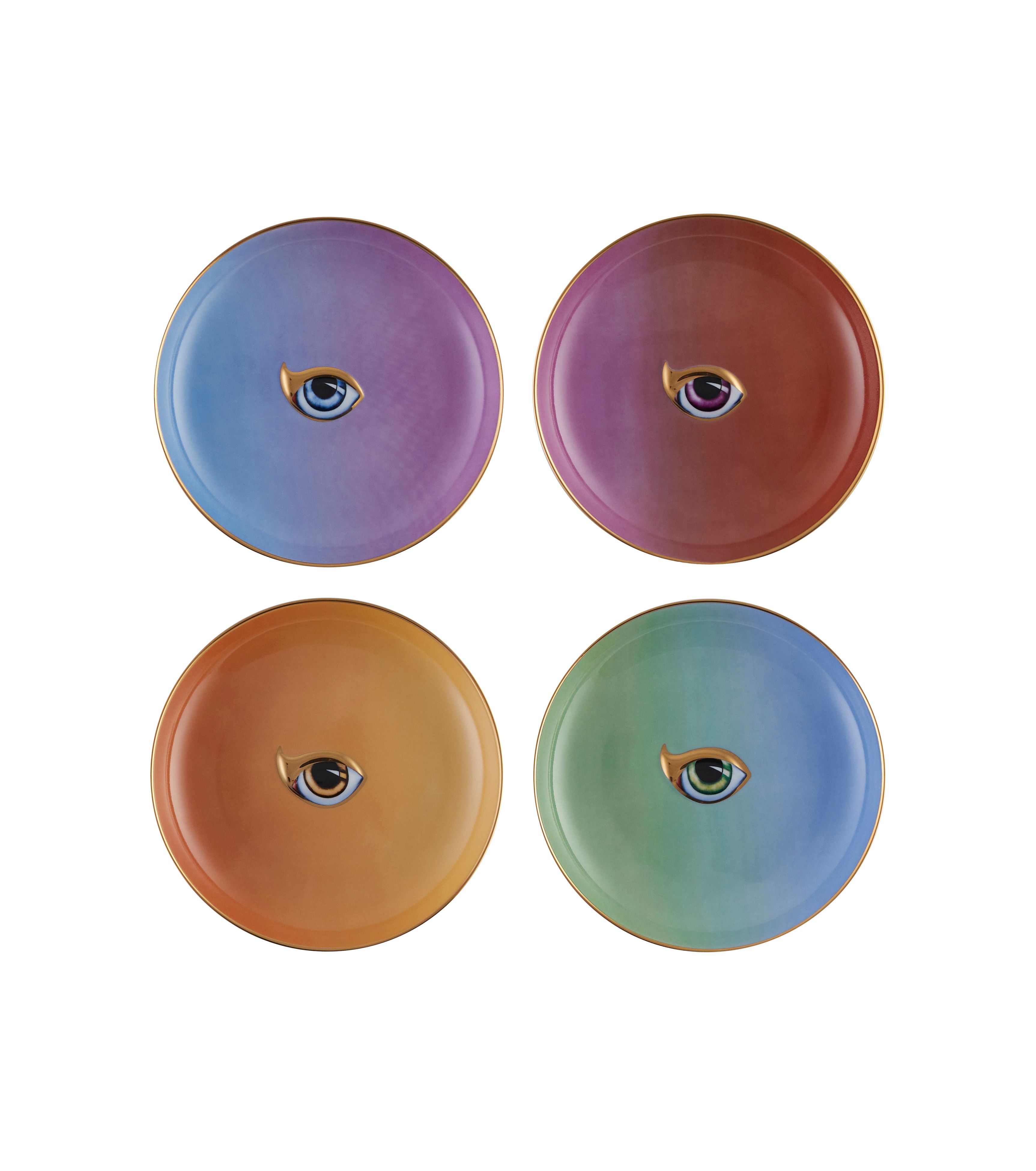
Lito plates, €245 for four, L'Objet
Lito plates, €245 for four, L'Objet
The latest launch is as much a sign of the times as it is of Mytheresa’s ambitions to service customers beyond their wardrobes. The pandemic has encouraged people to spend much more time in their homes and, as a result, appreciate the value of investing in their personal spaces. It has also made consumers far more comfortable with the online buying process, whether they are acquiring necessities from Amazon, the latest fashion collections from Mytheresa or larger items such as a statement chair by Vitra.
The interiors segment lends itself particularly well to the online format, says Johnson. “If you think about the diversity of the category – we’ll have textiles, but also lighting and decorative objects, through to larger furniture pieces.
“In some ways, it is difficult to show that breadth of product and to create room settings and to put things together in inspirational ways in a physical environment, and to keep that fresh and interesting and new and engaging. Whereas, online you are not limited by the four walls you live in. You can create infinite room sets and inspiration.”
As has always been its wont, Mytheresa is taking a highly curated approach to its Life offering. “We carry far fewer designers and are much more focused on designers that we believe matter. We are very focused on curating the products from those designers – doing some of the work for the customer, by showing them what we love and what we think they will love too.”
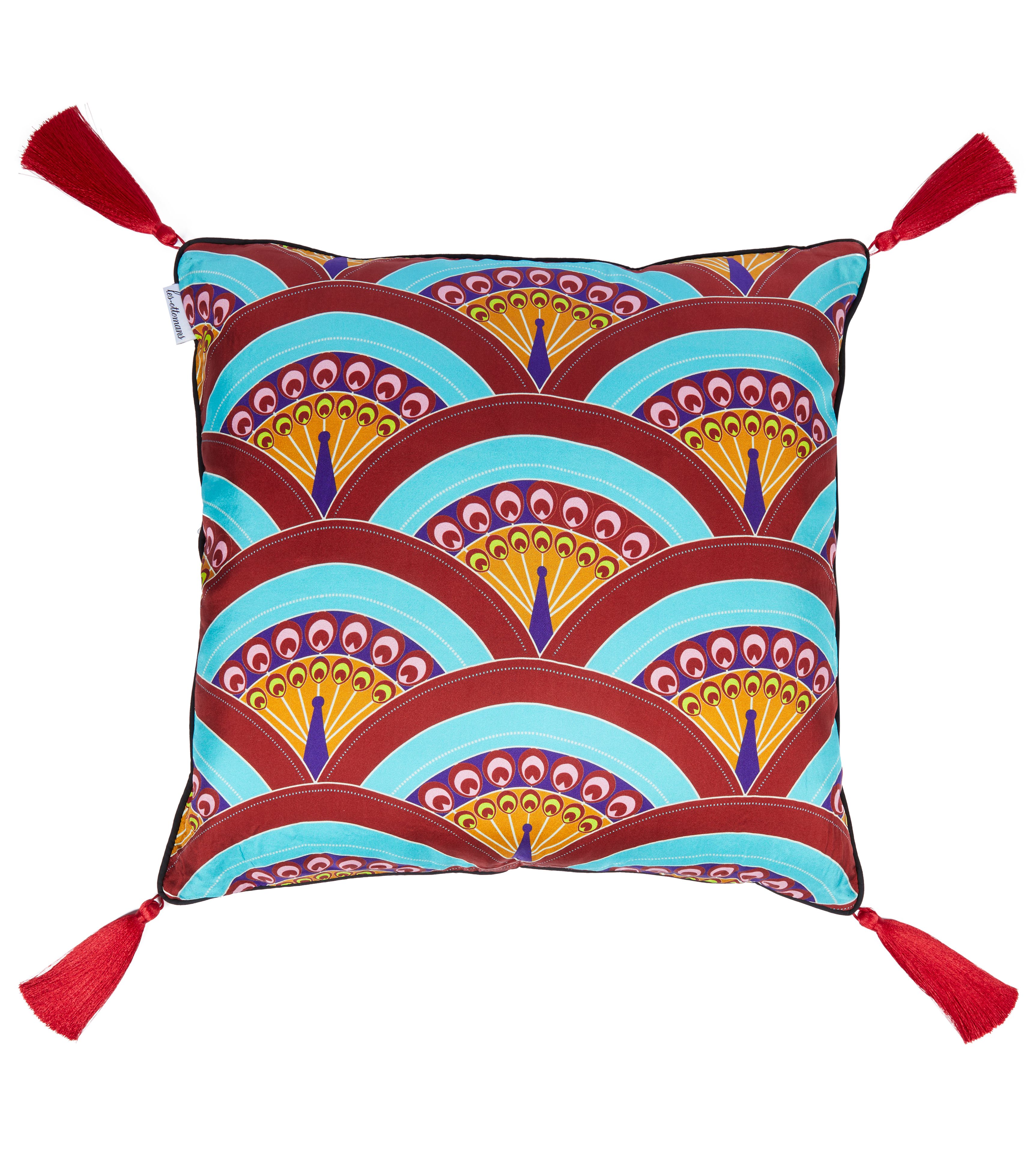
Peacock silk cushion, €105, Les Ottomans
Peacock silk cushion, €105, Les Ottomans
As a natural starting point, the e-tailer has teamed up with its existing fashion partners to offer homeware by designers such as Loro Piana, Gucci, Missoni, Dolce & Gabbana and Aquazzura. These are complemented by world-renowned design brands such as Vitra, Fornasetti and Cassina, as well as smaller artisanal names such as Ginori 1735, Block Studios, 1882 Ltd and Serax.
There are more than 60 brands featured on the site, offering an incredibly broad selection of products. Dragonflies flit across fine porcelain plates by Italian ceramicists Ancap and La DoubleJ, while Dolce & Gabbana’s uplifting Sicily-inspired prints are emblazoned across silk cushions. The pared-back lines of Vitra’s world-famous Panton chair are offset by Missoni’s multi-hued block prints, and sleek white terrazzo side tables by Serax are elevated by Assouline’s colourful coffee table books. Tom Dixon glassware pairs beautifully with sleek tableware by L’Objet, while Vitra presents stylish storage solutions. There are wool blankets by Versace, sculptural candles by Ginori 1735, cashmere pillows by Gabriela Hearst and dog jackets by Moncler.
“There are lots of really interesting little treasures in there that I think customers will really enjoy browsing,” says Johnson. “We are going to be bringing in more of those artisanal brands as we go.
“One thing we are very excited about and speaks again to our experience in fashion, is creating capsule collections – bringing new ideas to designers and collaborating with them to create surprising new angles on their worlds.”
Soaking in the views
Sarah Siese presents a selection of hotel bathtubs with world-class views
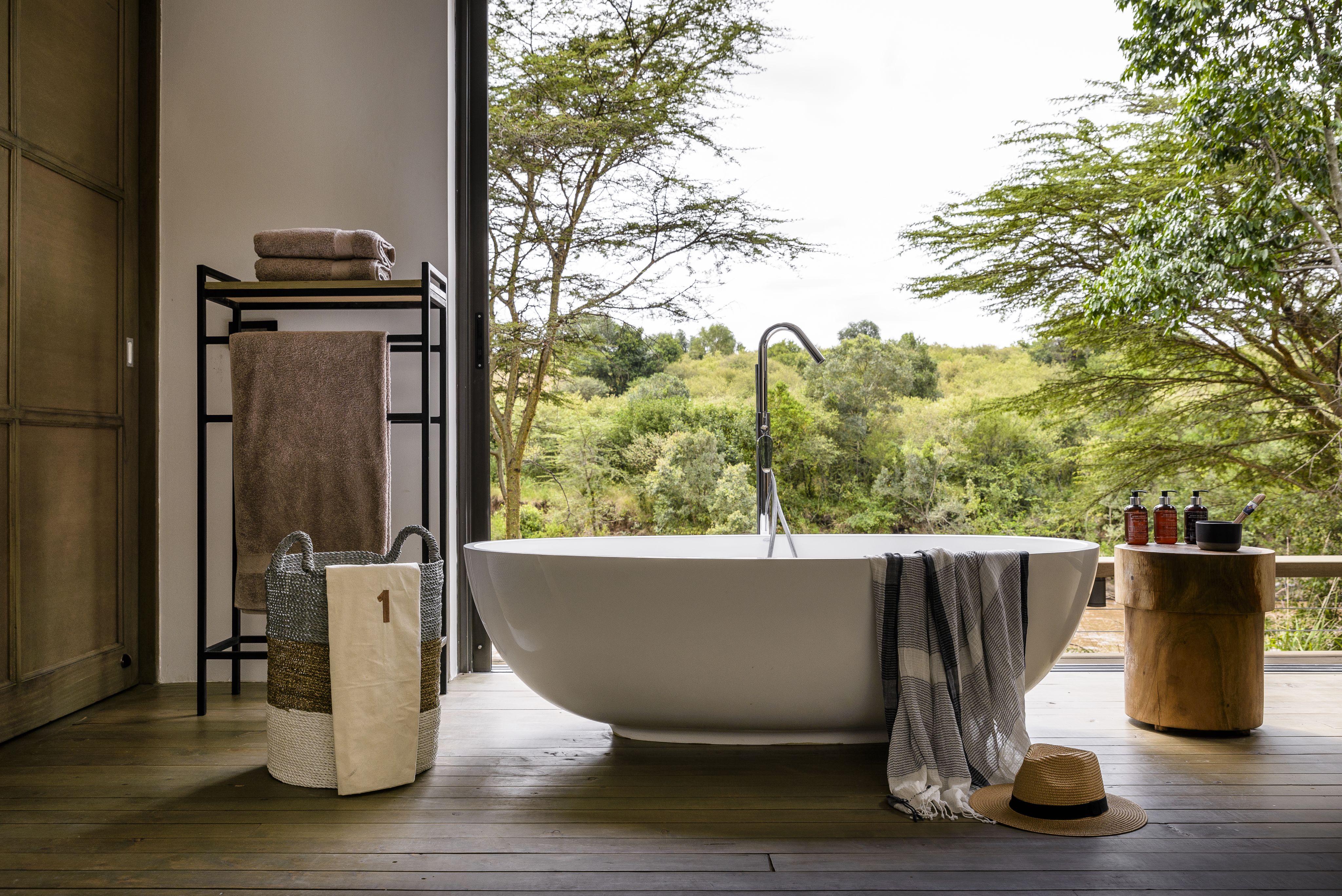
Bathtubs may not be at the top of your list of priorities when choosing where to go on holiday, but one thing’s for certain: they can offer a whole lot more than a place to freshen up. So much so that these destinations have given them a prime location. Be warned, you may never want to step out of these fanciful tubs.
Olonana, Kenya
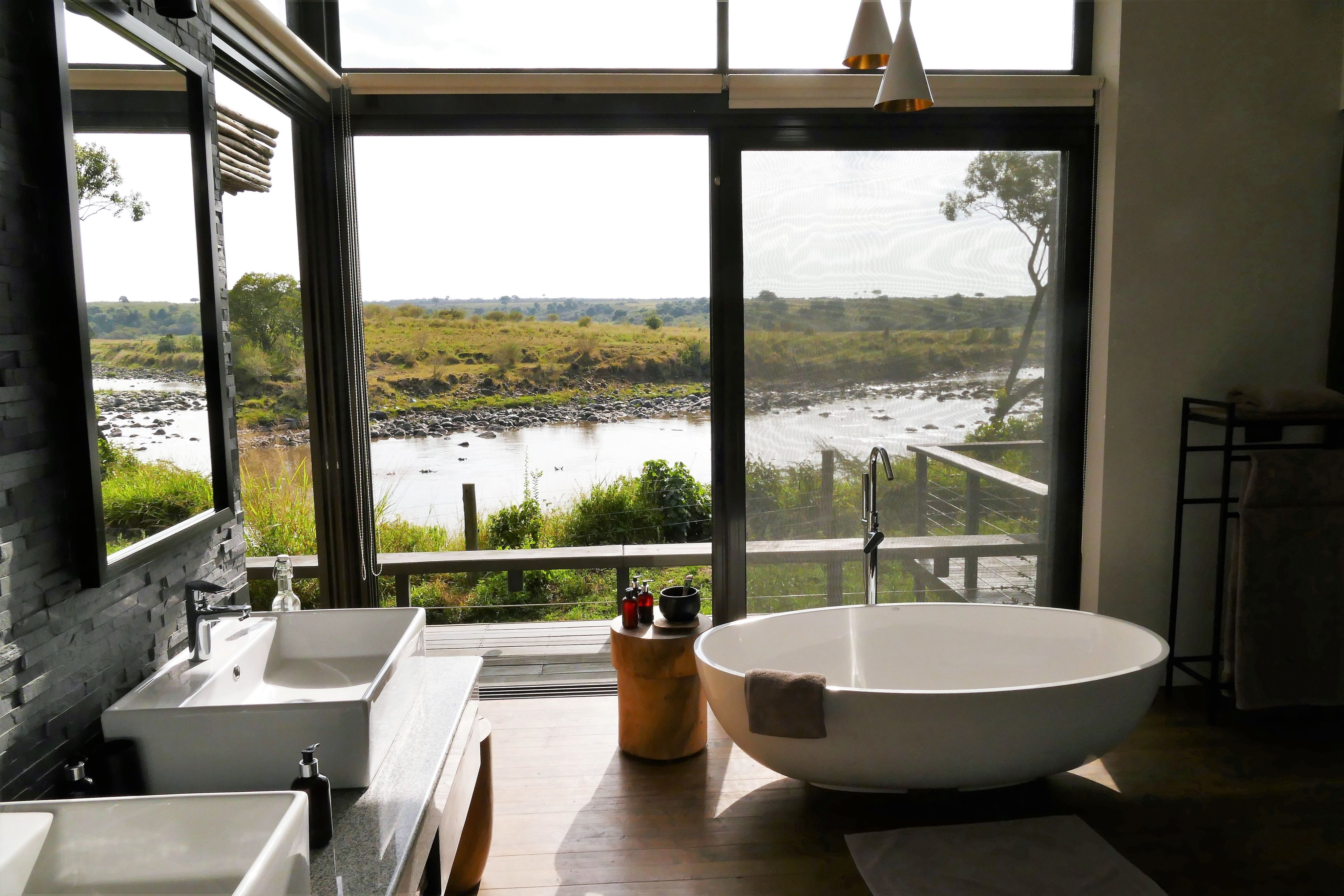
Safari-goers have long recognised Kenya’s Masai Mara as the game-viewing centre of Africa. The country is considered the birthplace of the modern safari, placed on the map by luxury travel operator Abercrombie & Kent, which this year celebrates its 60th birthday with, among other things, a total refurbishment of its Olonana safari lodge. It is situated in Kenya’s section of the Great Rift Valley, a series of geographic trenches stretching from Somalia to Mozambique.
A stay in the heart of this game reserve provides the best of all worlds. An exceptional lodge set on a private stretch of the Mara River, it features 14 super spacious glass-sided suites, inspired by the Masai Mara’s natural wonders: an abundance of wildlife and a dramatic river that runs right through the lodge’s forest setting – all viewable from your bathtub.
Game drives, cultural visits to the local Masai village, delightful bush dinners, scenic sundowners and thrilling balloon rides make for a fabulous African safari, and Olonana is one of only a handful of properties in Kenya to be Gold Eco-Rated by Ecotourism Kenya.
The new Geoffrey Kent Suite is a free-flowing space containing two private en-suite bedrooms, accessed via a private pathway. It is hugely popular for those wanting to travel in a private bubble and has the best bath with a view in the bush.
www.sanctuaryretreats.com
Amanzoe, Greece
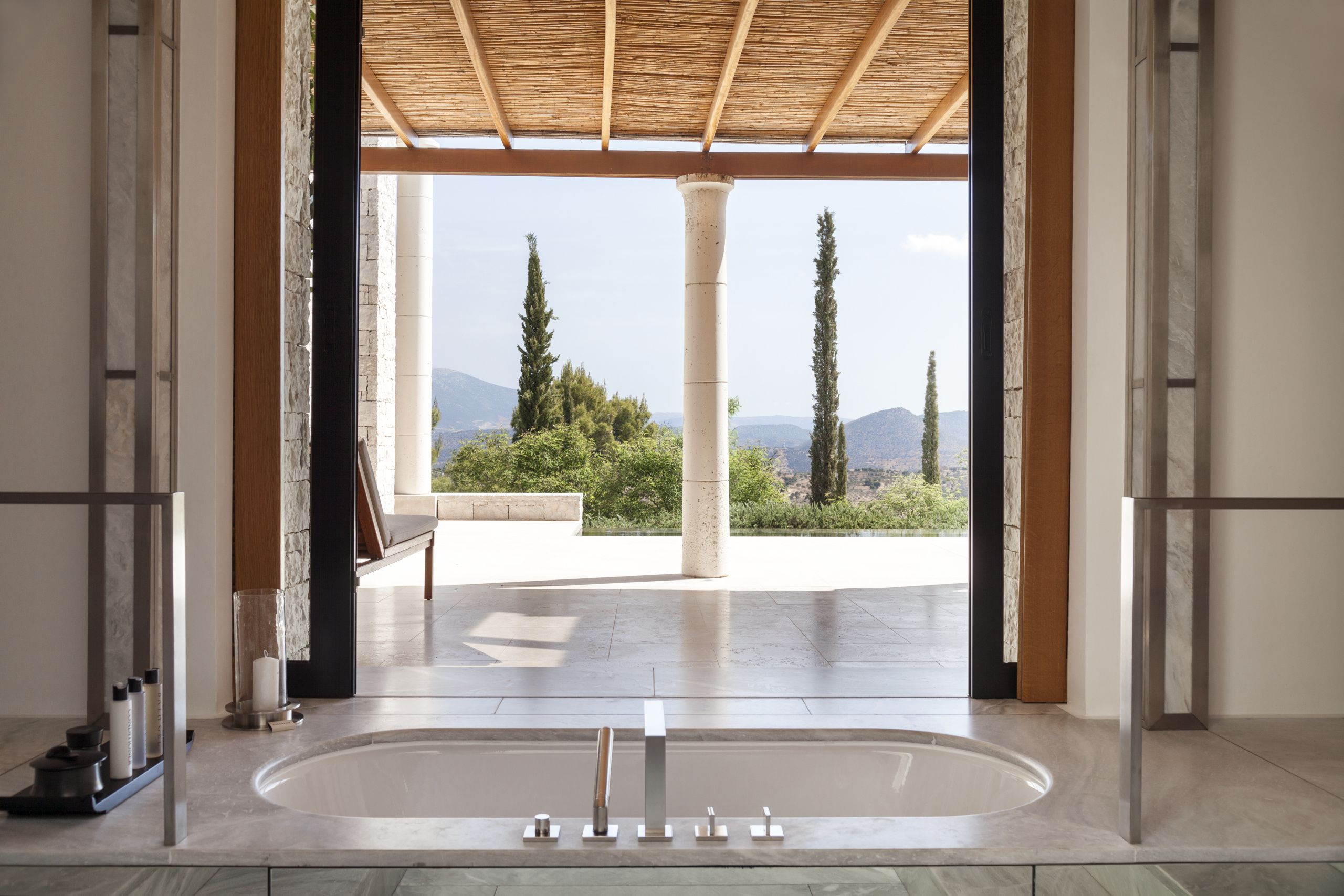
The views from the bathtub at Amanzoe generate contradictory feelings of don’t-want-to-move calm and a yearning to explore Ancient Greece.
The property sits on a secluded hilltop with 360-degree views of the Peloponnese countryside. It is within easy reach of a wealth of archaeological sites, while the cosmopolitan island of Spetses, renowned for its seafaring traditions and Venetian and neoclassical architecture, is a short boat ride away.
Amanzoe’s pavilions and villas open on to expansive private terraces, creating a seamless extension of the airy interiors and a sense of space and seclusion.
The nine-bedroom villa is ideal for total privacy or family gatherings. Spread over six levels with two infinity pools, it has several indoor-outdoor living and dining areas, and its own spa with a sauna, steam bath, gym, yoga platform and two treatment rooms.
Trekking in the Peloponnese landscape is a bucolic delight. Local favourite walks include a gentle stroll to paleolithic Franchthi cave, reached by a coastal path only 20 minutes’ drive from Amanzoe. Or for a longer adventure, explore a two-hour trek from the mountain village of Iliokastro through the pine forest to Fourni village, or take the circular trek from Fourni to Katafiki Gorge. Then feast on the region’s famous citrus fruits, sweet olives and assorted seafood, or visit a local beekeeper and honey museum.
You can go island hopping in one of Amanzoe’s high-speed watercrafts for a tour of the uninhabited isles and secluded coves that lie off the coast of the Peloponnese peninsula. Or take a trip to Hydra, a car-free island famed for its vibrant dining and nightlife scene. If you can bear to leave your tub, that is.
www.amanzoe.com
Hilton Molino Stucky Venice
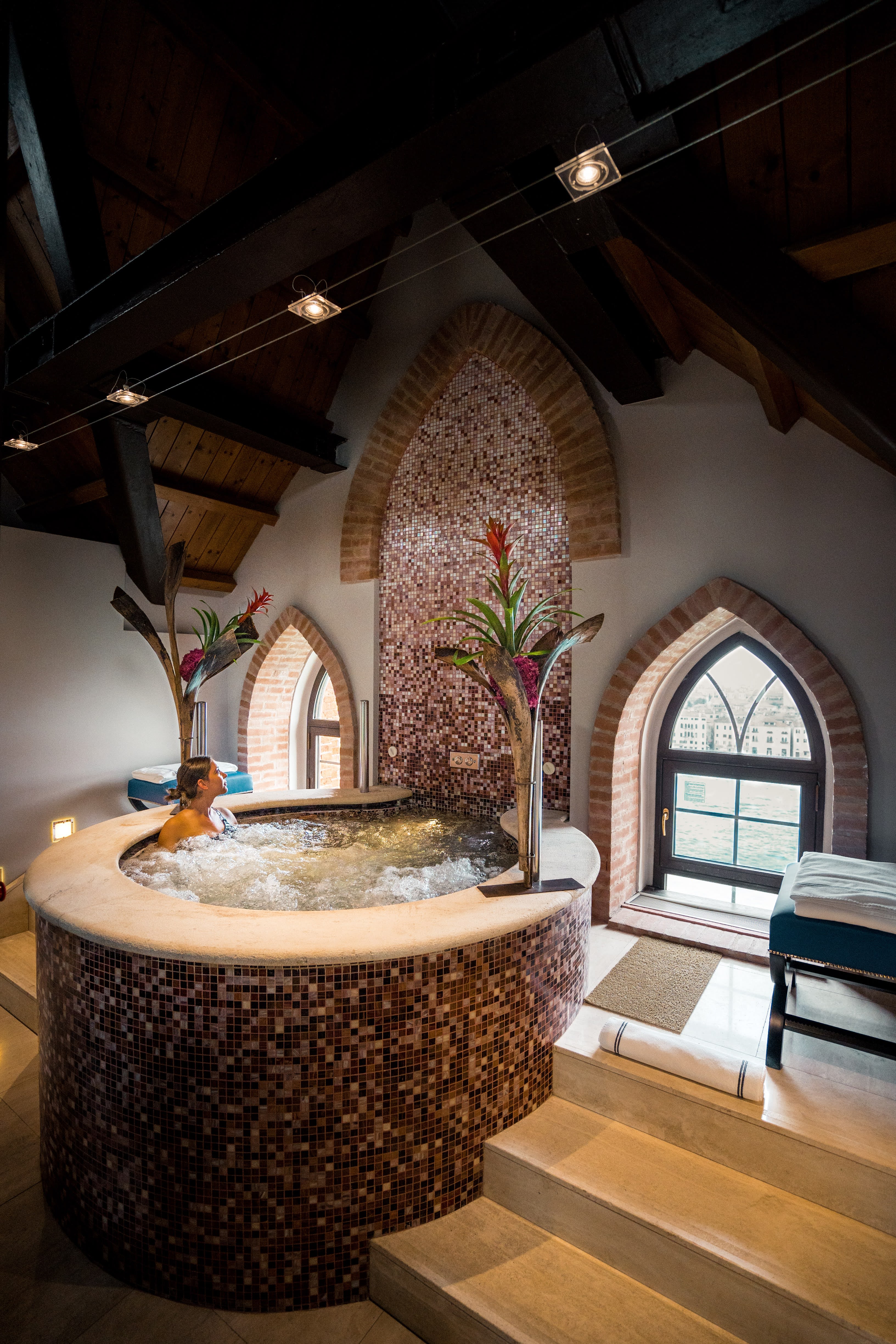
Arriving at Hilton Molino Stucky Venice in a classic Riva water taxi is the ultimate way to make an entrance. Pure drama, pure grace. Situated on the peaceful island of Giudecca, Hilton Molino Stucky Venice is a modern masterpiece. Formerly a flour mill, the listed building has been beautifully restored with a series of recent refurbishments – including the spacious suites, which boast spectacular views of the picture-perfect Renaissance city.
The new presidential suite is the highest and largest in town. It offers private access to the rooftop, which houses one of the city’s rare swimming pools, along with a Skyline Bar, also the highest in Venice, and offers incredible sunset views across a skyline of domes, spires and towers. A few steps higher still, below the rafters of the tower, the suite’s private bathtub looks out through historic arched windows. Possibly the City of Water’s most romantic spot.
This five-star hotel on the water offers one of the largest spas in Venice, with a superb traditional flour scrub, a nod to the building’s heritage. Next door lies the much-celebrated Fortuny building and gardens, showcasing the printed textile genius of Spanish artist Mariano Fortuny.
www.hilton.com
The Newt, England
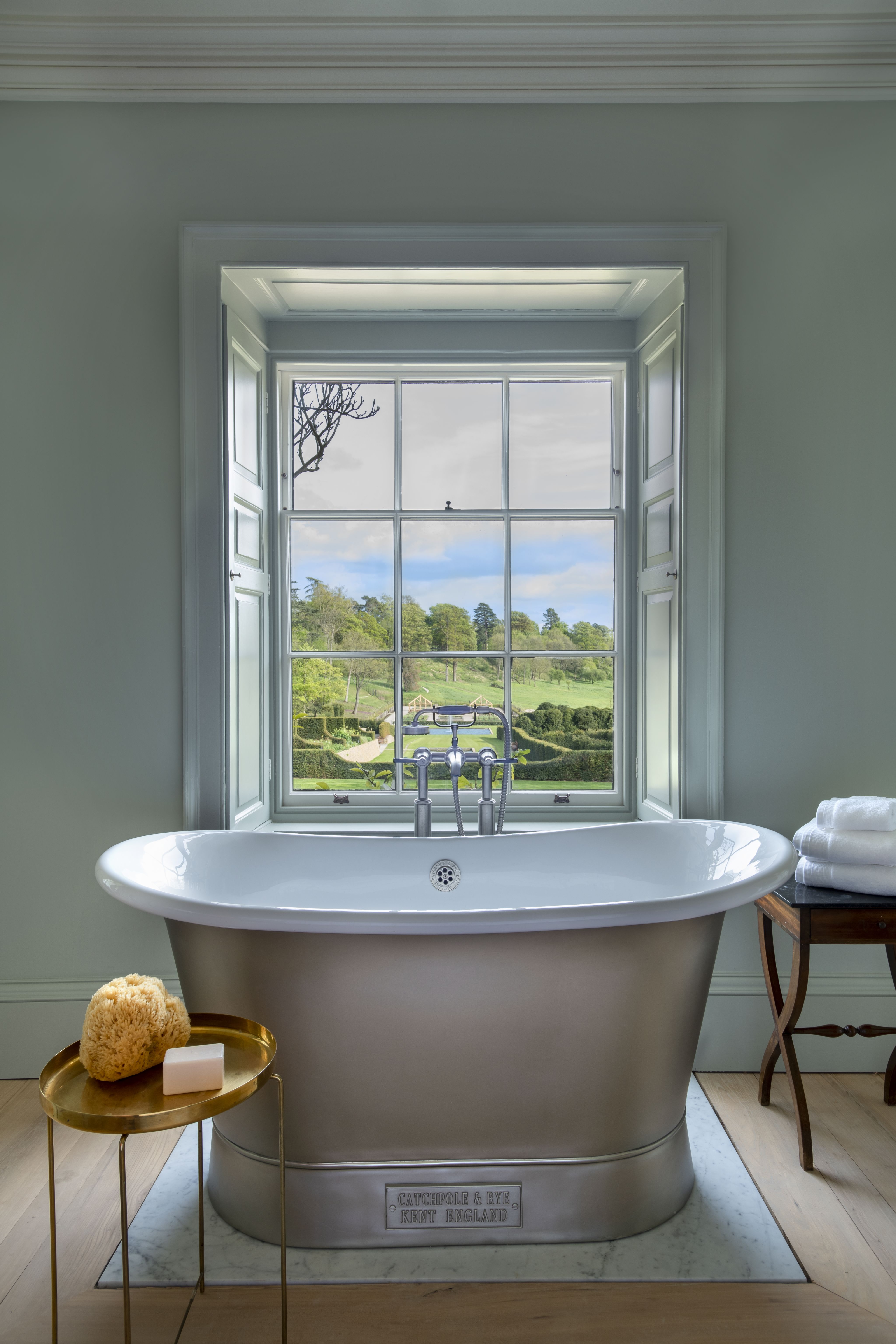
With a focus on all things local to celebrate the history and heritage of Somerset, the notable estate and gardens of The Newt have been lovingly transformed by Karen Roos, owner of the award-winning Babylonstoren in South Africa’s Franschhoek valley.
With a focus on locality and sustainability, everything stems from a deep respect for the land, its animals and the environment, as well as a passion for horticulture and agriculture.
Capturing the essence of a Georgian country home and historical gardens, the 23-room hotel is set within a Grade II*-listed building and stable yard. It includes a world-class spa with an indoor and outdoor swimming pool, gym, bar and various restaurants. Overlooking the gardens, the Hadspen suites have traditional roll-top baths – perfect for taking a soak in front of splendid Georgian sash windows while you gaze out over the estate.
It’s the gardens that take centre stage. Hectares of formal grounds designed by renowned Italo-French architect Patrice Taravella are cared for by an expert team. Everywhere you look, the past is brought to life or reimagined by offsetting heritage elements with contemporary design, styling and architecture.
www.thenewtinsomerset.com
Iniala Harbour House, Malta
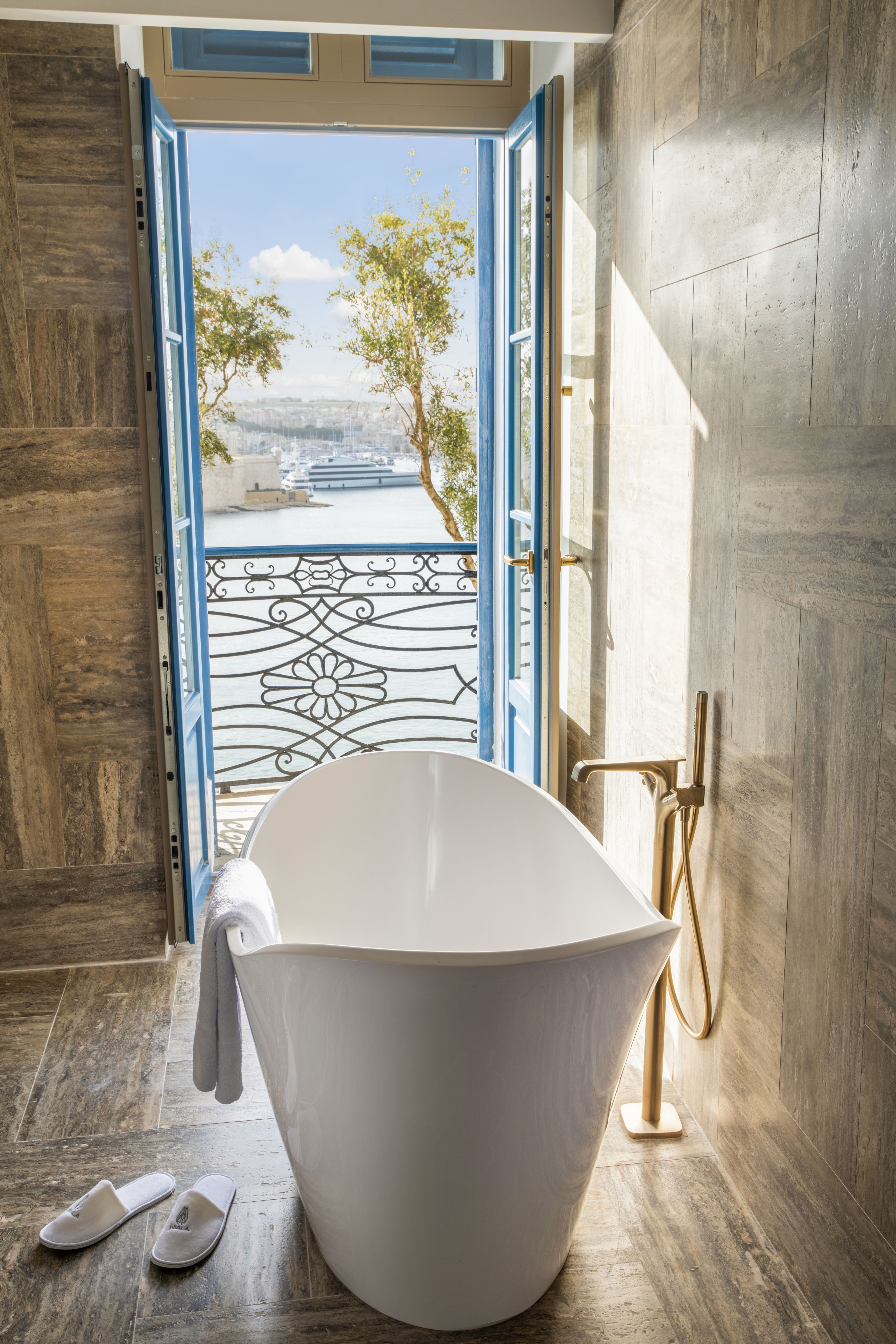
Iniala Harbour House epitomises the ambitious vision of owner and philanthropist, Mark Weingard, who fell in love with Malta’s capital, Valletta, many years ago.
Weingard decided that the combination of peace, privacy and incredible sea views found in the St Barbara Bastion neighbourhood made it the ideal spot for his property.
The view from your Maltese bath is timeless: living history kept alive by hundreds of years of preservation. Spread over four historic Maltese houses and their ancient vaults below, Iniala offers 23 uniquely designed rooms and suites across The House, The Residences and The Hideaway, with spacious sitting rooms, an indoor pool in a hidden vault, a spa and gym facilities.
ION-The Harbour, the hotel’s rooftop restaurant overlooking the Grand Harbour, was awarded its first Michelin star within six months of opening and head chef Andrew Borg aims to create a “unique dining experience that ventures beyond the usual boundaries of fine dining”.
Valletta is extremely walkable and is perfectly located to explore the “three cities”, a collective description of the fortified Vittoriosa, Senglea and Cospicua. It’s also a great base from which to discover Malta’s beautiful beaches and the incredible, clear waters of Gozo and Comino islands.
Iniala offers VIP access to whatever interests its guests – from an after-hours visit to view the famous Caravaggio by candlelight in the Co-Cathedral to an access-all-areas tour of Valletta.
Other options include a day trip on the hotel’s Riva to the clear waters surrounding Gozo with a gourmet picnic, or an exploration of the marine life with a top underwater photographer.
www.inialamalta.com
Gili Lankanfushi, Maldives
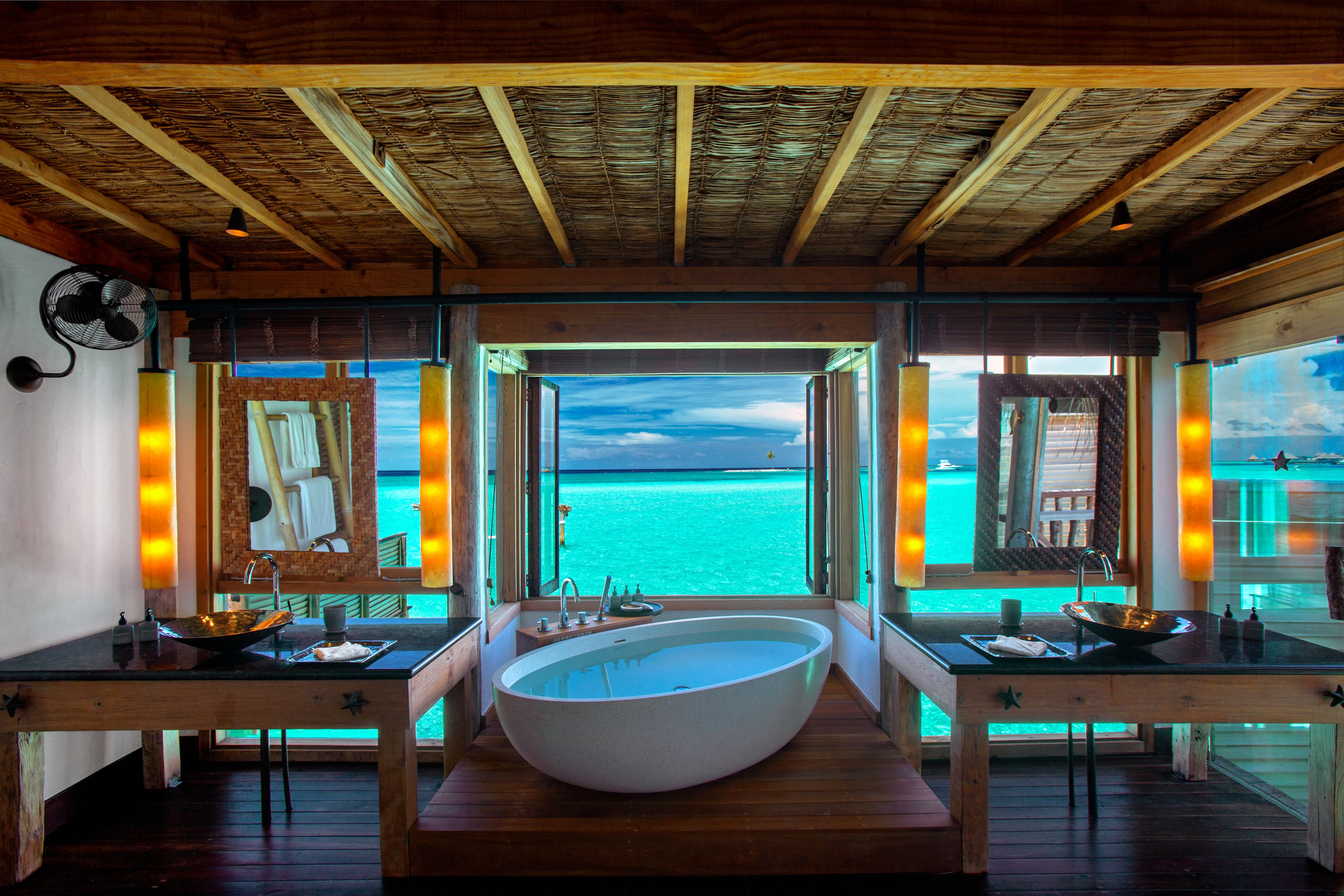
No news and no shoes: that’s the rule at Gili Lankanfushi in the Maldives, where the only bulletin is whether or not dolphins showed up during a boating or diving trip.
Gili Lankanfushi is set in a hard-to-rival location: a little island in a large lagoon in the North Malé atoll, a 20-minute speedboat ride from Malé itself. The toughest trial of the day is leaving your tub, which stares out over the calming turquoise waters of the Indian Ocean.
The rustic-chic design is inspired by the resort’s natural surroundings, with glass floor panels offering a glimpse of the corals blooming below.
Well-being and balance are central to Gili Lankanfushi’s ethos and Meera Spa offers holistic healing in a spectacular overwater setting. A range of activities, including meditation, reiki, crystal healing and ancient singing bowl sessions, supplement the spa treatments, which draw on Ayurveda and ocean and healing therapies.
Across the resort, a warm, neutral colour palette is complemented by flashes of locally sourced turquoise fabrics, and every piece of furniture is custom made by craftsmen using upcycled materials, including bed frames made from recycled teakwood and lampshades handwoven with recycled wire mesh to depict fish and sea turtles.
www.gili-lankanfushi.com
God save the Quinn
Queen Elizabeth II has attended one of his shows and he has created wedding gowns for Saudi royalty, but British designer Richard Quinn is as humble as ever, writes Francesca Fearon
Richard Quinn hit the front-row jackpot in February 2018 when Queen Elizabeth II attended his first official London Fashion Week show. This is the only fashion show she has ever attended, and afterwards she presented him with the inaugural Queen Elizabeth II Award for British Design.
It is fitting, therefore, that we should meet at the jubilee pop-up boutique that he has designed to celebrate not only the queen, but British fashion, at Bicester Village, the value retail shopping destination outside Oxford in the UK. The Creative Spot x British Fashion Council brought together leading talents in fashion and jewellery in a showcase surrounded by giant daisy-printed decor, including a daisy-cover Mini and telephone box (both idiosyncratically British) and a pair of sculpted corgis, a nod to the queen’s favourite pets.
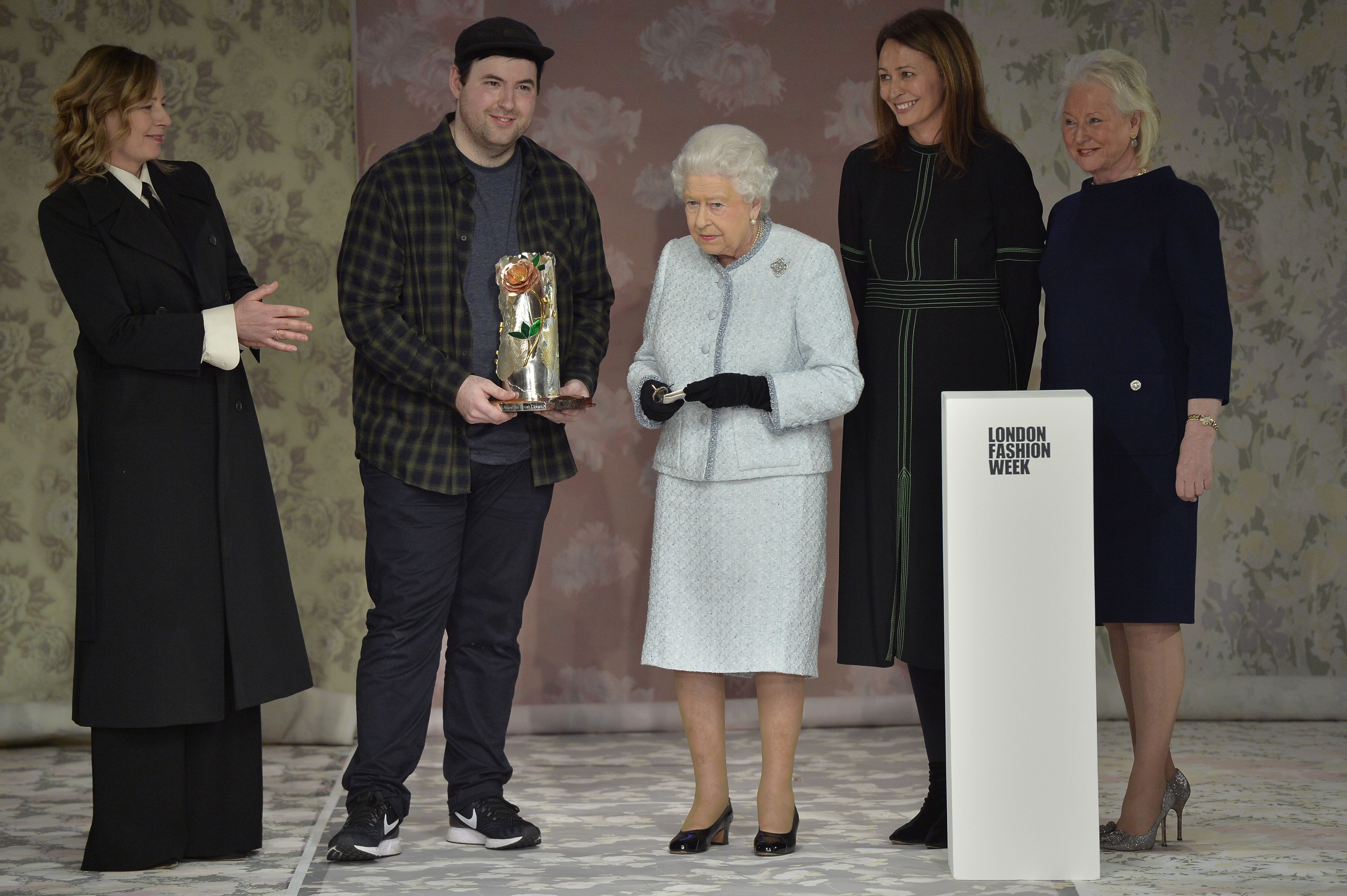
Richard Quinn was awarded with the inaugural Queen Elizabeth II Award for British Design. Photos: Richard Quinn
Richard Quinn was awarded with the inaugural Queen Elizabeth II Award for British Design. Photos: Richard Quinn
The amplified floral prints are a Quinn signature, as are his voluminous gowns and maximalist use of all-over colour and print – everything matching, right down to the shoes and squashy bags, and all delivered with a couture-like sensibility. His autumn collection, unveiled at London Fashion Week last February, was presented in a large, pink-draped, carpeted ballroom, with the English Chamber Orchestra playing the Adagio for Strings in the background.
Those trademark prints and that royal stamp of approval have garnered the designer immediate status in fashion circles, drawing clients such as Amal Clooney, who wore a Richard Quinn floral overskirt and cigarette pants to the Met Gala in 2018, Lady Gaga, Jennifer Lopez, Kendall Jenner, Billy Porter and a Saudi princess who commissioned her wedding dress from him last year.
Surprisingly, the bride’s gown was not smothered in florals. “It was completely different from what we are known for – print. It was fully gold and embroidered,” says Quinn. Unlike the prints, embroidery is a less obvious feature of his work, mostly delicate details added to give sparkle to a floral motif.
He explains how, after large social events he would receive requests from four or five other ladies that were attending, for the same look his client was wearing, or something similar. His burgeoning private customer base has brought a lucrative stream of clients from the Middle East, which is crucial for young designers establishing themselves.
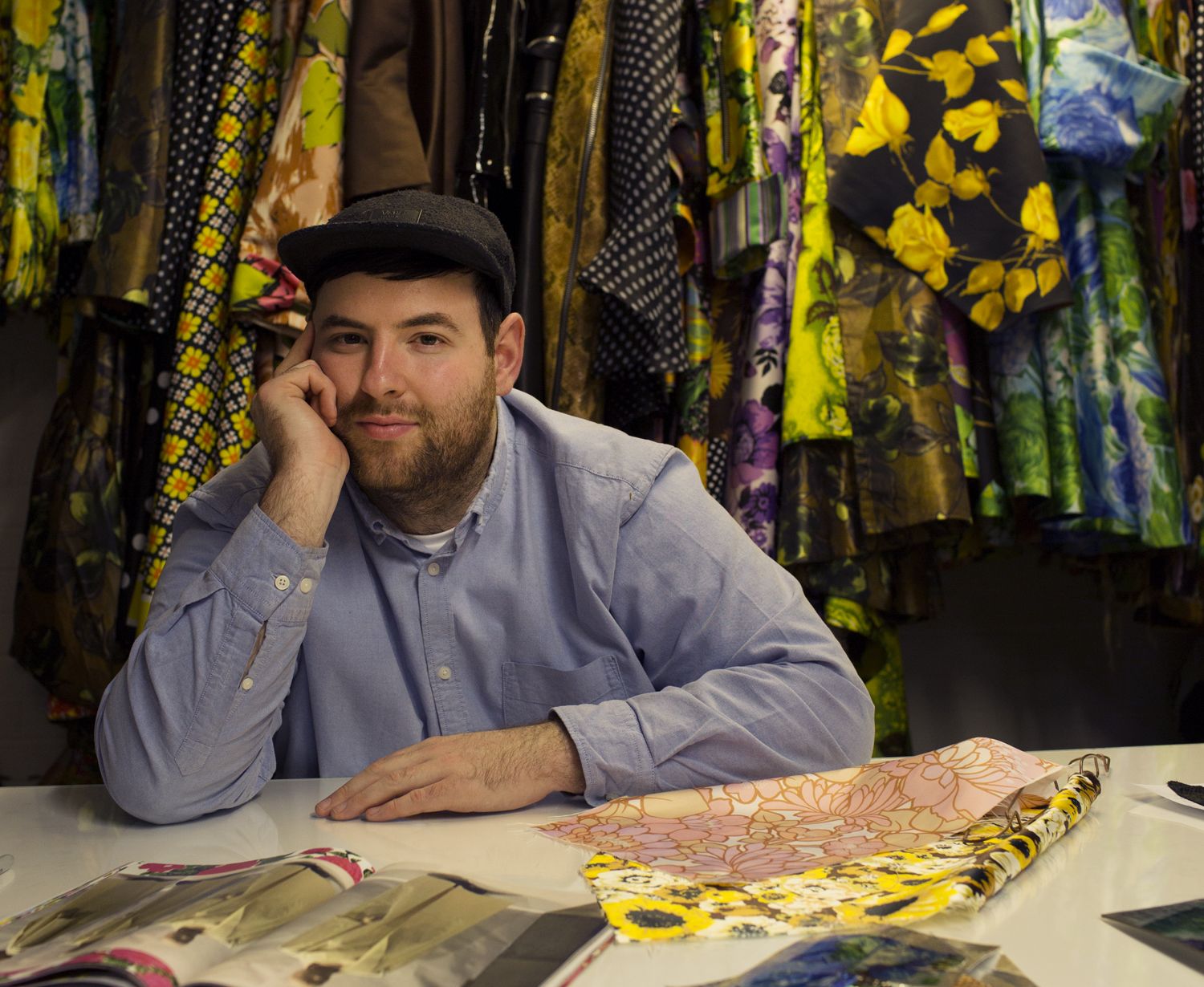
Designer Richard Quinn. Photo: Richard Quinn
Designer Richard Quinn. Photo: Richard Quinn
“There are lots of outfits in the Middle East that you would never know we had made,” Quinn admits. “I think it is because they have an affinity for things that I really like, such as glamour. The things that we make are quite conservative – but forward-thinking in a way, in terms of the volumes.
"I am not aiming to design with bespoke in mind, but it seems to come naturally to us with the luxurious silks and the feathers. And we love the kind of glamour that they want to wear.”
The queen’s accolade might have helped crystallise the aura that surrounds Quinn and his work, but he wears it lightly. He is humble, warm and sports a ready smile underneath his signature baseball cap and beard. Born in Lewisham and raised in south-east London, Quinn is the youngest of five children.
He always knew he wanted to do something in art and design, and as a teenager became more interested in fashion. Any ribbing from his friends about his choice was “water off a duck’s back; I couldn’t have cared less”, he says.
He studied at Central Saint Martins, graduating in 2014, and then signed up for a Master’s degree, specialising in screen-printing and fashion, and was awarded the Stella McCartney Scholarship.
“I have been lucky; my teachers, people who had worked in the industry and that I looked up to and respected, were very encouraging, and I am always open to feedback.”
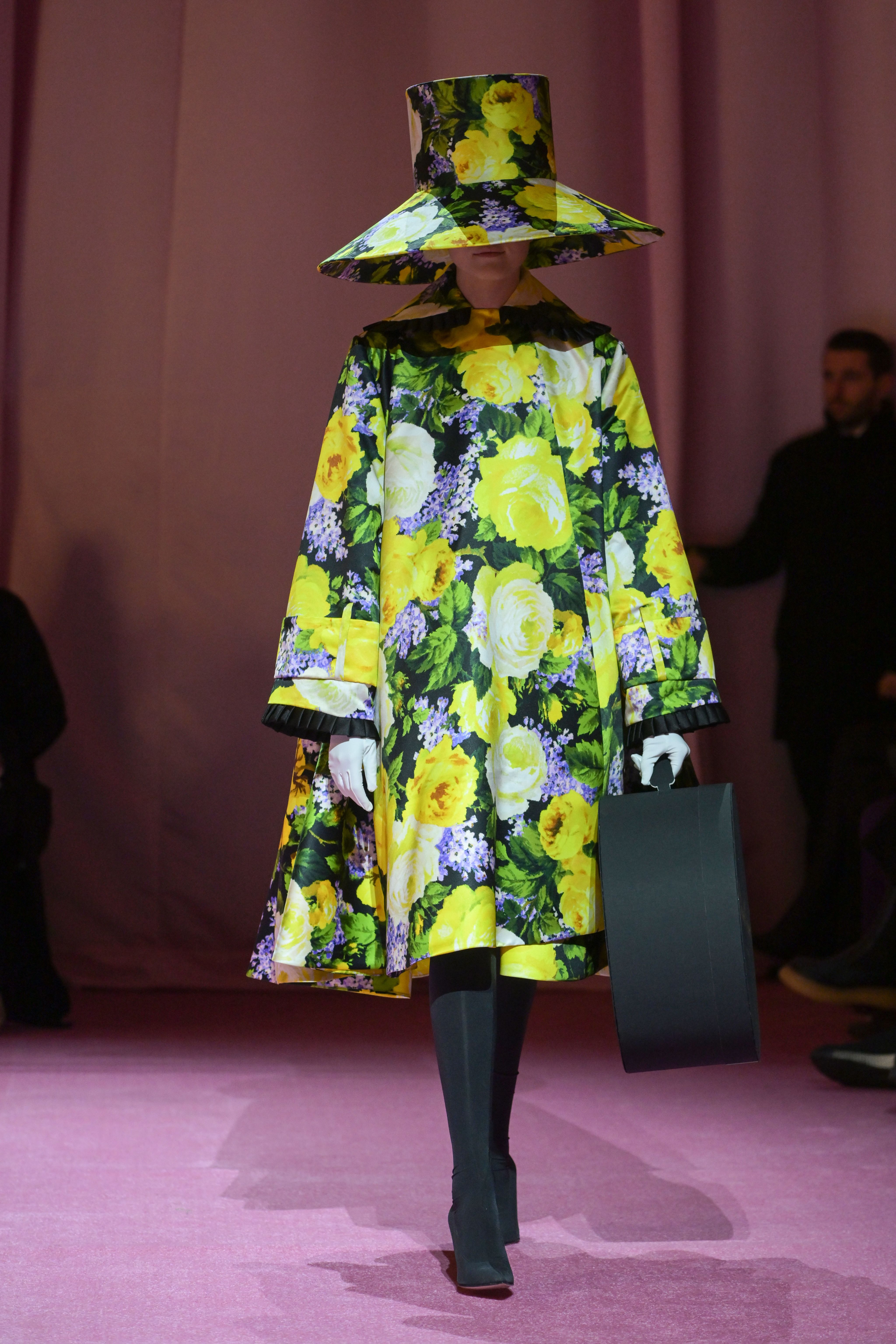
A look from Richard Quinn's autumn/winter 2022 collection. Photo: Richard Quinn
A look from Richard Quinn's autumn/winter 2022 collection. Photo: Richard Quinn
He graduated in 2016 and with the money received from an H&M award, worth about £40,000 ($49,000), opened a print studio underneath railway arches in south London, where he would screen print fabrics for other people – JW Anderson and Burberry have both been clients – while developing his own collections. Liberty London, the fashion and lifestyle store, famous for its ditsy floral-printed fabrics, spotted his talents and offered him their vintage print fabrics and a showcase at fashion week in 2017.
Aside from those exuberant English florals, sometimes in clashing combinations, his aesthetic is often drawn from 1950s couture. He cites Christian Dior as one of his inspirations, another being the avant-garde Thierry Mugler – notably his power-shouldered, cinched-waist silhouettes from the 1980s, and his slick glamour.
But there is something idiosyncratically British about Quinn’s designs, from the fabric through to what he describes as the dark British humour. His use of black latex bodystockings and face masks give his designs a subversive twist, but he says “it’s quite tongue-in-cheek”. That inspiration harks back to his days at Central Saint Martins, when it was still a stone’s throw from Soho.
He works with a small team of seven, including himself, and prefers it that way. He sketches a complete, fully styled look from head-to-toe, with prints and accessories, and that is what ends up on the catwalk. His shapes range from voluminous opera coats and padded jackets to bustier cocktail dresses and bodysuits with hoods.
If he wants big hats, as seen in the new autumn collection, then one of the team researches that. Sometimes a client might offer a suggestion for a design they’ve commissioned that Quinn likes so much that he’ll incorporate it into a collection. The fun bit, he admits, is after the show, when he wonders who will wear a particular look and how that person will take it to a new level and put it in a context that he would never have thought of.

A look from Richard Quinn's autumn/winter 2022 collection. Photo: Richard Quinn
A look from Richard Quinn's autumn/winter 2022 collection. Photo: Richard Quinn
During the pandemic, he and his team converted the studio to make hospital scrubs for the NHS and, instead of catwalk shows, produced a couple of films of his collections. It’s an experience he enjoyed and wants to repeat.
In the five years since his debut, he has produced various successful capsule collections and collaborations with brands such as Moncler Genius, as well as the costumes for Billy Porter’s performance at The Fashion Awards in London last November. He recently secured the BFC/Vogue Designer Fashion Fund, which comes with a cash prize of £200,000. He says he actually entered the competition to secure the invaluable industry mentorship that comes with it, to help him develop his e-commerce business.
Of the jubilee project with Bicester Village and the BFC, he says: “I think if you do collaborations, it has to be the right fit and it’s a trade off, to reach audiences that perhaps wouldn’t know us, but they see the clothes, try them on and could go on to be a customer buying at full price.” The project, he adds, “was a natural fit because of the queen’s award and the jubilee. I feel as though we have come full circle.”
When asked about his recollections of that day the queen sat front row, he says how surreal he still finds it. “I was told a few days in advance: it was very hush-hush and so we made a few classic head scarves, which were tied on masked models, which was a bit of a nod to Balmoral [the queen’s Scottish home] for the show. The day was crazy, and the memory is one big haze now,” Quinn says.
However, he feels an affinity for that part of British tradition and heritage, having been brought up in London with childhood visits to the Tower of London and Buckingham Palace, and surrounded by the pageantry of the British royals. Asked how he spent the queen’s jubilee weekend, he says: “We had a big family party.”
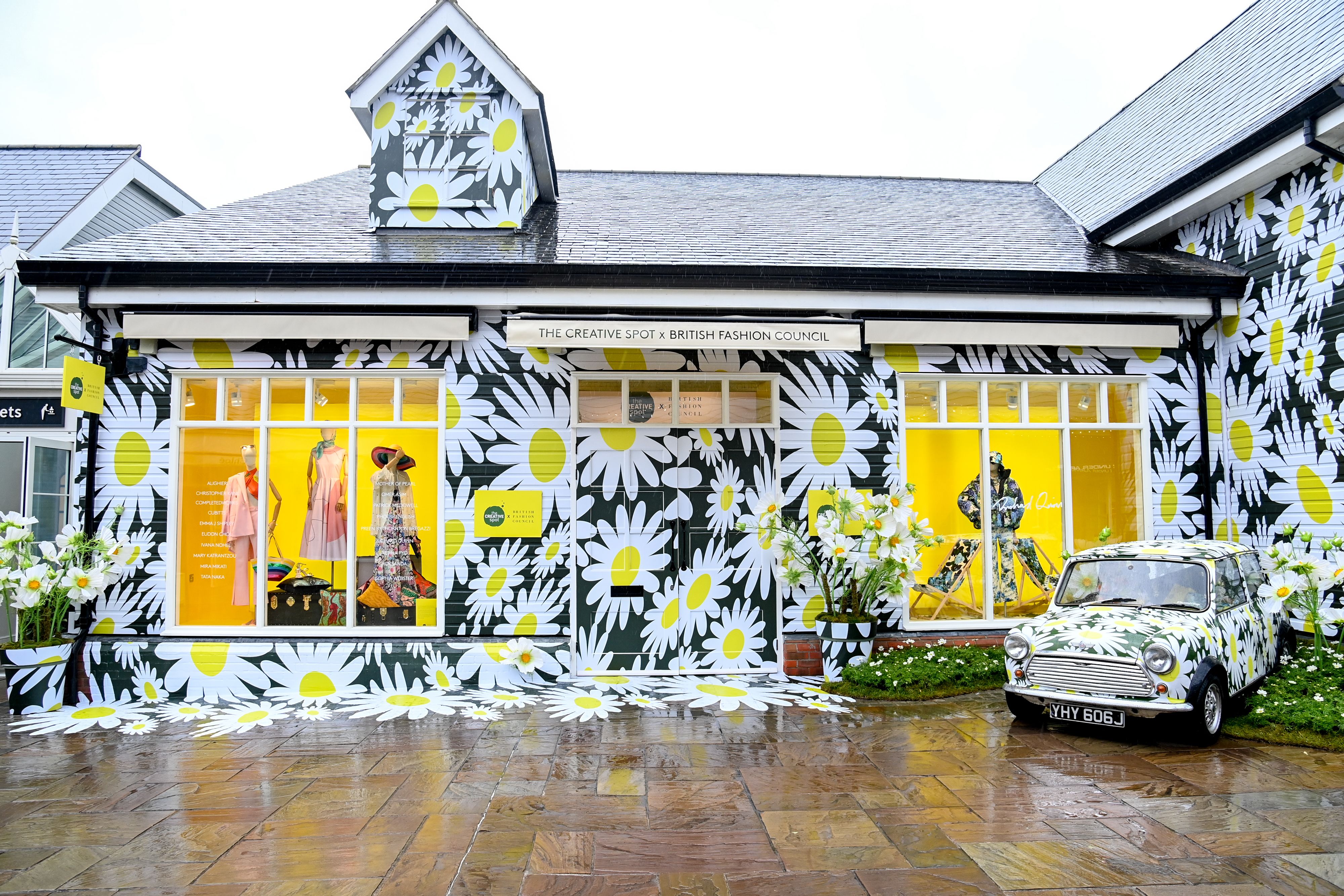
A return to canvas

At the age of 84, after a 50-year hiatus, restaurateur to the stars Michael Chow is painting again. With a solo exhibition of his works currently on show at Sotheby’s Dubai, he tells Razmig Bedirian why art is for old men and restaurants should be run like musical productions
When the famed restaurateur Michael Chow talks about his favourite painters, it is always their later works that he is most impressed by – the tempestuous landscapes of JMW Turner, the Black Paintings of Francisco Goya or the soul-searching of Rembrandt’s portraits.
The works, Chow explains, are rendered with a finesse that only comes with age and experience. “In the words of Barnett Newman, painting is for old men,” he says.
This is perhaps why Chow, 84, gave up on painting in his younger years, and why he has feverishly returned to it in the past decade. All the same, Chow has been a prominent figure in the art world since the Swinging Sixties, although known more for his artistry in the restaurant business than on canvas. He has been dubbed by media as the “restaurateur to the stars” and has had his portrait painted by the likes of David Hockney, Jean-Michel Basquiat and Andy Warhol.
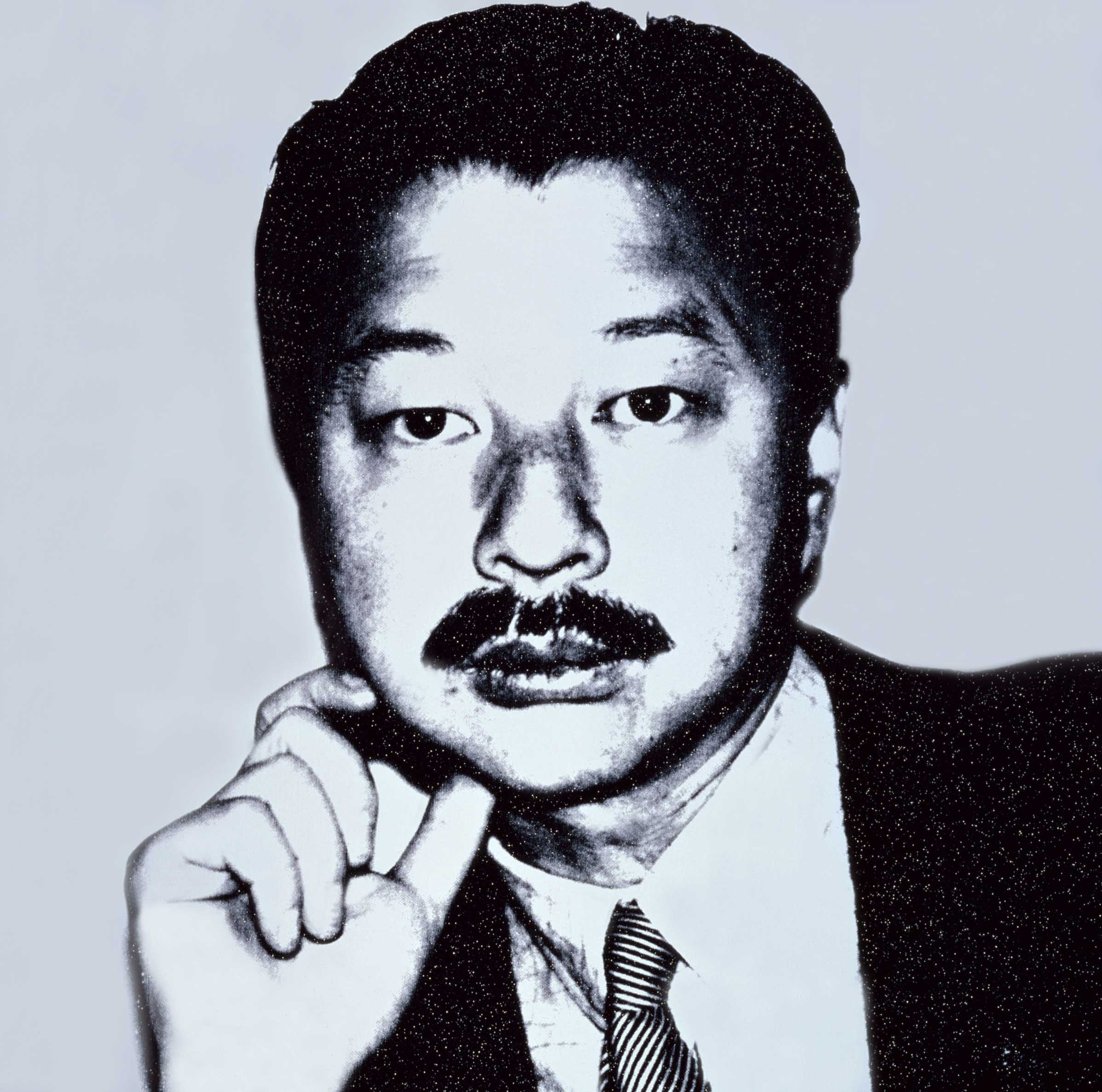
Andy Warhol's portrait of Michael Chow. Courtesy The Andy Warhol Foundation for the Visual Arts; Licensed by Artists Rights Society (ARS) New York
Andy Warhol's portrait of Michael Chow. Courtesy The Andy Warhol Foundation for the Visual Arts; Licensed by Artists Rights Society (ARS) New York
Chow feels now is his time to be on the other side of the canvas, and to use the medium to reflect on the shared principles that drive him in art and the culinary sphere. A collection of his paintings is currently being presented at Sotheby’s Dubai.
Ending on July 1, the solo exhibition, titled One Breath, is presented under Chow’s artistic moniker M, and while that nominally separates him from his Mr Chow persona, the man behind his eponymous series of upscale restaurants in the US and England, the intuitive impetus he brings to the canvas is in the same vein as his approach to the food business.
The exhibition comprises two sections. The first floor consists of a series of large-scale mixed-media canvases, each created using a wide variety of precious and household materials, including gold leaf and silver, paint sheets, acrylic, plastic and other found items. The second floor features a series of works on paper.
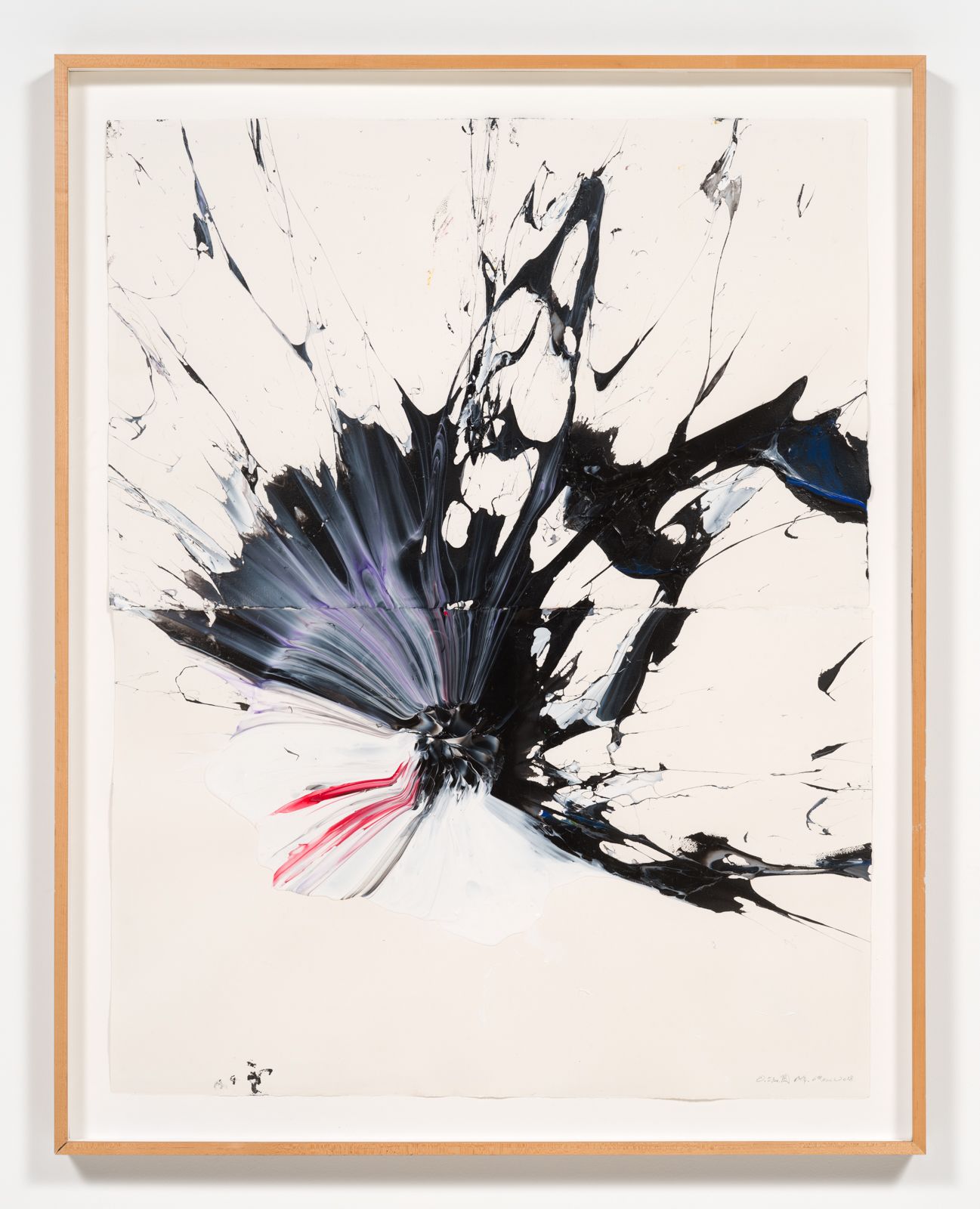
One Breath No. 8, 2018. Photo: Sotheby's
One Breath No. 8, 2018. Photo: Sotheby's
One Breath incorporates the past, present and the future not chronologically, but as a unified time plane encapsulated in a single second. The title refers to that point when the hammer, Chow’s preferred painting tool, is applied to paper without hesitation or, as the show’s official release describes it, “an exhalation that creates, with that spontaneous and poetic gesture, a vision of humanity’s relationship to nature and the infinite, a meditative state of higher consciousness”.
The exhibited works combine European and American approaches to abstract art with Chinese conceptions of space, texture and performance. For his entire adult life, Chow has existed and thrived in the gradient between English and Chinese cultures. To understand his desire to bridge both worlds, one must go back to when he was 12 years old, travelling from Shanghai to London to attend boarding school.
The year was 1952, and the English capital was on the verge of being smothered by the Great Smog, a disastrous air pollution event that would kill thousands and bring the city to a halt.
In this dim, asphyxiating landscape, young Chow found himself alone, severed from family and familiarity. His parents insisted on sending him to England to escape political unrest in China, but in London he found himself subjected to another unexpected shock.
Passers-by on the street pointed at him, not because they recognised him as the son of celebrated Chinese actor Zhou Xinfang, as they did back in Shanghai, but for the way he looked. They called out slurs, taunted and derided him.
The experience, Chow says, was a rude awakening to a racist world, and he had to endure it alone. Diplomatic ties between China and Western powers had disintegrated in the years after Communist leader Mao Zedong founded the People’s Republic of China in 1949. Chow was unable to reach his family. In fact, he wouldn’t be able to see or talk to his father again.
Chow went on to study architecture at Central Saint Martins and in his early twenties, sought to establish himself as a painter.
He was a fresh architecture graduate, but the harder he worked, learning and applying techniques of the impressionists he was enamoured by, the more disillusioned he became with the art form.
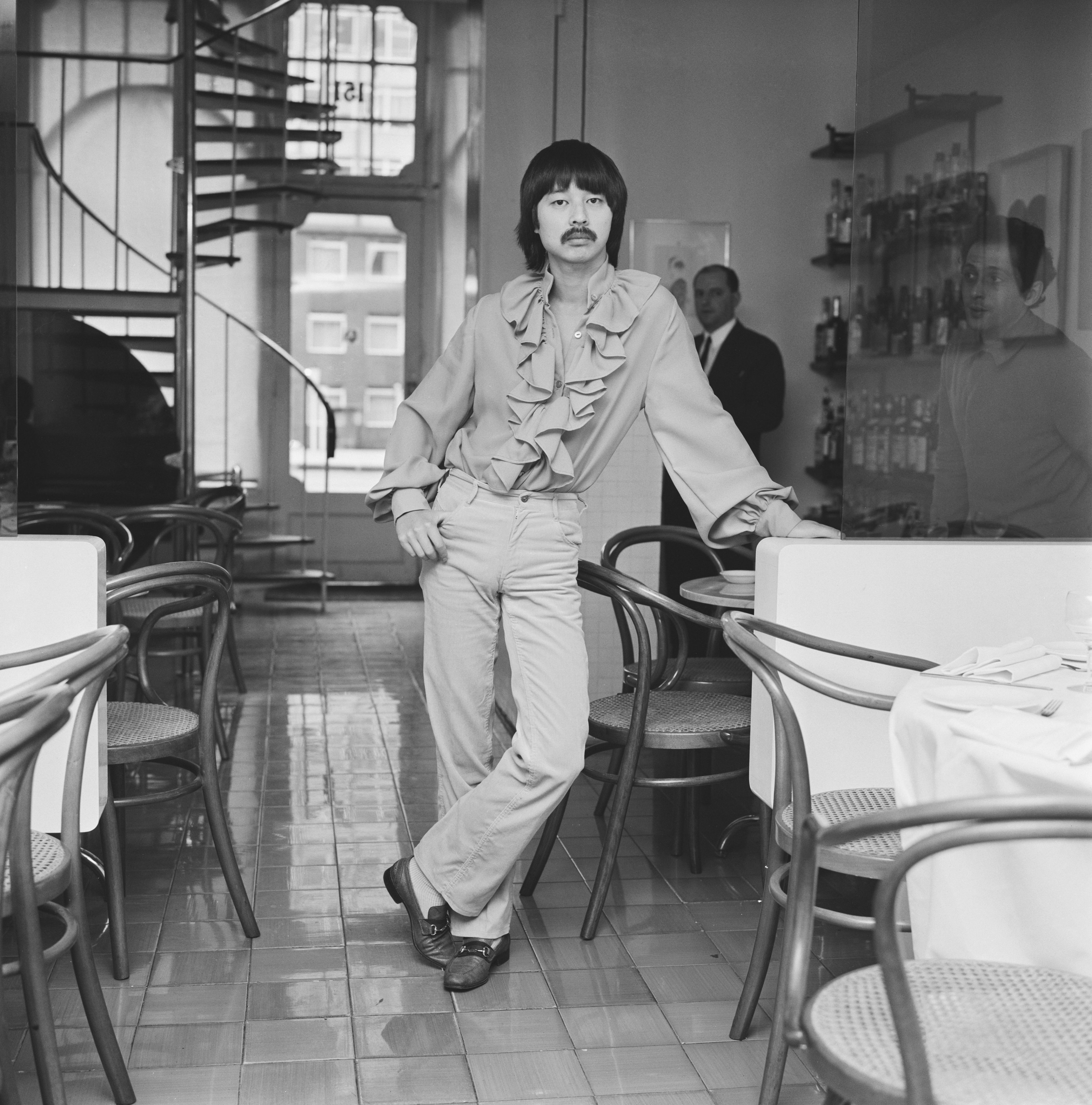
Michael Chow inside his London restaurant in 1968. Getty Images
Michael Chow inside his London restaurant in 1968. Getty Images
It was the early 1960s, and Chinese immigrants, Chow says, were expected to work either in the restaurant or laundry business. He chose the former, but, wanting to show the richness of his culture and usurp prejudices, Chow introduced the theatrics of the Beijing Opera, where his father had been a featured performer, to the Western culinary scene.
The first Mr Chow opened in London in 1968. The restaurant was a springboard elevating English conceptions of Chinese food from being street-side bites to performances on finely garnished plates.
“High-end restaurants had got it all wrong. They weren’t restaurants, they were like banks. Restaurant is closest to a musical. My restaurant is run like a musical. We have a leading man, we have the music, we have the costumes, we have the performance.”
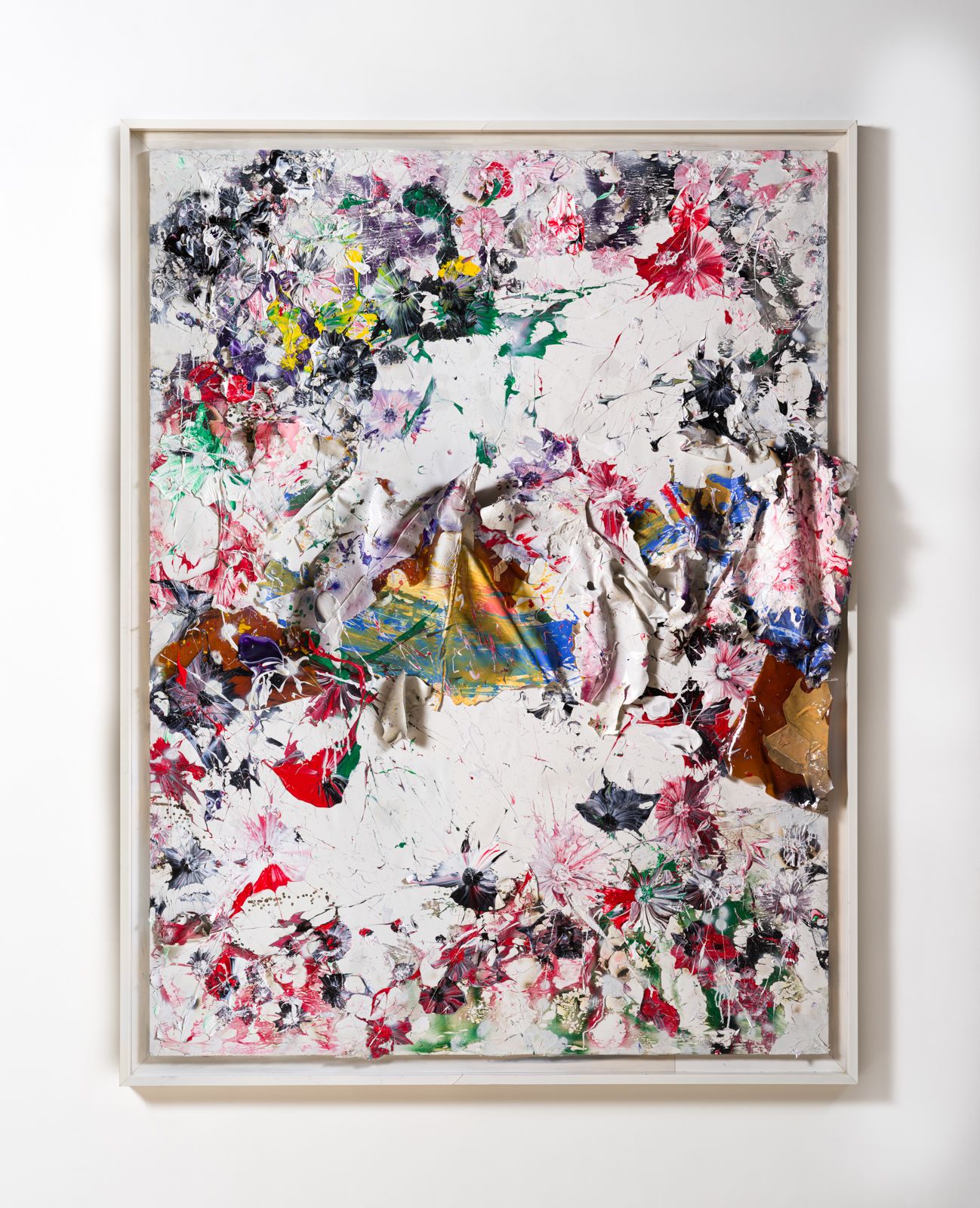
Untitled, 2022. Photo: Sotheby's
Untitled, 2022. Photo: Sotheby's
This boldness is what put Mr Chow at the heart of the Swinging Sixties. Spearheaded by the youth, the cultural revolution during the mid-to-late 1960s pulled London from its postwar gloom and grime, transforming it into a vibrant epicentre of art, music and fashion. This was the era of The Beatles, The Rolling Stones, Mary Quant and Pink Floyd. The US, meanwhile, was going through a similar societal transformation, and when Mr Chow began opening branches in the US, first in Beverly Hills in 1974 and then in New York in 1979, it meant he was catering to cultural visionaries on both sides of the Atlantic.
With the opening of his exhibition in Dubai, Chow reveals his keen interest in this part of the world, and outlines plans to bring his famed restaurant chain to Riyadh next year, and then Dubai. “[The Gulf] is booming with art, especially Saudi Arabia and the UAE. It’s very rich,” he says.
Between its French decor and Chinese cuisine, Mr Chow has always been celebrated for its blend of European and Asian sensibilities, and it is from this overlap that the restaurateur-turned-artist paints.
“My motivation internally has always been more international, less racism,” he says. “Everything I touch, I’m trying to make it international. The more international, the less borders, the less racism. Racism is painful, very painful.”
Riding high
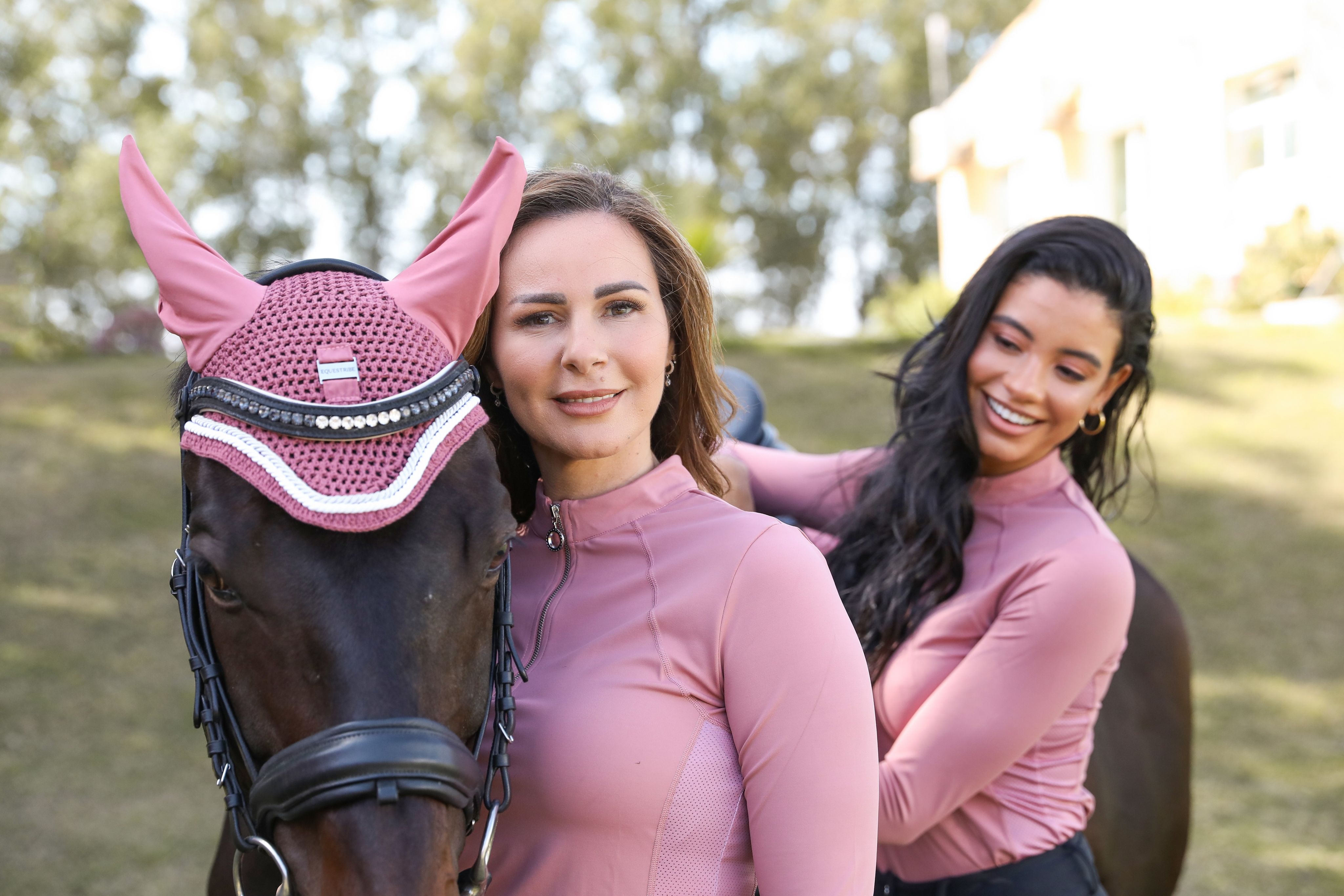
Equestribe is the first homegrown brand for equestrians. Photos: Equestribe
Equestribe is the first homegrown brand for equestrians. Photos: Equestribe
UAE brand Equestribe was born from something of an epiphany.
A self-confessed “horse nerd” and lifelong equestrian, Austrian-Canadian Katharina Mayr was driving to see her horse in Dubai when she realised that, despite a deep-seated horse culture that stretches back centuries, the UAE did not have a single home-grown equestrian clothing brand.
“Having lived in the UAE for several years, I could see a massive gap in the market for a home-grown brand catering to the incredible diversity of both local and expat riders across the region,” Mayr says.
As the world went into lockdown, despite having no previous experience, she began putting her ideas on to paper, sketching out the clothes that she, as a horsewoman, wanted. “Fashion has always been a passion for me, but I never thought of channelling that passion into a real-life project.”
That project became Equestribe, an e-commerce site that offers contemporary, functional riding wear designed with the unique needs of the region in mind. Mainly, she explains, she understood the importance of clothing created for Middle Eastern weather. “Adapting today’s equestrian fashion to the needs of our climate was one of our critical objectives during the design and trial phase.”
A rider herself, well used to the physicality involved, she knew anything she created had to be practical and, above all, comfortable to wear. “Our products are designed after a comfortable fit/maximum functionality principle, so our fabrics are lightweight, quick-drying and moisture-wicking.”
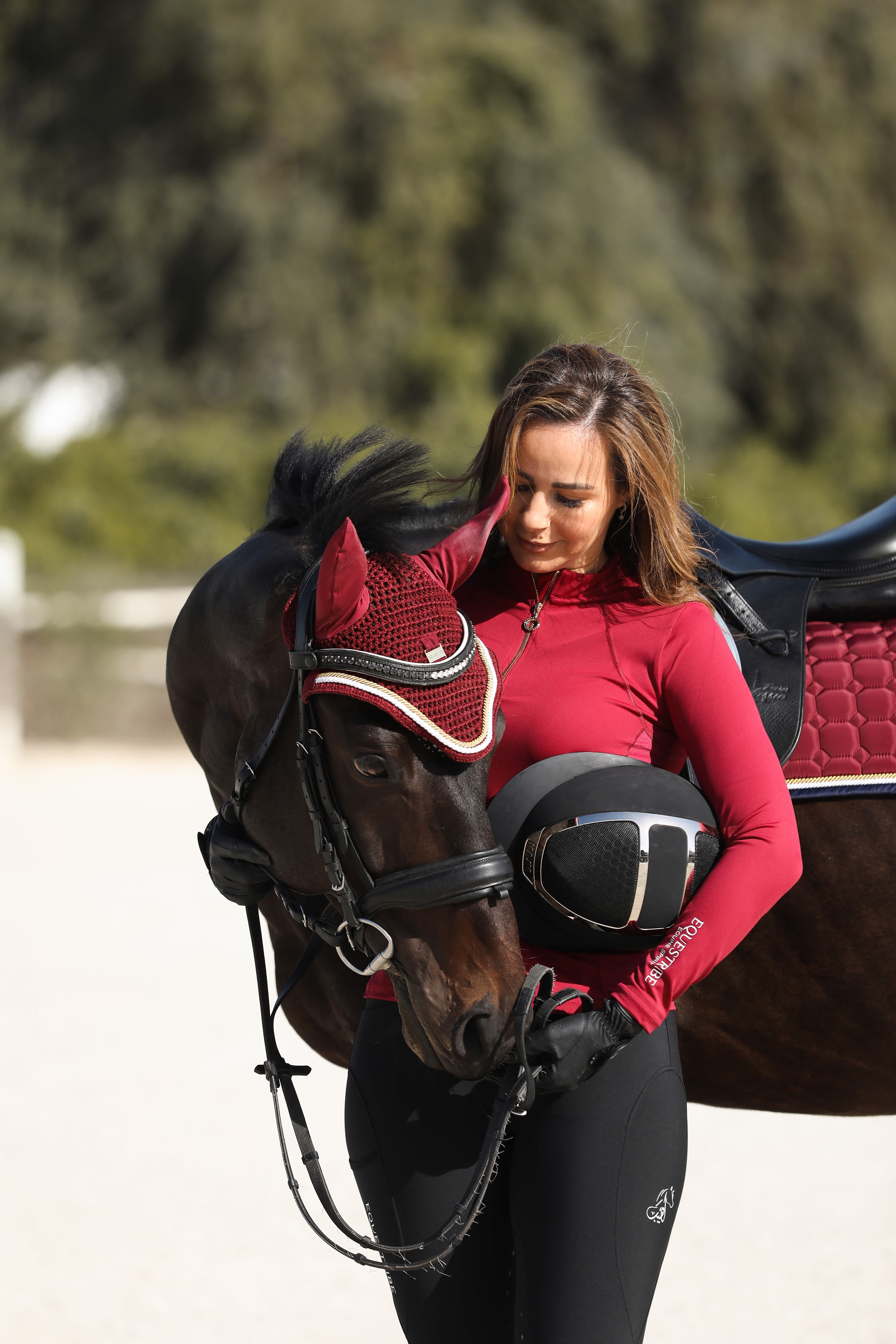
The brand's Crushed Berry colourway
The brand's Crushed Berry colourway
As well as being cooling, the fabric needs to protect the rider from the sun, yet be sturdy enough to withstand rigorous use. To find this delicate balance, Mayr and her team puts everything through extensive testing to ensure every item on the website is up to the job. “We invested more than 14 months in research,” she explains.
Thanks to her knowledge of the region, Mayr has also been able to create specialist items, so that alongside the various cuts of tops and breeches, Esquestribe offers a technical abaya that reaches to the ankle, and a tunic that gives the rider proper coverage, even when raised out of the saddle.
Making her brand inclusive was a no-brainer for Mayr. “Starting from the designs all the way to the fabrics, my mission was to enable riders to express their individuality.”
With a big rise in the number of women taking up riding, Mayr has watched with delight as much of that uptake has come from the local community. “Over the past few years, women across the region have been revolutionising the equestrian scene, and across the GCC, the percentage of female riders in the local community has been growing consistently.
“Today, we see many female athletes proudly represent their countries, competing in big tournaments or following their passion for the horse sport, while maintaining their modesty.”
Alongside women’s base layers, T-shirts and leggings, Equestribe offers saddle pads for both dressage and jumping, wraps and even ear nets, all in the same colours as the clothes. Jaunty shades include crushed berry, jungle drums and the wonderful sounding scuba-aruba (which, for the record, is a pale mint green), and Mayr promises more colours will be added. The launch range of 50 products is almost exclusively aimed at women, save for a lone pair of breeches for men, and is just the start, to test the waters and gauge consumer reactions.
Mayr is actively inviting feedback, so Equestribe can evolve to offer products her customers want and need. “From the first sketches to the actual moment of production, we invested more than 18 months in the design and trial phase. The result is an exceptional, unique brand with collections that can be taken from yard to competition.”
Essential technology
Selina Denman presents a selection of must-have gadgets, from a nature-inspired air purifier to a self-charging smart watch
Briiv
Air purifiers may be all the rage in our pandemic-ridden times, but Briiv does the job as nature intended. Crafted from 90 per cent natural and renewable materials, Briiv consists of three fully biodegradable filters that utilise the natural microstructures of moss, coconut, carbon and silk to filter air. Additional components are made from elephant grass, hemp and reusable glass, so Briiv uses less plastic than any other air purifier on the market. It combats the tiny particles and harmful gases that are released into your home every time you cook, light candles, use cleaning products or even play with your pets, creating cleaner, safer homes by harnessing the power of nature. The compact, aesthetically pleasing device is the equivalent of having more than 3,000 medium-sized house plants in your home, just much easier to maintain.
Beoplay EX
Promising “deep sound and snug comfort in one sleek package”, Beoplay EX is Bang & Olufsen’s most versatile wireless earphone to date. Offering a combination of performance and style, the earphones have a new ergonomic stem-based shape with a housing that’s smaller than ever, to ensure a comfortable and stable fit. They sit snug on the ear and will stay put whether you are walking, running or jumping around. A mirror-like glass intercase is encased in a brushed aluminium ring, with three colour options on offer: black anthracite, opulent gold or anthracite oxygen. Inside is a 9.2 millimetre speaker drive, Adaptive Active Noise Cancellation technology and three microphones. If you do want to let the rest of the world in, you can opt for Transparency Mode. Dust and sand-resistant and water and sweat-proof, the Beoplay EX offers up to 20 hours of play time.
Tile Pro
If you are prone to misplacing your belongings, you need the Tile Pro in your life. The latest addition to the Tile family of Bluetooth trackers has a new streamlined shape that hangs better on keys, backpacks, purses and anything else you need to keep track of. The Tiles connect to Android or Apple devices, with a range of up to 120 metres – you just need to open the free app and tap “find” to locate them, or ask Alexa or Google Assistant to do it for you. The device will emit a sound when in range. When out of range, you’ll be able to view its most recent location on a map. And vice versa – you can press the button on your Tile app to make your phone ring, should you misplace that instead.
$34.99, www.thetileapp.com
Dyson Airwrap
The next generation Dyson Airwrap multi-styler has arrived in the UAE, bringing new and re-engineered attachments, as well as an enhancement of the brand’s signature Coanda effect, which eliminates the need for extreme heat in the drying process. New styling barrels feature a rotating cooling tip, creating curls faster and more easily, while reimagined brush attachments deliver precision shaping alongside a new dual-purpose Coanda smoothing dryer. There is also a wide-toothed comb attachment, engineered for curly and coiled hair, which adds shape, volume and length as it dries.
Sequent Elektron
Many a smart watch ends up unused as owners tire of the need to constantly charge them. Which is why Swiss start-up Sequent launched the world’s first watches that are self-charging, transforming body movement into electrical power in a process the company refers to as “smart micro energy harvesting”. New from the brand this year is the Elektron, the world’s first smart self-charging watch made from titanium. The matte black watch face features solar-powered indexes that glow in the dark, giving the dial a futuristic feel. It offers activity and sports tracking, as well as distance, heart rate, sleep and blood oxygen monitoring, and is compatible with iOS and Android. There are six variations, including a white Nasa version and an option made from Tide, a raw material crafted from upcycled ocean plastic. Sequent is also a sustainable choice as it partners with myClimate, a Swiss climate protection foundation, to offset 10 times the amount of carbon generated during the production of each of its watches.
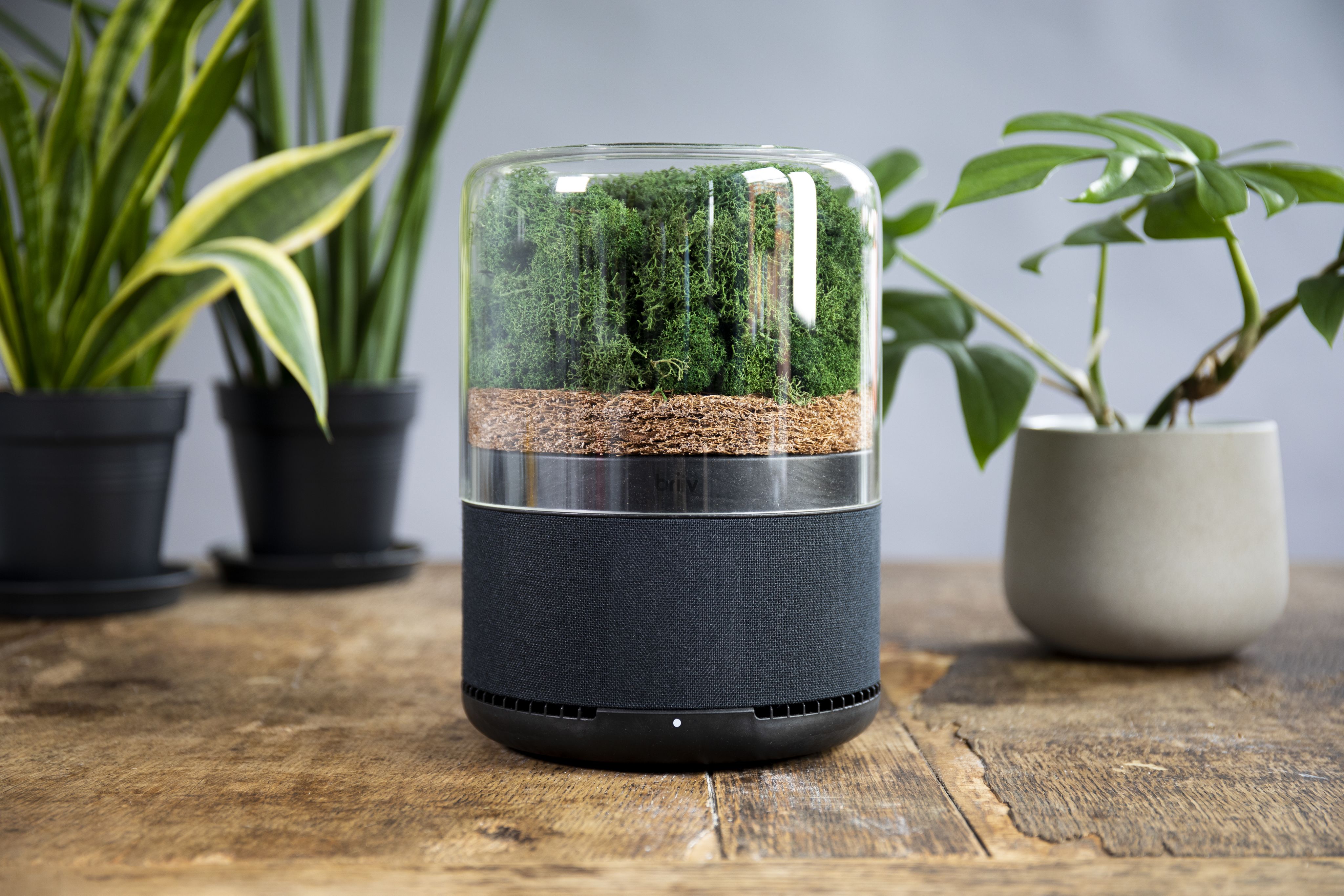
$372, www.briiv.co.uk
$372, www.briiv.co.uk
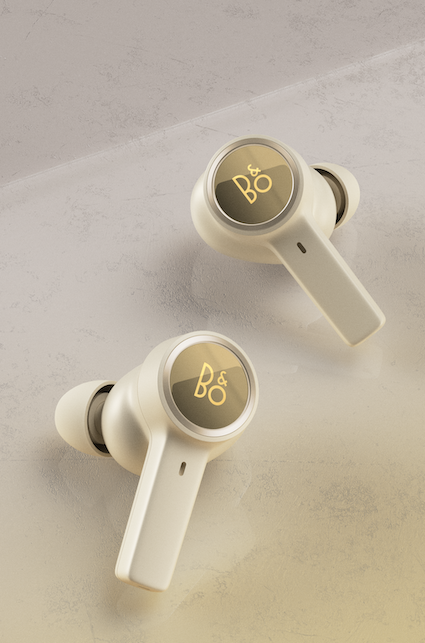
$399, www.bang-olufsen.com
$399, www.bang-olufsen.com

$34.99, www.thetileapp.com
$34.99, www.thetileapp.com
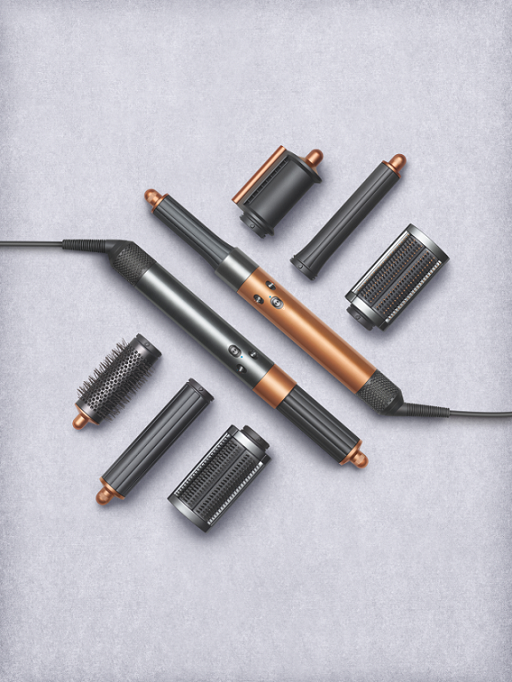
Dh2,249, www.dyson.ae
Dh2,249, www.dyson.ae
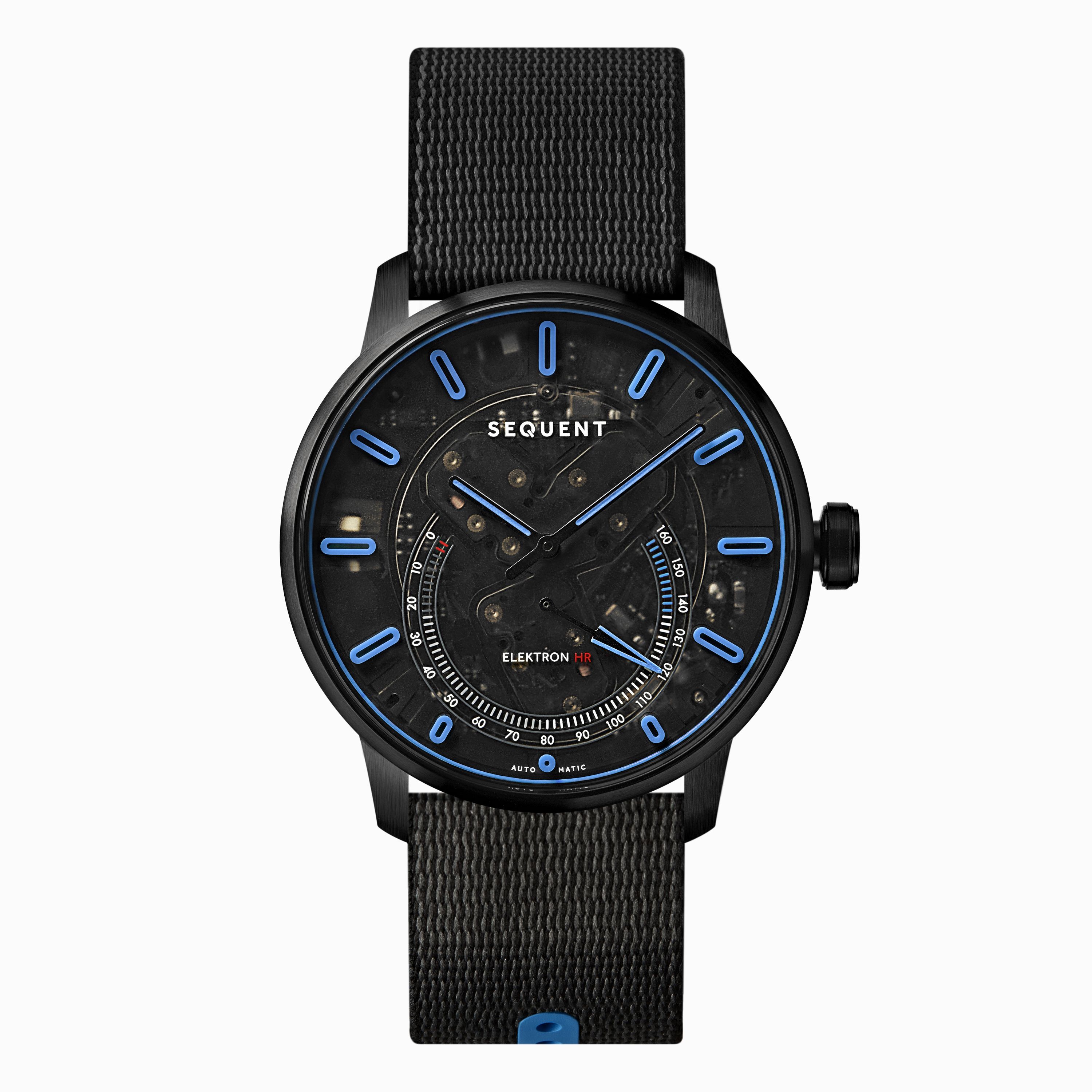
Starting from $617, www.sequentworld.com
Starting from $617, www.sequentworld.com
$1,785...
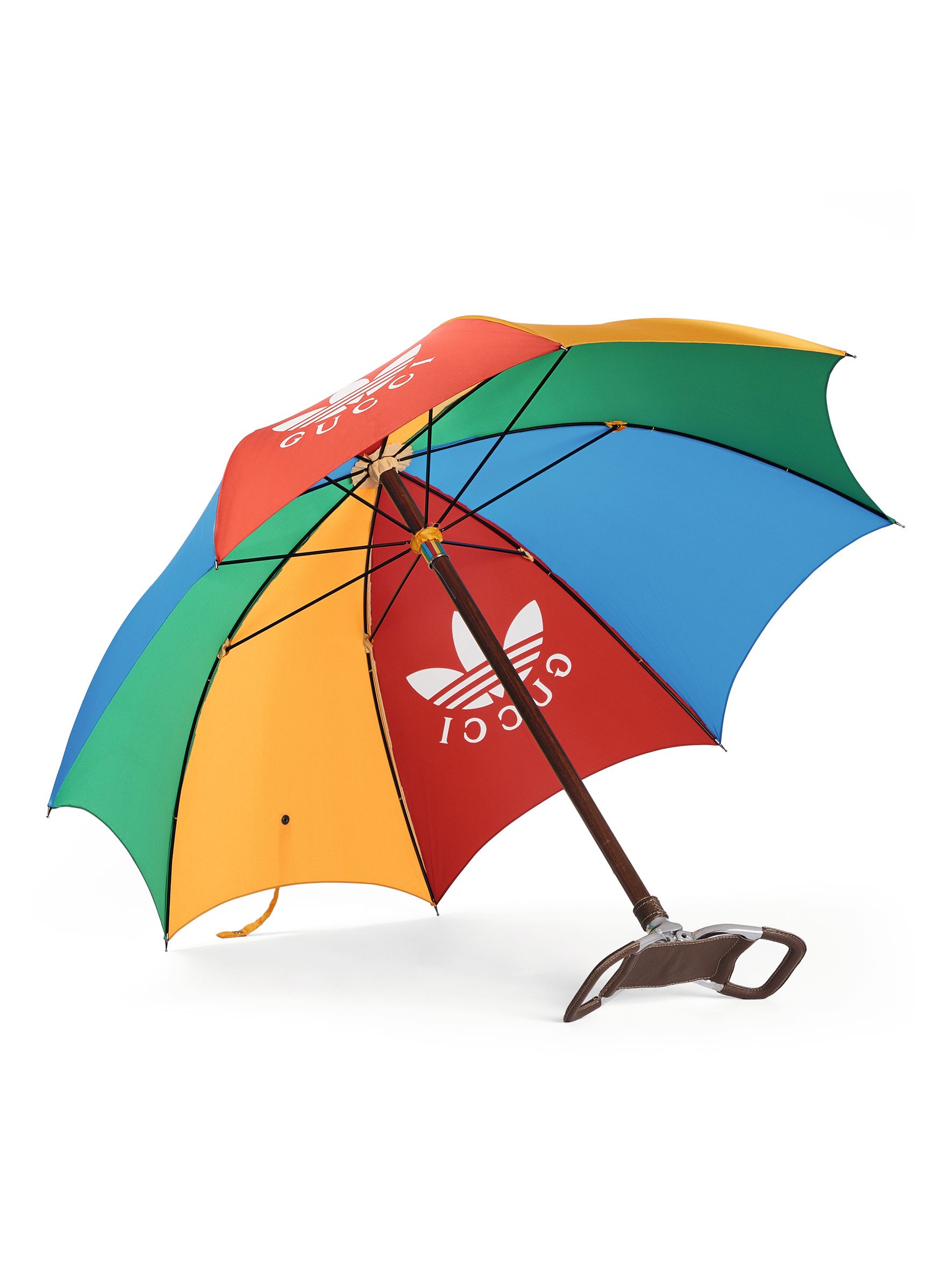
... is the price of this umbrella, part of the new Gucci x adidas collection
Fresh from the success of its tie-ups with The North Face and Balenciaga, Gucci has launched a collaboration with sportswear brand adidas. First glimpsed at the Gucci autumn/winter 2022 fashion show, the collection was officially released on June 7.
Gucci’s creative director Alessandro Michele, a long-time fan who apparently collects adidas Gazelle trainers, has lovingly reworked pieces from both sides of the equation. Vintage-style adidas zip-through jackets and tracksuits have been uplifted with Gucci motifs, while the Gucci logo has been melded with the adidas trefoil motif across various surfaces, with a joyous 1970s feel.
As with everything Michele touches, the collection is fun and playful, in a kaleidoscope of colours such as green, pink, red, yellow, blue and even turquoise satin. There are retro-style tracksuits; logo-ed, zip-through jackets; high-waisted, second-skin shorts; pencil skirts; bell-bottoms; and bucket hats.
A highlight is this eye-catching, multi-hued umbrella, which features a combination of the Gucci and trefoil logos emblazoned across two sides. Made in Italy out of wood and nylon, the eight-ribbed umbrella is a bold riot of block hues, with red, orange, green, yellow and blue sections sitting side by side in a rainbow of colour. You certainly won’t get lost in the crowd, no matter how dreary the weather. And the handle also opens up to form a mini seat – a little something to balance on if you make an impromptu stop.
